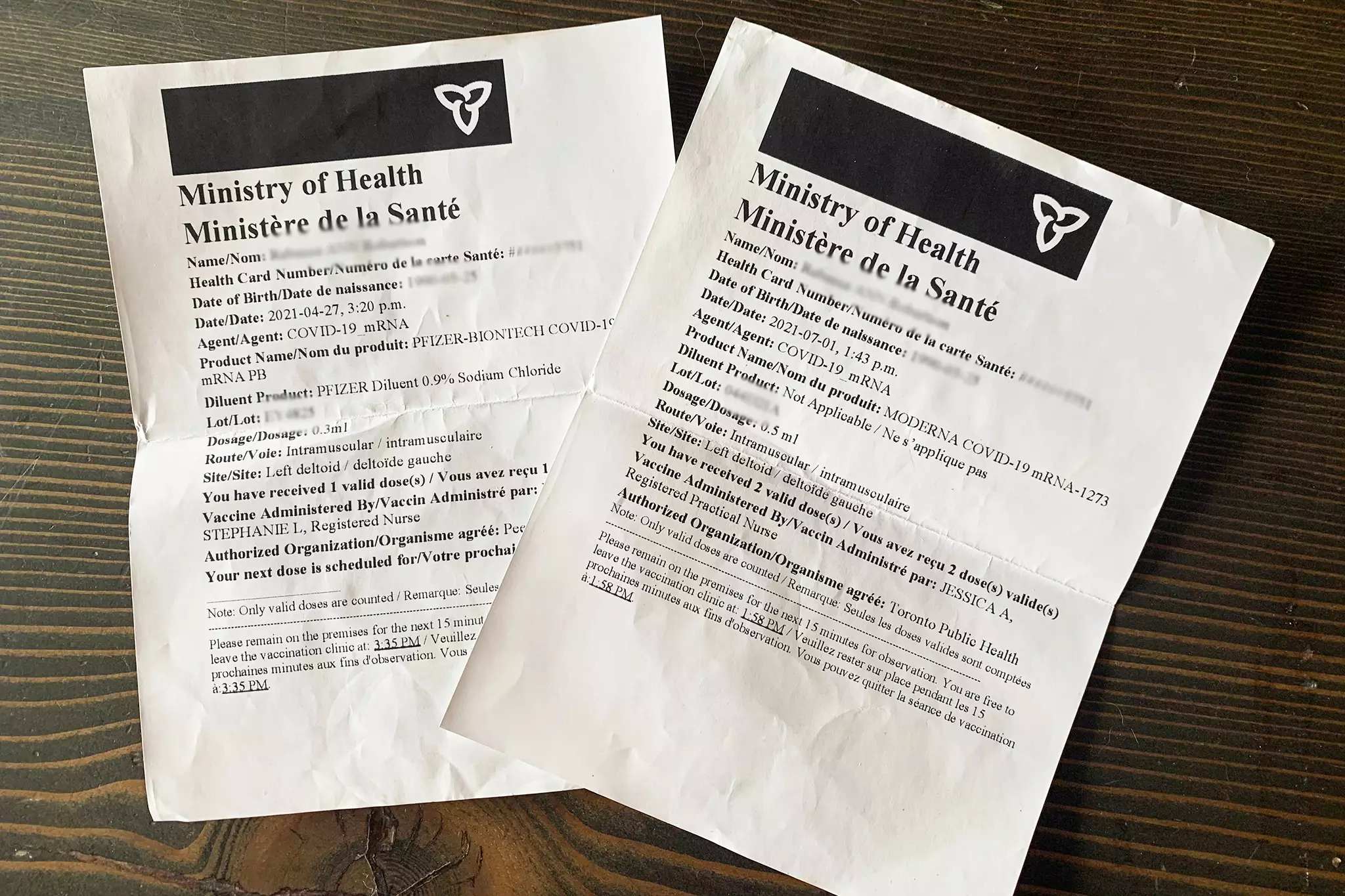The 2023 Trans-Europa Cycling Tour finished in the shadow of the Rock of Gibraltar just a couple months ago and the lucky riders who rode all, or part, of the way from Talliin, Estonia across 11 European countries had a wonderful journey.
The 2025 Trans-Europa is now open for registration. The 2023 ride sold out early so don’t delay…sign up for this unique transcontinental cycling adventure and start dreaming of pedalling across Europe.

“I was satisfied, delighted, fulfilled, full… tired! My eyes, my mind, my legs loved it!” – Stéphane Lancereau (France)

“Perfect way to visit new countries, visit touristic and less touristic spots. socialize with fellow riders and all by bike 🙂 What’s not to like?” – Remmelt Van der wal (Netherlands)

“Cycling the TransEuropa is a mind blowing experience. Challenging, but so rewarding.“- Julie Richert (USA)
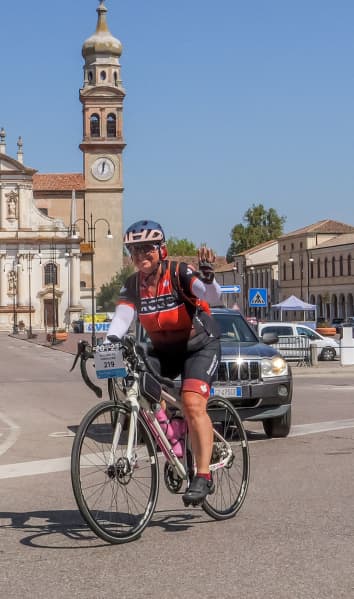
“Thoroughly enjoyed the staff, friendliness of other riders and the challenge of riding the mountains.” – Susan Silcox (Canada)

“Loved the route and the excellent planning.” – Wayne Grover (Canada)

“The food and scenery were amazing. It is an experience I will never forget and I hope to do something like this again soon.” – Robin Locken (Canada)
RELATED
TOUR
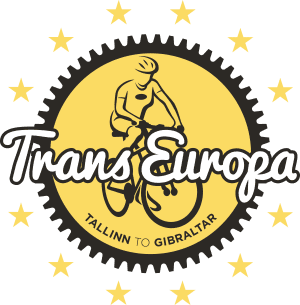
Trans-Europa
Join us on this spectacular 2 1/2 month cycling adventure across Europe. The route passes through eleven countries, starting in Tallinn and finishing...
]]>
Ethan Weil was the Content Creator on the 2023 Trans-Europa Cycling Tour. He sends his final report from Gibraltar.
We have just finished the 2023 Trans-Europa Cycling Tour. It was quite the journey, filled with epic landscapes, historic cities, incredible food, fascinating history and lasting friendships! It was an emotional moment, turning the final corner that revealed the 426 m (1,398 ft) limestone Rock of Gibraltar, the finish line for this 2 1/2 month ride across Europe. The end of a tour can be a flurry of emotions – excitement, gratitude, contentment. There is even a slight bittersweet feeling in the air as the riders prepare to transition from such an adventure back into their daily lives all around the world. The connections made during the tour can develop into lifelong friendships and result in a wonderful network of cycling crazed personalities from all over the world.

Arriving in Gibraltar felt like a perfect way to finish the tour. As we got closer to the British overseas territory we enjoyed our last moments in Spain before crossing the border…where we even had to cycle across the airport runway. It is a truly unique experience. Where else can you bike on an active airport landing strip?! It provided us with a great view of the famous rock with the skyscrapers below providing a unique perspective. Cycling through the town, we soon arrived at our hotel for a sip of bubbly to celebrate the end of the tour!
As the last few days on this tour are a mix of celebration and a scramble of bike boxing logistics, I highly recommend staying for a few days to relax, reflect on the experience and explore the surrounding area. Gibraltar, although a small place, is packed with things to do! We stayed at The Rock Hotel, a beautiful historical hotel with a luxurious art deco aesthetic, perched on the western face of the Rock. The rooms have balcony views overlooking the Bay of Gibraltar where barges, cargo ships, sail boats and military vessels can be seen sailing in and out of the Mediterranean Sea.
Great sunset views can be enjoyed and once the sun dips down below the horizon, the city lights take over. You can see lights from Gibraltar, Spain, and even Morocco out in the distance to the south. On clear days one will be able to see the African continent during the day from the southern beaches or from the top of the viewpoints around Gibraltar. If you’re looking for a relaxing activity, just below the hotel is the Botanical Garden of Gibraltar where it is free for the public to walk around and enjoy all the unique flora.

A trip up to the top of the Rock is an excellent idea as there are plenty of activities up there. As it is quite a steep hike to the top, there is a cable car that will take you up quickly and efficiently. There are also tour vehicles that can take you to all the sites around the Rock. One guide I can recommend is my taxi driver, Alan, who runs Guided Rock Tours. He’s a longtime local and passionate about showing his home to visitors. Whether you choose to walk up, take the cable car, or a tour van, once on the Rock you can enjoy the great views of the surrounding area. Across the bay you can see the Spanish city of Algeciras. If you have multiple days to spend in the area, you can consider booking a ferry ride from Port Algeciras to Morocco, about an hour ferry ride one way.

The highlights to see on the Rock start with Europe’s only monkey population, the Barbary Macaques. They are fun to watch but be aware that they have been known to be little thieves, snagging phones, food, bags and other miscellaneous items. After visiting the Macaques, I suggest making your way to see St. Michaels Cave. I knew very little about what to expect and was blown away by its incredible cave system. Large stalagmites create columns around the cave and there is a light show that is projected onto the cave walls every seven minutes. From the top of the Rock you can also explore World War Two bunkers to learn about the military history of the area. If you get hungry or fancy a drink, there is a restaurant there where you can enjoy the views and relax before taking the cable car back down.

Gibraltar is a special and unique destination and makes for an action-packed ending for the tour. It is a great place to unwind, explore with fellow riders and reflect on the tour. It was heartwarming being able to hear everyone’s exciting and memorable moments from the ride alongside with what plans they have for the future.
RELATED
TOUR

Trans-Europa
Join us on this spectacular 2 1/2 month cycling adventure across Europe. The route passes through eleven countries, starting in Tallinn and finishing...
]]>
Ethan Weil is the Content Creator on the 2023 Trans-Europa Cycling Tour. He reports on the Spanish city of Valencia, where the riders enjoyed a well-deserved rest day.
“I believe this is my favourite city on tour so far!” – Geoff Bailey
The comforting golden hue of the sun reflected off the ornate architecture in the last few hours of daylight. We had just arrived in Valencia and I was speechless at just how beautiful the city was! Gorgeous architecture lurked around every twist and turn, every detail was well thought out and perfectly placed. Not one building was remotely the same. Thankfully, we had a rest day to explore the city and after talking to a few other riders on tour I’m not the only one that fell in love with the city of Valencia!

Font de la Plaça de I’Ajuntament
It has to be one of the most charming cities in Spain, if not the world. It’s blessed with balmy weather year-round and is surrounded by a line of beaches with Blue Flag status – Cabanyal, Malvarrosa and Arbre del Gos. This rating guarantees the quality of the water, the sand, and ensures respect for the environment. With impressive architecture, both old and new, the city rivals any other when it comes to the arts and design. Santiago Calatrava, a famous architect and Valencian native, designed many of the buildings within the city such as the Queen Sofia Palace of Arts, Hemisfèric (IMAX Theater & 3D Cinema), Museu de les Ciències Príncipe Felipe (Science Museum), Agora (Cultural Center) and L’Umbracle Sculpture Garden. He was also responsible for such notable buildings around the world like the World Trade Center in New York and the Creek Tower in Dubai. Valencia, home to hundreds of brilliant architectural creations, was named World Design Capital of the world in 2022.

Santiago Calatrava Architectural Designs
Founded by the Romans, Valencia’s history spans over 2,000 years. As one of the oldest cities in Spain its strategic location in the Mediterranean has made it a vital asset to the country. I was surprised to learn that its port is now the main economic driver and influencer within the region of Western Mediterranean and is the most efficient port in southern Europe.
Now, let’s talk food! More specifically, the delectable dish, paella! One of the most well known, if not the most famous dish in Spanish cuisine, it’s a rice dish that originated in Valencia. There is even a tournament – World Paella Day – where they celebrate the dish and Valencian culture and host a global competition to see who can make the world’s most delicious paella! Last year’s winner took home the cup representing France and this year the competition is taking place on September 20th.

Iberian ham paella
There are many great places in Valencia to get paella and you simply can’t go wrong with choosing one or another. I can personally recommend the restaurant at the base of the Queen Sofia Palace of the Arts – Restaurante Contrapunto Les Arts – for for a lunch paella. It opens at noon but doesn’t serve food until 13:30. What makes this place special is that you get to eat and drink on the outside patio surrounded by the decorative waters that line the beautiful architecture created by the Santiago Calatrava. I ordered a coffee to start before having the Carne Paella which came with Iberian ham
Overall, the food and drink scene in Valencia is simply fantastic! Moving beyond paella, the city has all the gastronomic choice that your heart could desire. On the night we arrived in Valencia, I joined rider Ming-Jiing for dinner at a Chinese restaurant called Min Dou. Ming revealed that the reason we went is that, “Sometimes I miss the food I have at home and so on rest days I look for a good Chinese restaurant to go to.” It was a great meal and I got to experience a part of the city that I wouldn’t have otherwise visited.
I strongly suggest spending a morning sitting outside at a local cafe, enjoying the early activities of the day and taking in the surroundings. In the evening, if you fancy a drink, feel free to explore the multitude of bars and restaurants scattered around the city. Valencia breaths anew at night as people walk around, relax in parks and meet up with friends and family . The local cocktail of Valencia is Agua de Valencia. The ingredients include cava or champagne as a base, orange juice, and vodka and gin. If you want a rooftop viewing experience, particularly of the Queen Sofia Palace of Arts, visit the 270º Terrace at Barceló but be aware that it can fill up quickly. Arrive early or make a reservation in advance in order to enjoy the view Valencia from above!

Mercado Central
Another notable highlight in Valencia is the Mercado Central Market. It is the largest fresh produce market in all of Europe with 1200 stalls serving fresh fruits and vegetables in a beautifully decorated building with Art Nouveau design.
Valencia truly has something for everyone of all ages and backgrounds. From festivals to operas, from art festivals to sporting events, there is always something going on. While staying for only a day makes it difficult to see everything, I hope you took something away from this little piece on Valencia and you can get out there to explore it for yourself.
RELATED
TOUR

Trans-Europa
Join us on this spectacular 2 1/2 month cycling adventure across Europe. The route passes through eleven countries, starting in Tallinn and finishing...
]]>
Ethan Weil is the Content Creator on the 2023 Trans-Europa Cycling Tour. He sends this report on Slovenia and its amazing highlights.
There is, tucked away in Central Europe, an absolute hidden gem, perfect for all outdoor enthusiasts to visit. I’m talking about the beautiful country of Slovenia. It features an outdoor centric culture, an attitude to rival any others, and it shows through the records achieved, the events held, and the conservation efforts on display throughout the country. For winter sports, water sports and mountain sports, it’s truly an outdoor adventurer’s dream. I got to witness first hand the incredible beauty that Slovenia has to offer as our tour, the Trans-Europa, cycled through the country!
Putting the LOVE in sLOVEnia

The capital city, Ljubljana, translates to ‘Beloved’, fitting in many ways as it has a sustainable mindset in its development with green spaces both in the heart of the city and the surrounding areas. It is a educational experience walking around the city, as in other Slovenian cities, as the streets and parks are spotless due to a sophisticated garbage system that has separate bins for glass, packaging, paper, residual waste and organic waste. Not only that but there are also numerous street sweepers and a community outlook that cares for the city and the surrounding nature.
One thing that is immediately noticeable once you enter the country are the lush green forests. That’s because Slovenia makes it a priority to protect and conserve the natural environment. About 60% of the country is covered by forests and overall about 41% of all Slovenian territory is protected through conservation.
The Adventurous Spirit

While we were cycling through the country I made it my goal to explore and highlight the outdoor culture of Slovenia as well as to show what one can do while having a rest day in Ljubljana.
Outdoor activities in Slovenia seem to be endless! Want to rock climb under a castle? You got it! Want to cycle in a cave? Can do! Want to paraglide off a mountain and see the landscape from an adrenaline-rushing, bird’s eye view? You betcha! With a mountainous landscape that runs down the sea, there’s a tremendous amount of activities to choose from: climbing, mountaineering, hiking, cycling, mountain biking, rowing, kayaking, parachuting, canyoneering and caving. It’s no wonder that Slovenians have a deep love for the outdoors and with that, excel in a multitude of sports.
Many notable Slovenian names have achieved great things within the sporting world. When it pertains to cycling, one can’t help but mention the two-time winner of the Tour de France, Tadej Pogačar, who became the second youngest cyclist to win the prestigious race at the age of 21 years old. As a result, a growing cycling community can be seen whilst traveling through the country. There’s Primož Roglič, a former ski jumper turned world class cyclist, Janja Garnbret, a sport climber who is the first in the history of the sport to win the Olympic gold. and Alenka Artnik, a world record holder in free-diving. There are many other Slovenian athletes in sports like rowing, basketball, hockey, motocross, alpine mountaineering and many more.
Many unique outdoor events have been, and are being held, in Slovenia such as the Red Bull sponsored climb where two adventurers scaled the Trbovlje chimney, the highest flue-gas stack in Europe, standing 360 meters high. A popular film of this was subsequently made – the 360 Ascent. The 2023 European rowing championship were held in May at Lake Bled, a picturesque location nestled in the mountains just 55 kilometres from the capital.
So why tell you all this? Well it goes to show just how important the world of sports and recreation is to Slovenians and the country as a whole. Even the hotel we stayed at in the capital was broadcasting climbing competitions. What to do on the rest day in Ljubljana

It’s the age-old question on TDA tours – what to do on rest days? Sometimes they aren’t always restful as many riders choose to explore the town or city they’re in to see what it has to offer. From restaurants, tours, history, museums and more, there’s a little something for everyone on Slovenian rest days, especially whilst in Ljubljana. I talked with rider Nancy to see what she was going to do in Ljubljana and she noted, “I’m going to do a food tour as it’s a great way to meet new people and try local foods from the area you’re in! Sometimes it’s too much food.” I found this to be a great way to spend the time on a rest day as it’s a way to culturally immerse yourself along with meeting others who have a similar interest as you.
Things to do around the city are abundant. There are many cafes, restaurants and things to do within walking distance, along with just wandering aimlessly within the city. One can visit the Mesarski Bridge which has a bunch of love padlocks lining the rails but what is notable are the restaurants nearby. Riders Greg and Eve enjoyed eating by the canal right next to the bridge and have been back twice since they arrived in the city. Another thing to do would be to visit the castle that is in the heart of the city as it can be a good viewpoint from above. Otherwise, the castle in the Slovenian city of Celje is much more interesting to visit.
My Ljubljana Rest Day Suggestion

If you’re looking for a bit more of an active rest day while in Ljubljana, I have a couple of suggestions for you! While in the city, Michael Coo from the Toronto office had joined the tour and together we decided to wake up early at 6am to head to Lake Bled. I suggest visiting in the early morning to beat the traffic as well as to witness the stunning morning sunlight. It is an absolute fairytale of a lake to visit, as it has an island in the centre of the lake with a church built on it and a castle overlooking the surrounding beautiful landscape. There are a ton of activities to do around the lake and it’s only about 55 kilometres from Ljubljana. A bus ride from the city centre will take you straight here, taking about an hour to an hour and a half to reach the lake.
You can hire a wooden paddle boat called a ‘pletna’ which means ‘flat-bottomed boat’ which can take you out the island to walk around. I highly recommend this. It’s a pleasant and smooth ride as the boat doesn’t have a motor so all you hear is the chatter of your fellow boat passengers, the splash of the paddles and the occasional church bell. We got lucky and were able to watch paragliders sailing off the nearby mountains and over the lake as we traveled to the island which added to the overall adventurous atmosphere. Beyond the pletnas there are other ways to reach the island. One can rent a stand-up paddle board (SUP), kayak, or even swim to the island. From there visitors can enjoy a drink at the cafe, a little walk around the island’s edges or even scuba diving. There are plenty of large fish that feed near the shores of the island and can easily be seen through the crystal clear turquoise waters.
To reach the nearby castle requires a walk up quite a few stairs but the views make it all worthwhile! There’s a great exhibit about the castle which also includes history of the surrounding area. Worth some time to check it out. Once one feels they’ve seen enough of Lake Bled, it is time to head back to Ljubljana to rest or do laundry if needed. As it gets closer to sunset and the city lights come on, I suggest a stroll in the city. With restaurants opening up along the canal and people wandering through the street, the city comes to life.
If you’re looking for an alternative active rest day to Lake Bled, I would suggest booking a cycle tour through a cave. Slovenia is known to have over 10,000 caves and in a few of them, bike rides are offered, ranging from leisure rides to more technical riding. These companies can give you a ride from Ljubljana to the tour’s starting point.
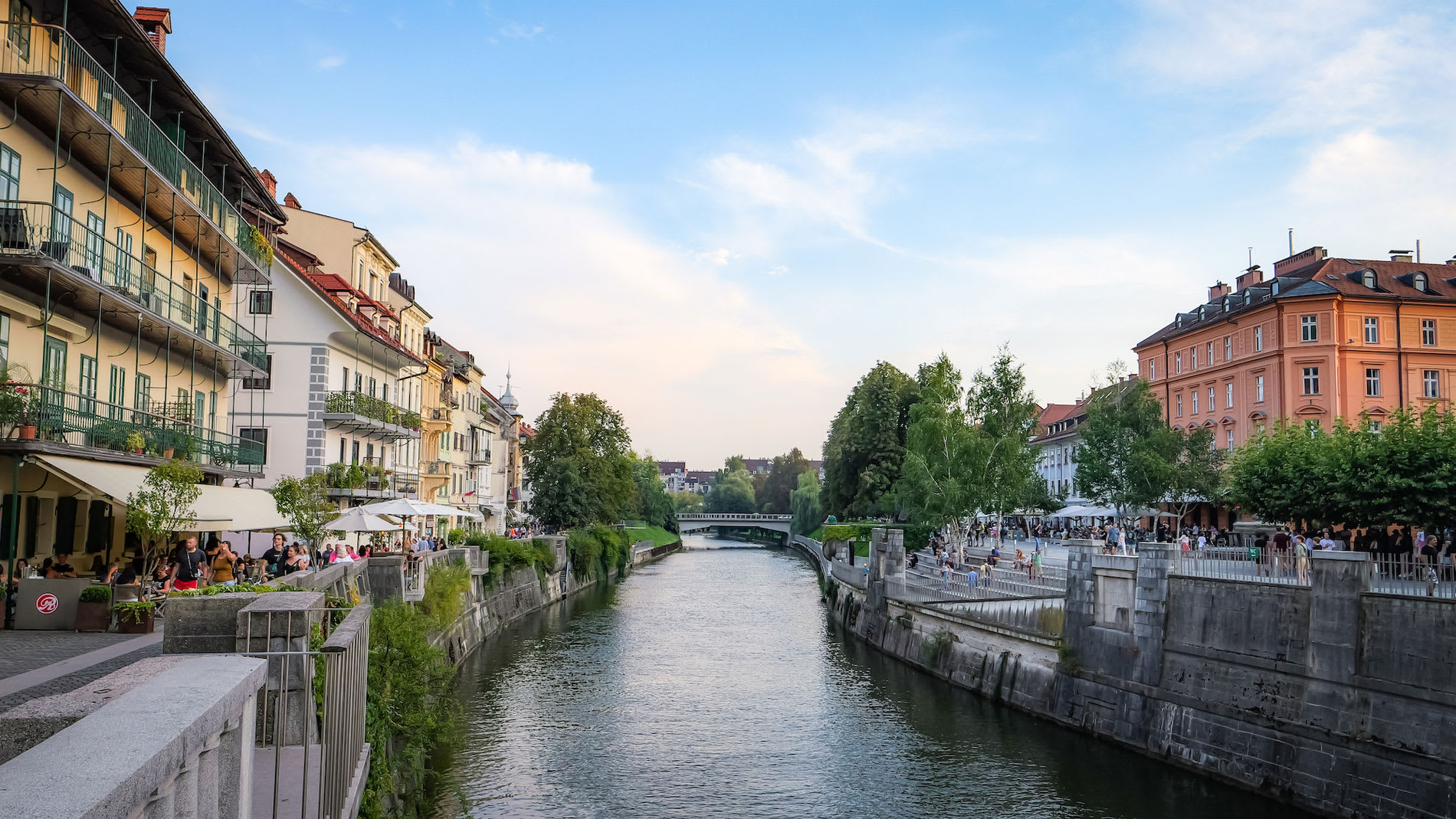
Overall there are so many things to do while staying in the capital city of Slovenia. It is truly is an outdoor centric nation and as the world takes notice of this small European gem, it is evident that Slovenia’s passion for sports will continue to inspire and to build on a legacy of athletic achievement. I hope this has helped foster some ideas of what to do while visiting the country of Slovenia and its largest city, Ljubljana, while on tour!
RELATED
TOUR

Trans-Europa
Join us on this spectacular 2 1/2 month cycling adventure across Europe. The route passes through eleven countries, starting in Tallinn and finishing...
]]>
I was lucky enough to join the 2023 Trans-Europa Cycling Tour in Budapest for the beautiful 2 week stretch to Venice. After a few days, some of the riders asked when I was going to cycle. After a few more days, more riders chimed in so…
I decided that I would ride the stage out of Ljubljana, Slovenia. I checked out the figures and it looked doable, although perhaps a bit of a stretch for someone at home who rides his bike to the farmer’s market and the local brewery. The 92.8 km included 1031 m of climbing which didn’t sound too bad at the time.
I woke up early on my cycling day and got myself ready.

In my hotel room in Ljubljana, ready for the ride

Cycling shoes…check…

My borrowed bike…check…
After a hearty breakfast at out hotel, I headed off, trying my best to hear the GPS instructions above the sound of the traffic. Fortunately, I was riding with Odessa, one of our Tour Leader Trainees, so I essentially followed her out of the city. Lots of bike lanes and very respectful drivers. I felt good. A little surprised given my last stage on a bike during one of our tours was on the Bamboo Road in 2015.

Once outside Ljubljana, we stopped to refill our water bottles and one of the many free fountains along the road. If you prefer milk to quench your thirst, you will love Slovenia. They have these roadside machines – Miekomats. Modern vending milk dispensers they usually can be found near a local dairy farm. Made of stainless steel, they are self cleaning and you can bring your own vessel to drink out of or they will provide a PET bottle. Ice-cold and very fresh. The farmers continuously replenish the milk.
The first of 2 projected climbs of the stage began. A long steady 5 km climb up into the hills. We stopped to pee at the summit and to learn about the threat of African Swine Flu to the local domestic pigs and wild boar. I felt great. This was going to be fun.

We enjoyed spinning along the beautiful back roads checking out the numerous beehives (Slovenia is famous for its honey) that dotted the forest and making great time to lunch, scheduled for about the 46 km mark.

We stopped at the bottom of a hill and checked our location. According to RideWith GPS, we were already 3 km into our 11 km climb to the summit of the pass. Nice! I told Odessa to go ahead. Lunch was just 8 km away and there was only one road. No problem.

The road to the top
I pedalled off and then the pain began. The climb was relentless. Every time I struggled through a corner, another slope presented itself. I started taking breaks. Lots of breaks. My initial projected lunch arrival time fell by the wayside. At one particularly low point, I turned a corner and the incline ahead looked so steep, I gave in, hopped off my bike and walked.

Finally, behind everyone else, I pulled into our lunch stop. Exhausted but also a little bit proud of myself despite the brief walk with the bike.

And then…the reward. An absolutely incredible 17 km downhill towards Italy. Immediately after we crossed the pass, everything changed.

For one thing I wasn’t swearing anymore but the views were spectacular and the flora immediately changed. Cacti appeared as did a number of palm trees. And the vineyards! Slovenia had quite a few but in Italy, it is a whole different ballgame!

The downhill finally came to an end (rats) and we eventually pulled into our hotel, the traditional TDA flagging tape marking the end of my return to cycling on the Trans-Europa.

Respect to all the riders on the 2023 Trans-Europa! My ride taught me just how much effort and determination you put in each and every day.
A big shout out to Odessa for hanging back with me and encouraging me to finish the stage.
RELATED
TOUR

Trans-Europa
Join us on this spectacular 2 1/2 month cycling adventure across Europe. The route passes through eleven countries, starting in Tallinn and finishing...
]]>
Keszthely is a small Hungarian town of about 20,000 souls perched at the end of the country’s largest body of water, Lake Balaton, and is an overnight stop on our Trans-Europa Cycling Tour. Have you ever heard of it? I certainly hadn’t.
Paris might have the Louvre, the Musée d’Orsay and the Palace at Versailles but it ain’t got nothing on this town!
Model Railway Museum

My first stop was the incredible model train museum. It brought back many memories as during my childhood in Montreal, my father had transformed the entire basement of our house into a model train layout, much to my mother’s chagrin! I loved it. This layout is one of the largest in the world – the tracks total almost 3 kms in length, there are over 1000 buildings, 20 stations and 80 individual trains operating at once.
Radio & Television Museum

Next up was the Radio and Television Museum. No flatscreens here! I remember trying so hard to get those metal rabbit ears to stay at the perfect angle so that the screen wasn’t full of ‘snow’ during Saturday morning cartoons. TVs and radios have certainly come a long way but there is a certain charm about some of the retro designs on display here.
Doll Museum

If you have ever watched, even through your fingers, the movies Chucky or Annebelle, you may want to consider bringing a few friends with you as you explore the 3 floors of dolls in this museum. One doll always seems so harmless but throw hundreds of them together in glass cases and add in some creaky wooden floors? Creepy!
Snail Shell Parliament Museum

Say you have 4.5 million snail shells hanging around? And not much to do for the next 14 years? To paraphrase Mary Oliver, “What would you do with your one wild and precious life?” Well, one woman spent it using the snail shells to make a 7 m x 2.5 m scale model of the iconic Hungarian Parliament buildings, proving once again that the line between genius and madness is a thin one.
Museum Of Historical Wax Figures

Down a set of rickety stairs, you will find a collection of wax figures. First up is a large array of creepy nuns. Once you run that gauntlet, you emerge into a musty space where Hungary’s historical figures reside in waxen majesty. They run from the leader of the original Hungarian tribes, Arpad, to the country’s first King, Saint Stephen.
Torture Museum

Have you ever wondered about the most painful ways to be tortured? Well, the answers may lie here in this dark museum room. Reading the above methods, my thirst immediately disappeared. Additional tortures included the having people eaten alive by insects (sounds like camping in Canada), making people become rotten while still alive and the always popular, making people swallow a string!
Nostalgia Museum

Some people may be accused of living in the past. In this museum, you can join them. It contains an amazing collection of everyday items from dishes to typewriters to posters to bicycles and pretty much everything in between. Weirdly, the store slogan is, “Whoever enters here, abandon all hope.”
Toy Museum

The Toy Museum is a truly incredible collection. Remember those plastic army figures you used to play with? They have a whole display of them. Toy cars, constructions sets, board games and even more dolls (must have escaped from the Doll Museum). Just about anything you might have played with as a child can be found here.
Erotic Museum

Situated right next door to the Toy Museum is the Erotic Museum (more toys, I guess). You descend down a dark stairwell and emerge into a number of rooms that confirm your sneaking suspicion that, contrary to their fusty reputation, the Victorians had much more fun. Apparently, they were in pretty good shape as well. I was exhausted just thinking about all the positions.
That made nine museums that I had visited. Somehow I still managed to miss the Georgikon Farm Museum, the Balaton Museum, the Coach Museum, the Helikon Palace Museum and the Hunting Museum. Not to mention the Palm House, the Amazon House, the Aristocratic Lifestyle Exhibition, the Helikon Library, the Travelling Aristocrats Adventures on the Road Exhibition, the Bird Park, the Palace Park, the Lion’s Well and the Princess Garden.
Phew!! I need a beer! How about a local brew made from lavender? Delicious.

RELATED
TOUR

Trans-Europa
Join us on this spectacular 2 1/2 month cycling adventure across Europe. The route passes through eleven countries, starting in Tallinn and finishing...
]]>
Ethan Weil is the Content Creator on the 2023 Trans-Europa Cycling Tour. After cycling through Poland he decided to take a closer look at the country’s recent history.
Poland is a country in Eastern Europe with a rich history dating from medieval tribes to the modernity of the present day. Its past may have been plagued by wars, occupation and corruption but the people have stood proud in recent years as the country is fast becoming one of the most influential in Europe. However, it is also important to know the history of how Poland got to where it is today.
Complete Destruction
Poland was at the centre of World War Two as Nazi Germany invaded from the west on September 1st, 1939 and 16 days later the Soviet Union attacked from the east. This resulted in the loss of over 5 million of its citizens. The destruction that was left behind by the war is estimated to have cost Poland the equivalent of more than US$1.5 trillion. With such staggering loss of life and a shattered economy, Poland was in desperate need of rebuilding as the war came to an end.

Soldiers stand guard at the Tomb of the Unknown Soldier in Pitsudski Square in Warsaw
Soviet Influence and the Eastern Bloc
After World War Two ended in 1945, the U.S.S.R. had many soldiers remaining all throughout Eastern and Central Europe. Many believe this military influence in the region attributed to the formation of the Eastern Bloc, more formally known as the Warsaw Pact. This resulted in the creation of a number of satellite states of the Soviet Union – Albania, Bulgaria, Czechoslovakia, East Germany, Hungary, Romania and Poland. The 1947 election marked Poland’s official transition into a communist nation. A constitution was formally introduced in 1952, creating the Polish People’s Republic. Poland was communist-led economy with an extremely slow growth period that lasted all the way until 1989.
With the end of the Soviet Union, Poland began a democratic transition and on October 27th, 1991 they had their first democratic election since the 1920s. This marked the moment Poland moved away from communism and towards a democratic and westernized government. It was a pivotal moment as this change can be a delicate time and corruption can easily develop. In 1993 the last Soviet troops left the country and from then on, Poland’s economy started to grow.
Welcome to NATO and the EU
The democratic transition of Poland in 1989 allowed them the freedom to decide on the direction of their economy and to determine their own security policy without interference. In March of 1991 the Warsaw Pact was dissolved and in July of the same year, it ceased to exist, allowing Poland to join NATO. In the same month, the Polish President at the time, Krzysztof Skubiszewski, emphasized that Poland wished for a secure and safe place in Europe. While joining NATO helped boost Poland’s security, they also were admitted to the European Union on May 1st, 2004 which helped boost their economy.
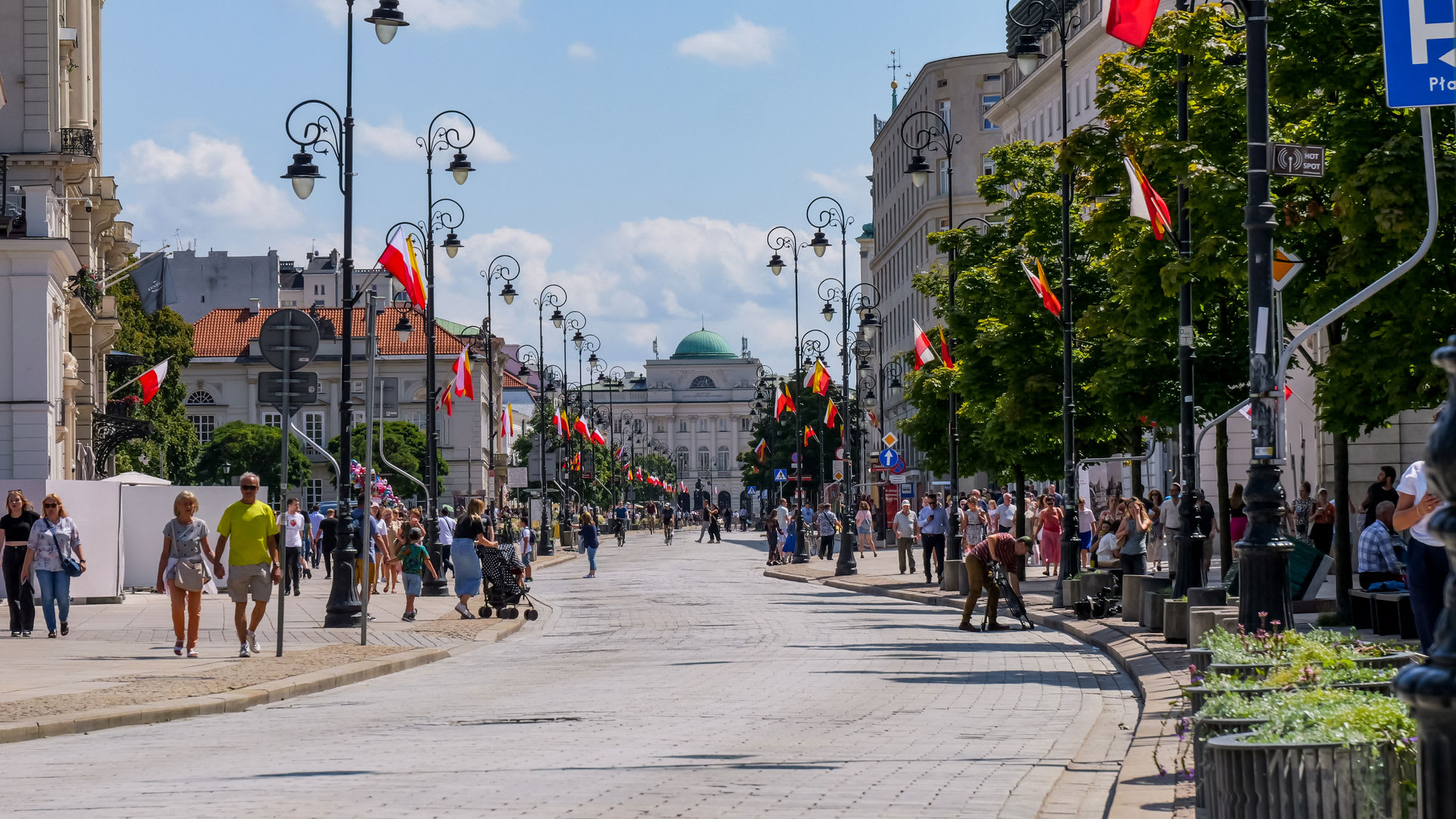
Polish flags line the street near the Old Town in Warsaw, commemorating the 1944 Warsaw Uprising against the Nazis
The Phases of Growth
Poland has now managed to grow its economy for more than three decades, essentially achieving the longest period of growth in modern European history. Not many countries have ever able to manage that. Poland has found a different growth strategy for each of the three decades which has allowed the economy to grow incredibly fast. The first decade’s growth strategy was all about developing capitalism.
In the second phase during the 2000’s they focused on integrating into the globalized world as part of the EU. They concentrated on utilizing their cheap labor and manufacturing skills which was enough to continue uplifting the Polish economy. Another major benefit of EU membership was the redistribution of money from richer member states to the less developed ones in order to balance the wealth disparity in the Union. Poland used this money to further improve its economy, building roads and creating universities.
The third phase, bringing us to the present day, is the use of education. Poland was able to move its economy away from cheap industrial labor and manufacturing for foreign companies and instead developed into having one of the largest pools of engineering talent in Europe. Whereas Poland used to have a brain drain as higher educated people left the country during the communist era, they are now returning to help develop Warsaw’s growing tech industry. Foreign businesses are investing in the country with Google opening research and development hubs.
With all the changes and positive developments in the economy, Poland has also begun a historic military buildup and has created one of the strongest militaries in Europe. The reasons for Poland doing so stems from its not so recent history of invasion and Soviet influence. All NATO member states are encouraged to contribute 2% of GDP to military spending . Poland already spends 2.42%, one of the highest in NATO. After the Russian invasion of Ukraine, Poland has now decided to increase its spending to 4 or 5% in the coming years, higher than any other NATO member.
Once Poland was considered nothing more than a cold, poor, post-communist nation with a cheap industrial workforce but has now has developed into a thriving economy. The country has evolved economically, politically, and militarily in 30 years, largely by leaving its post-Soviet influence behind. It is still lagging behind some of its Western neighbours in terms of GDP but its steady growth has been impressive and some people have predicted that their economy might surpass Great Britain’s by 2030. The rise of Poland has been truly remarkable and it seems it will continue to become more and more influential within the European Union as time passes.
RELATED
TOUR

Trans-Europa
Join us on this spectacular 2 1/2 month cycling adventure across Europe. The route passes through eleven countries, starting in Tallinn and finishing...
]]>
Hungary has a complicated history with Russia. Hmmmm…actually, maybe not. It is pretty clear-cut! Our 2023 Trans-Europa Content Creator, Ethan Weil, and I learned more about Hungary under Soviet rule during a bike tour that we took in Budapest entitled ‘From Fading Communism to…’
It turns out the 1956 uprising wasn’t the first time the Russians had crushed the hopes of the Hungarians. In 1848, they also sided with the Hapsburg monarchy in suppressing the hopes of democratic reformers. During WWII, Budapest was spared until 1944 when Hitler, in order to slow down the Red Army, instructed the Germans and Hungarian Nazis to hold out at all costs. After a 100 day siege, the Russians broke through and destroyed much of the city.
Our first stop on the tour was in an area of the city (Joseph Town) where the fighting in the streets during the 1956 uprising was particularly brutal. Bullet holes can still be seen in the walls of some buildings, over 65 years later. Many of the youths who fought the Soviets were kept in prison until they were 18 and then executed.

Next, we visited the Memorial to the victims of the 1956 revolution which stands over top of the Museum of Ethnography. The site was once a military grounds and there was a statue of Stalin that they tore down during the revolt, leaving just his shoes. Although the Hungarians lost the revolution and many were executed and imprisoned, in the long term the result was a softer version of communism (Kadarism or ‘Goulash Communism’) with more private property and an increased ability to travel.

Museum of Ethnography

1956 Memorial
Our final stop was at the National Cemetery. It is important to note that the Hungarians have removed almost all symbols of Soviet rule. In fact, it is illegal to display the Red Star anywhere in the city. It can only be seen at the Soviet War Memorial near the American Embassy and at the Soviet war graves in the National Cemetery. Even here the government will not maintain them and their upkeep is the responsibility of an anonymous Russian oligarch. In the past, President Putin has visited the site but otherwise, the graves are left alone.

National Cemetery
Not far away was an area dedicated to the men and women who died fighting the Soviets in 1956. We were puzzled by the Hungarian flags flying with holes in the middle but our guide explained that this was the symbol of the revolution. The Hungarians had cut out the hammer and sickle and red star that the communists had placed in the centre of the national flag.

Fittingly, Hungary played a major role in the end of the Soviet empire. As a result of its softer approach to communism, in the 1970’s and 1980’s Germans from the East and the West, who couldn’t cross the German border, were both able to visit Hungary and so it became a place of family reunions. While Hungarians had been allowed to cross their border into the West, in the 1980’s the Hungarian authorities began to allow East Germans to use this exit as well. Once that became widely known, a tidal wave of East Germans headed to Hungary to escape to the West. And once the East Germans saw that this was possible they began to wonder what else was possible…like, say, tearing down the Berlin Wall!
While the city has successfully rid itself of most Soviet era symbols, their influence still remains in places. Take for example, the Marriott in Budapest. This hideous structure certainly wins the prize for ugliest hotel on the planet – Soviet Cold War bunker chic. Worse yet, it is situated right on the beautiful Danube River right across from the beautiful Royal. Palace.

As we learned from our historical bike tour, a city like Budapest has a complex and fascinating history and it is always worthwhile to learn more about the cities and countries on the route of the Trans-Europa Cycling Tour. You never know what you will discover!
Thanks to Akos, the owner of Budapest Bike Breeze, who taught us about Budapest’s Soviet past and answered all our questions with honesty and incredible patience
RELATED
TOUR

Trans-Europa
Join us on this spectacular 2 1/2 month cycling adventure across Europe. The route passes through eleven countries, starting in Tallinn and finishing...
]]>
“Awareness of ignorance is the beginning of wisdom” – Socrates

Ethan, ready to roll
I may have studied history in University but when I was suddenly sent to Hungary in order to help out on the 2023 Trans-Europa Cycling Tour, I realized just how little I knew about the country and its capital city, Budapest. I knew that I often forgot to add an A to the spelling, turning a proud nation into a gnawing need for chicken wings. I remembered something about the Austrian-Hungarian Empire but really, Austria and Hungary had an empire? Oh, and goulash soup…
In order to rectify this appalling lack of knowledge, I roped our Trans-Europa Content Creator, Ethan Weil, into taking a couple bike tours of Budapest with me. Our mission? To discover some history about this country and this city.
Let me just note that while the new mayor is a big supporter of more bike infrastructure, currently it is much like Toronto’s. Add a lick o’paint here, a lick o’ paint there, some sharrows and hope for the best…In any case, here’s what we found out.
The city itself is currently being spruced up, largely due to funds from the EU, but improvements have been in the works for a while. A good example is the House of Music in City Park. The Park itself was neglected for many decades but has been transformed over the last few years with projects like this one.

Before…and after
St.Stephen’s Basilica, in the city centre, can seat 8,000 people. In 1838 a historic flood swamped the Pest side of the city, submerging almost the entire area. However, there was a small hill where some inhabitants managed to survive by climbing up it as the waters steadily rose. As a result, it was decided that a cathedral should be built in that location as a gesture of thanks to God for saving those people.

St.Stephen’s Basilica
Budapest is a city of statues. No matter where you go, you will likely find a metal or stone figure lurking nearby. There is even one of the American TV detective Colombo (Peter Falk)!

One of the city’s many statues
After WWI, Hungary lost a lot of its territory (like two thirds) to Romania (Transylvania – maybe Dracula was Hungarian?), Serbia, Croatia, Ukraine and Slovakia. One of the reasons, they supported the Nazis in WWII was the hope they would recover these areas…bad move. Still, even today on the Hungarian Parliament buildings, there are 2 flags, one of Hungary and one of the Hungarian diaspora living in Romanian Transylvania. In Europe, it seems there is so much history lurking beneath the surface, just waiting to boil over.
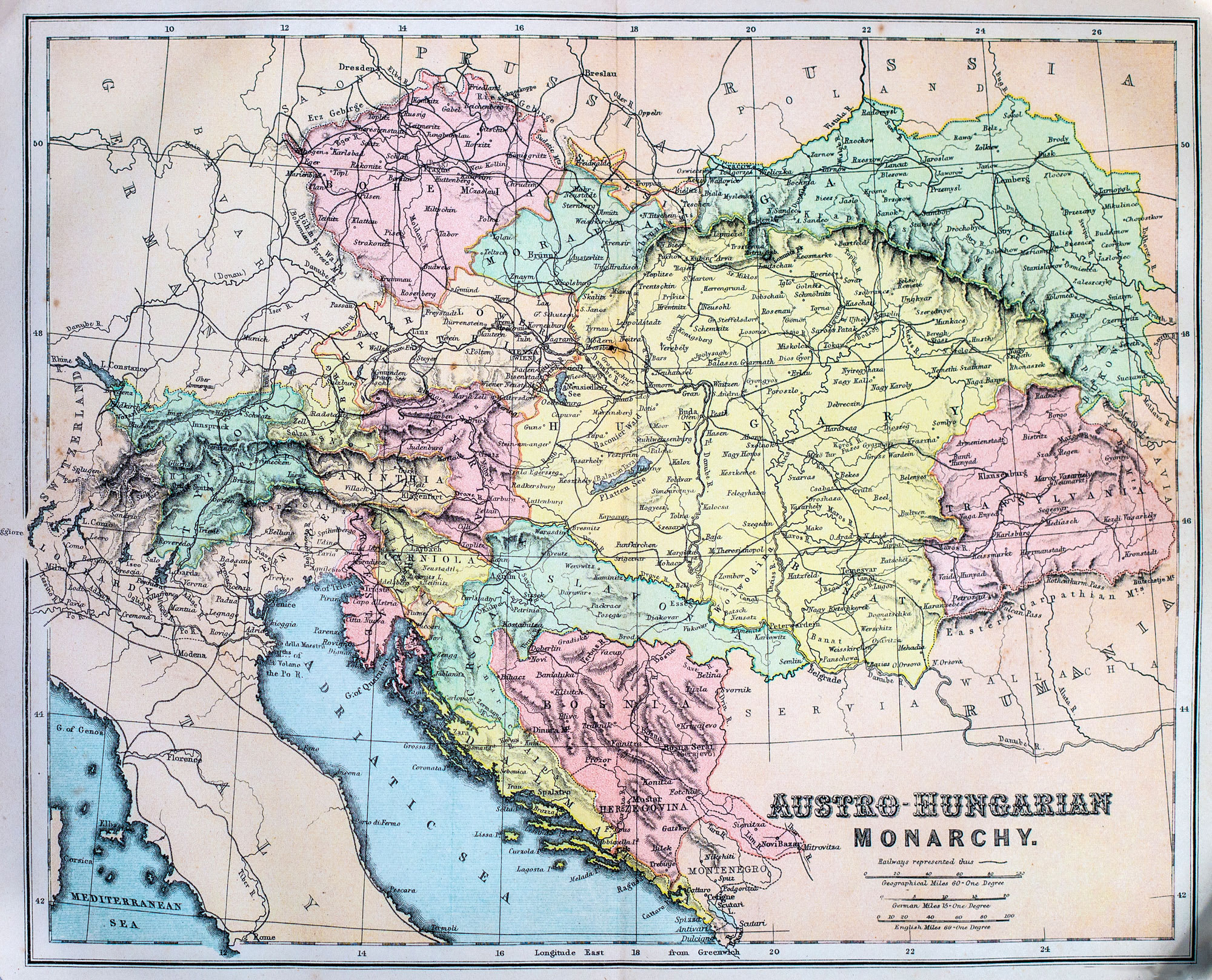
Hungary was much bigger before WWI
Hungary is famous for its thermal baths. The whole country lies atop these waters and past Turkish influence simply encouraged their development. The waters can be up to 70C (yikes) and Hungarians with health issues are given free access to them.

Thermal baths in Budapest
The country founded in 896 by seven leaders who may, or may not, have been Huns (Hun-gary, get it?)! They took a blood oath to protect their people and you can enjoy their unsmiling faces at the Millennial Monument (serious looking dudes) along with a collection of the past kings of the country.

Smile!
Budapest’s opera house was constructed during the time of the Austrian-Hungarian empire. As the junior partner to the Austrian capital, Vienna, the city was finally given permission to build one, but on the condition that it was not bigger than Vienna’s. Size, I guess, did matter to the Austrians.

The smaller Opera House
Thanks to Boris Johnson and Brexit, Budapest can now claim the oldest subway in the European Union. I would never have guessed! And it is beautiful.

Budapest’s subway
Unexpectedly, we ran across a statue of Ronald Regan and George Bush Sr.. While maybe not remembered as fondly in their own country or some others around the world, in Eastern Europe they are appreciated for having ended the Cold War and pulled back the Iron Curtain. Ironically, they are located near the last Soviet War Memorial in Budapest which itself is located across from the US Embassy!

Soviet War Memorial
We also stopped at a memorial to the victims of the Nazis in WWII that is quite controversial. It was dedicated to Hungarian victims of the Nazis, overlooking that Hungary was actually allied with the Nazis until it became apparent they were going to lose the war. The real victims, of course, were the Hungarian Jews whose descendents are rightfully appalled at this revision of history. In response, they began to leave notes and photos of those who were the actual victims of Nazi Germany and their Hungarian allies. The current government has tried to remove the displays but they are always replaced and are currently there to see. Very touching and a reminder of the power of protest and memory.

World War II Memorial
So now I know a little bit more about Budapest and Hungary. And hopefully you do too!

Taking a bicycle tour of any city is the best way to get a better understanding of its heart and soul. Many thanks to Bernadette and Akos of Budapest Bike Breeze for teaching us about their beautiful city.
RELATED
TOUR

Trans-Europa
Join us on this spectacular 2 1/2 month cycling adventure across Europe. The route passes through eleven countries, starting in Tallinn and finishing...
]]>
Ethan Weil is the Content Creator on the 2023 Trans-Europa Cycling Tour. In this piece, he examines bike culture in the Baltic States.
Tucked away in the north-eastern corner of Europe along the coast of the Baltic Sea are three countries, Estonia, Latvia and Lithuania, also known as the Baltic states. It’s a northern landscape with vast forests, long sandy beaches, and a countryside that emits a sense of tranquility as you pedal through it. There is a richness in the cultures and history that each of the three states hold, both through similarities with one another as well as unique differences. When planning a biking adventure, the Baltic isn’t likely a place you hear much about in North America, much less having known someone that has cycled there, but what brings these Baltic states together is their bike culture and the ability to develop widespread bike infrastructure.
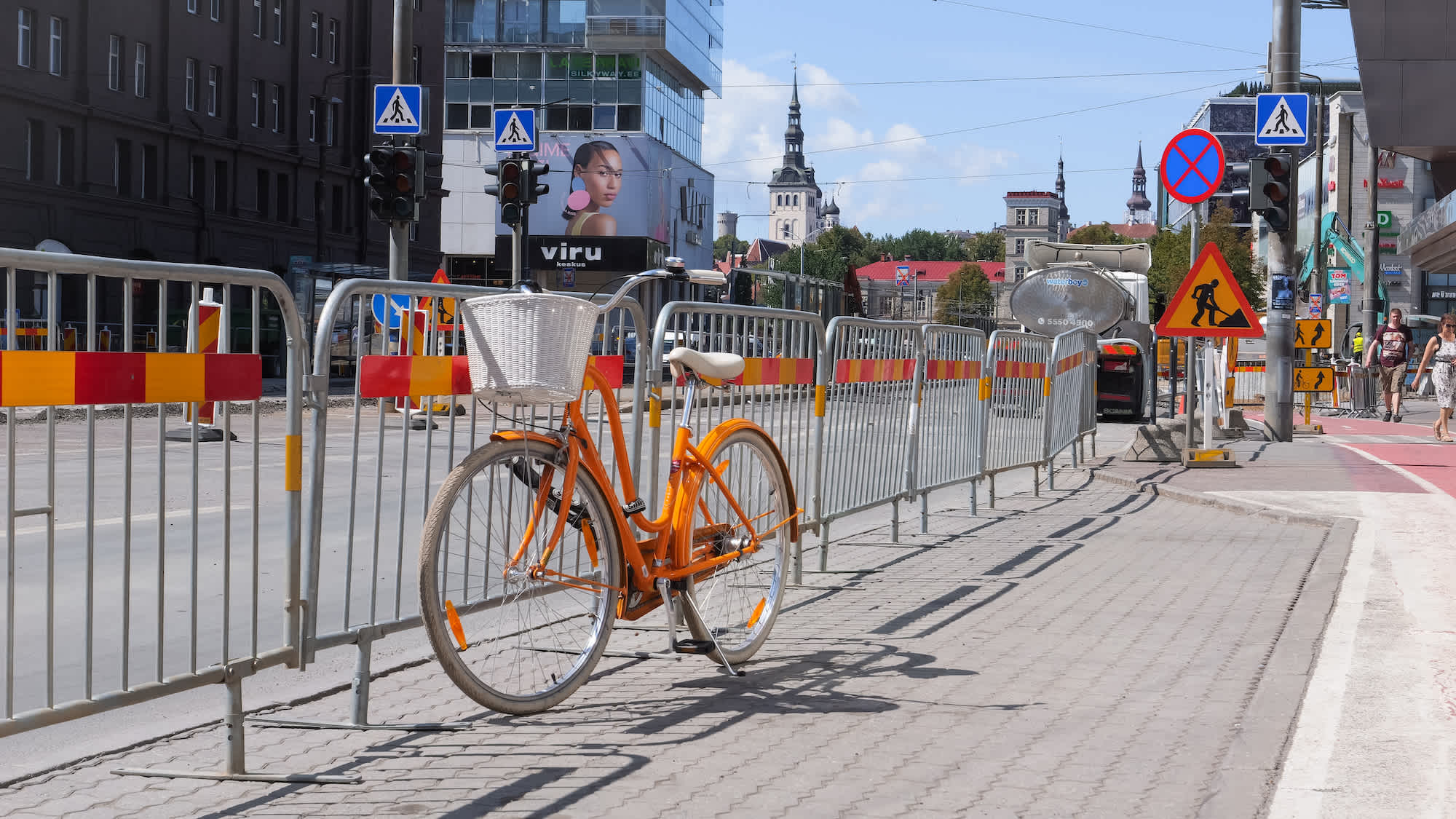
Estonia, the northernmost of the Baltic states, is developing and updating its cycling infrastructure, especially around the capital city, Tallinn. A city of advanced tech mixed with historical castles and cathedrals, Tallinn originally had very little support for cycling. Now they have created separated bike lanes, implemented bike sharing systems and have designated bike parking all around the city. It’s become quite the bike-friendly city, so much so that the ‘Visit Tallinn’ website has a bunch of information on cycling. Whether it’s guides on how to get around the city or blogs on bike-packing, they now take cycling seriously as both a means of transportation and as a recreational activity.
Not only that, their development for tech and entrepreneurship in the business/investment industry has extended into opportunities for bike sharing systems such as ‘Bikeep’ which especially boomed during the pandemic. This bike friendliness extends throughout the country as smooth and convenient bike trails are a common site. They lead both inland and along the coastal waters of the Baltic which happens to be a part of the European Coastal Path (also known as the E9). Over the years Estonia has built an impressive network of cycling trails and paths for everyone to enjoy!
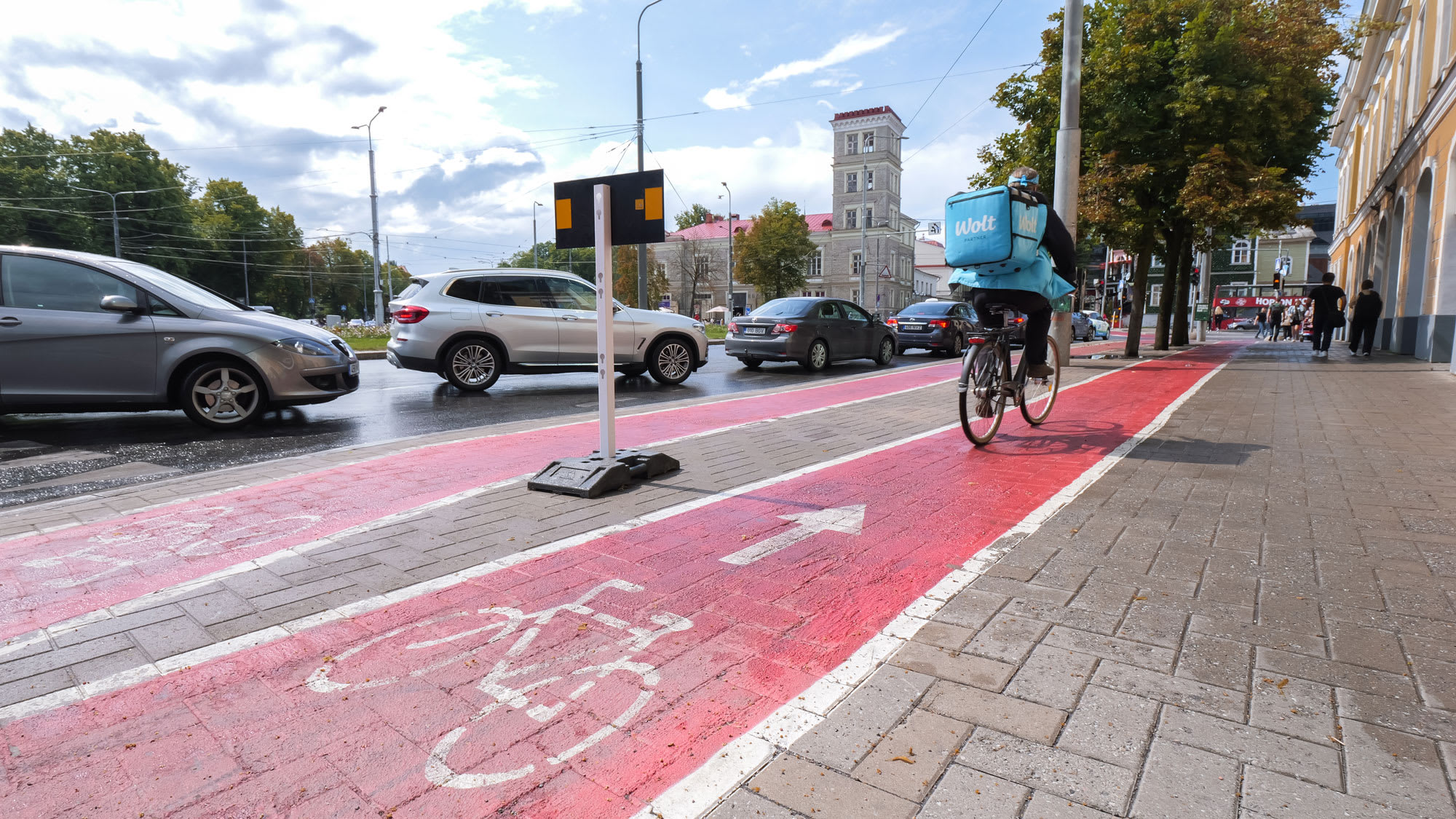
Latvia, located between Estonia and Lithuania, has a unique bike culture as cycling has been present throughout much of its history, including the Soviet era. It has been home to manufacturers that have produced all kinds of bicycles and hundreds of brands throughout their years of operation. Like Estonia, the land is flat and makes for easy riding along the many bike paths. Locals can be seen throughout the country, cycling both for leisure and as a means of transportation, especially in the smaller towns.
Along our tour route, we had the chance to check out the Saulkrasti Bicycle Museum, which is family owned and goes in depth about Latvia’s history with bicycles. I highly recommend checking it out whenever you’re in the area! The EuroVelo 9 cycling route continues down Latvia’s coastline and many cyclists and bike-packers can be seen along this road. It takes the riders into Riga, Latvia’s capital. This beautiful city is built over the Daugava River where there are bike trails along the water that allow riders to enjoy the views. Within the city itself bike culture is strongly present, with many bike shops to be found.
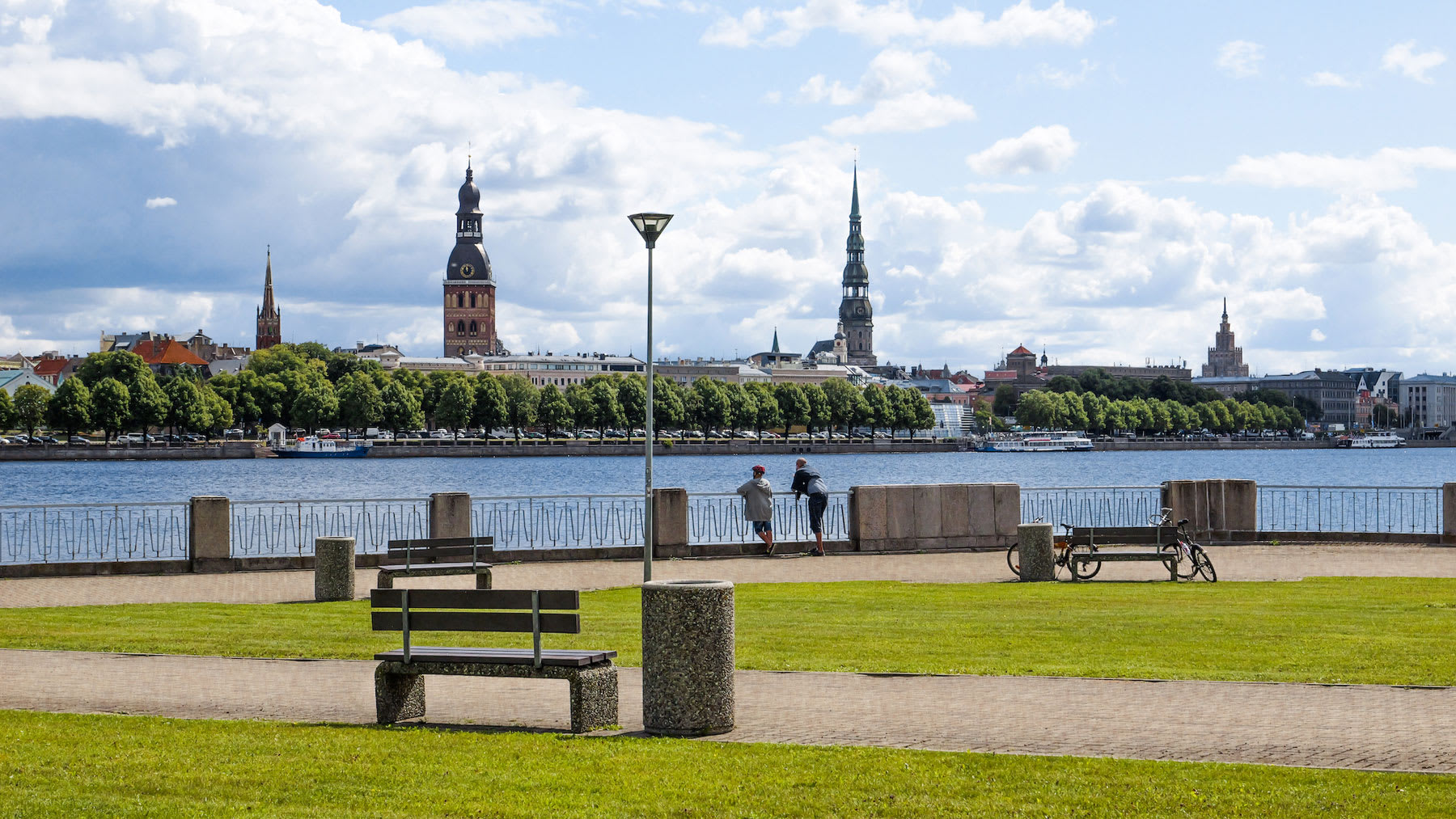
The Daugava River, Riga
Lithuania, especially its capital Vilnius, has embraced biking by making it easy to get around the city with numerous rental bike options. It’s a beautiful city and in addition to the infrastructure they have put in place around the new city, they have also updated their old town. Bike lanes have been painted over the cobblestones to help separate cyclists from pedestrians and vehicles. Outside the capital, there are some separated bike paths as well as simple shoulders on which to ride. What really sets Lithuania apart from Estonia and Latvia for cyclists are the rolling hills in the countryside. The topography starts to have more definition beyond just a flat surface, so slight uphills and downhills are to be expected.
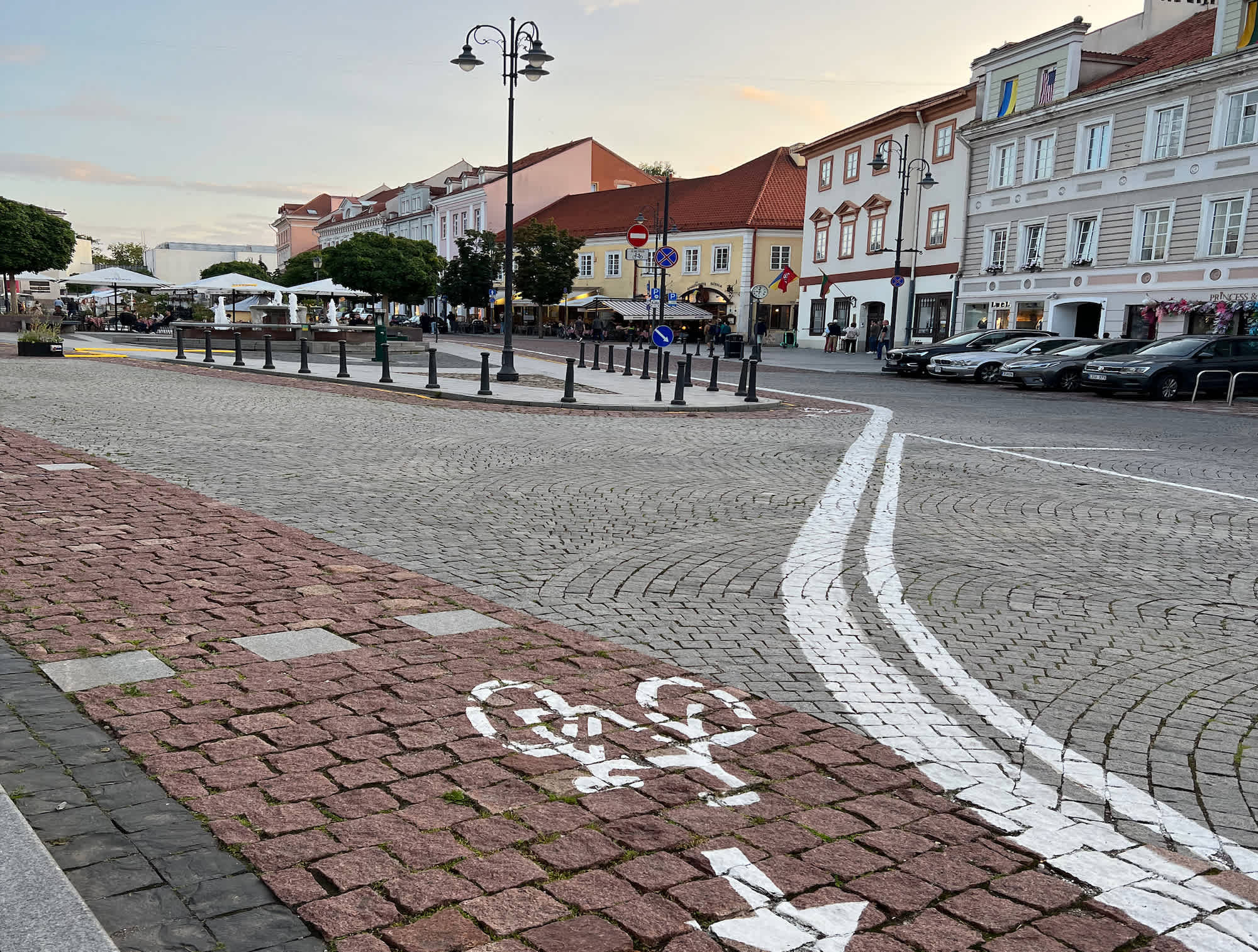
In the Baltic States you will find many locals cycling with their families for recreation in small towns or using them as transportation to get to work. What is most striking is the amount of bike-packers and bike tourers one sees throughout the Baltic States. Cyclists loaded with gear can be seen more regularly than one would have expected, as the area turns out to be a very popular bike destination. We met one set of Greek cyclists on the Estonian-Latvian border who were geared up for bike touring and mentioned that they started in Tallinn and were headed back down to Greece while using part of the E9 Coastal Path. Other cycle tourers we encountered were actually from Estonia or Latvia and were returning home from their long adventures.
Simply put, the Baltic States are a beautiful and tranquil place to ride a bike. Whether you are just riding a short distance or continuing far across the Baltic region, there is always something to see and appreciate.
RELATED
TOUR

Trans-Europa
Join us on this spectacular 2 1/2 month cycling adventure across Europe. The route passes through eleven countries, starting in Tallinn and finishing...
]]>
The 2021 Trans-Europa was the very first tour we had been able to run since the pandemic forced us to cancel the Tour d’Afrique way back in March of 2020! Hopes were high and the riders were excited to get back on their bikes and explore the world but changing travel restrictions and health requirements added a degree of uncertainty into the mix. In the end, the participants were able to successfully pedal from Ljubljana to Gibraltar. Here is what they had to say about their European adventure.
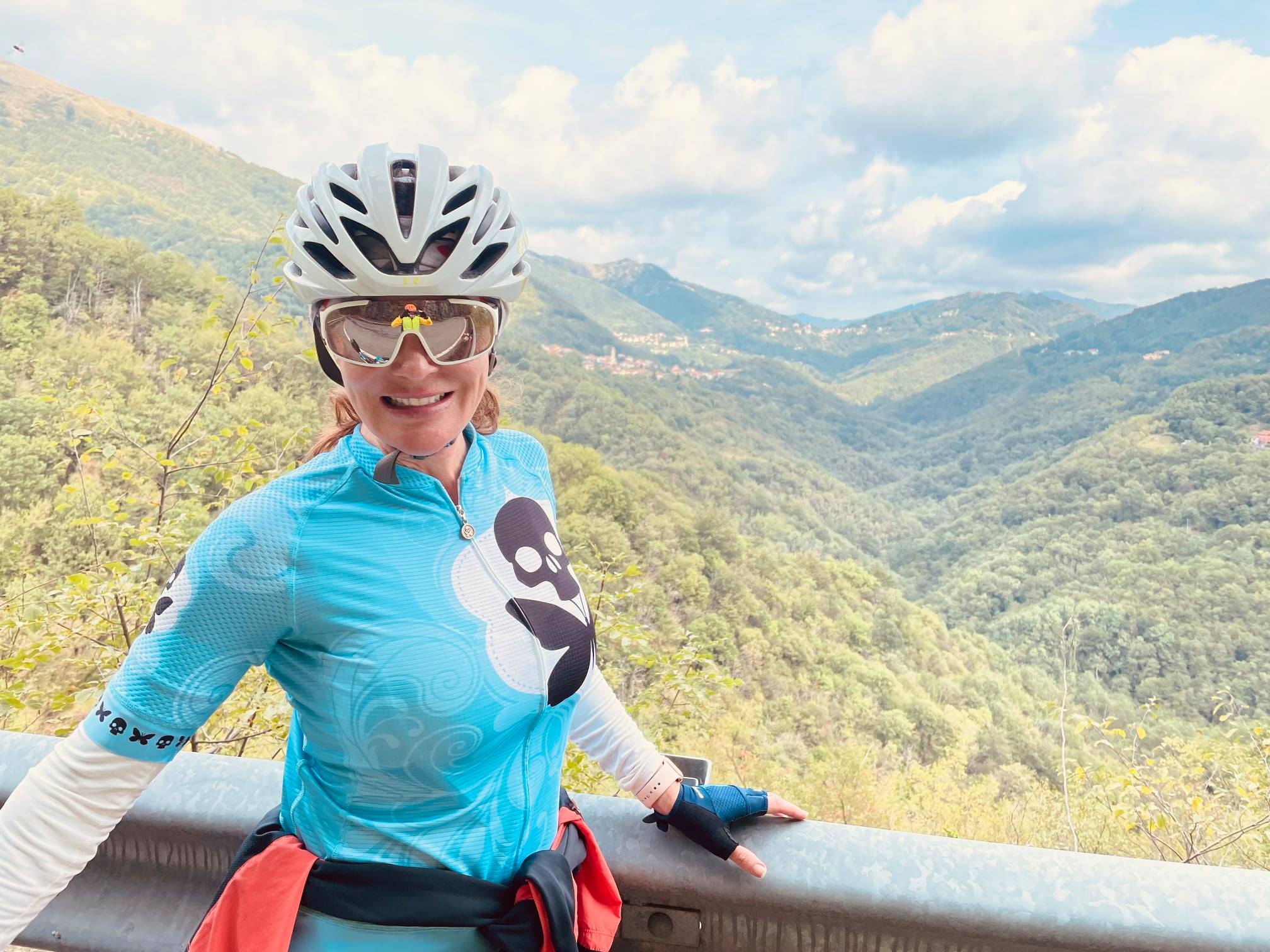
“The TDA team completely exceeded my expectations. The route was stunning, challenging, and fun! I can’t wait for my next tour.” – Stacey Bailey (USA)
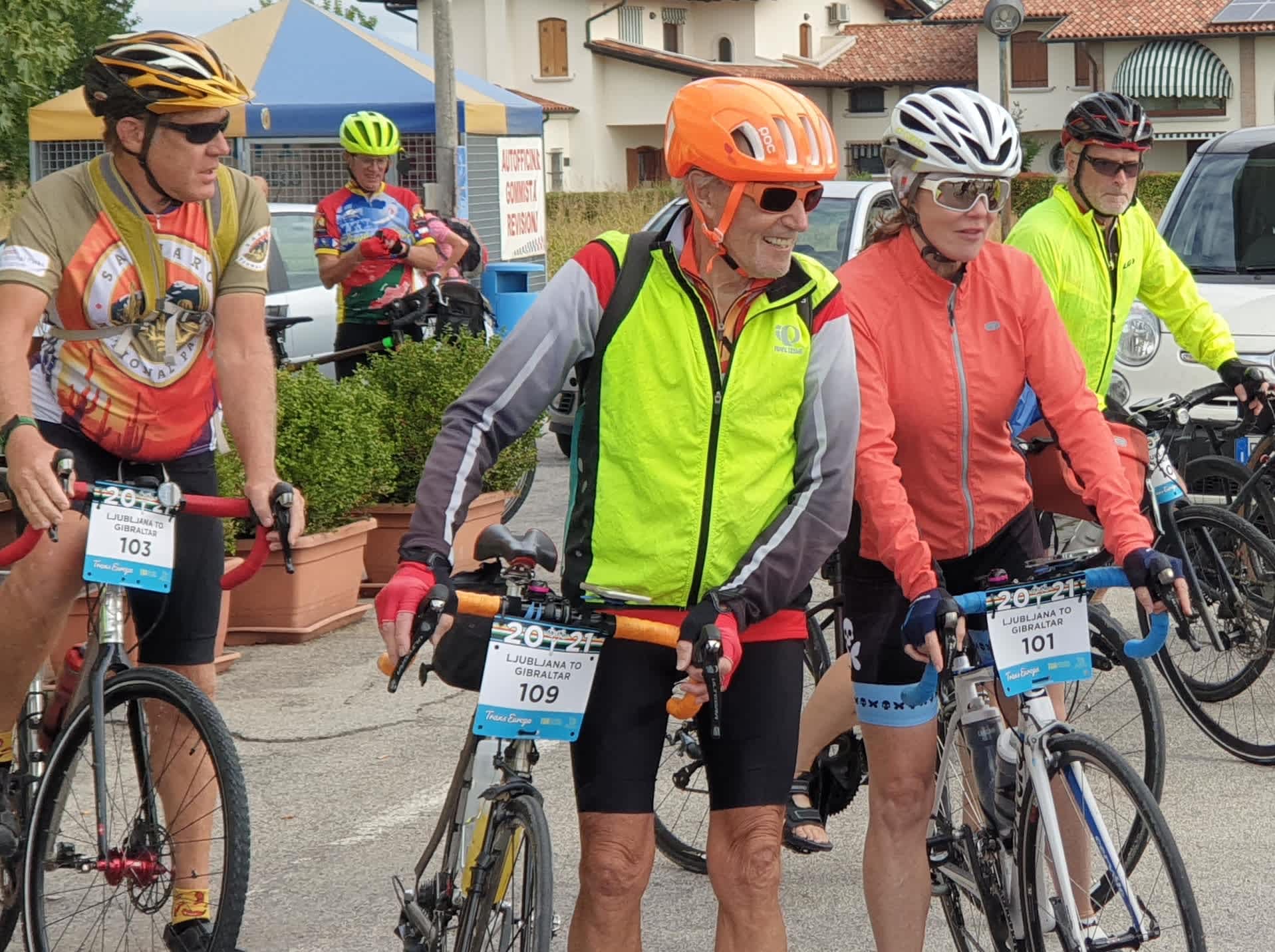
“A bunch of strangers came together and formed a really great group of nice folks to ride and share meals with. The varied terrain took us from mountains to seaside and back while the climbs most always topped out to give great scenic views. Glad I did it.” – Greg Forst (USA)
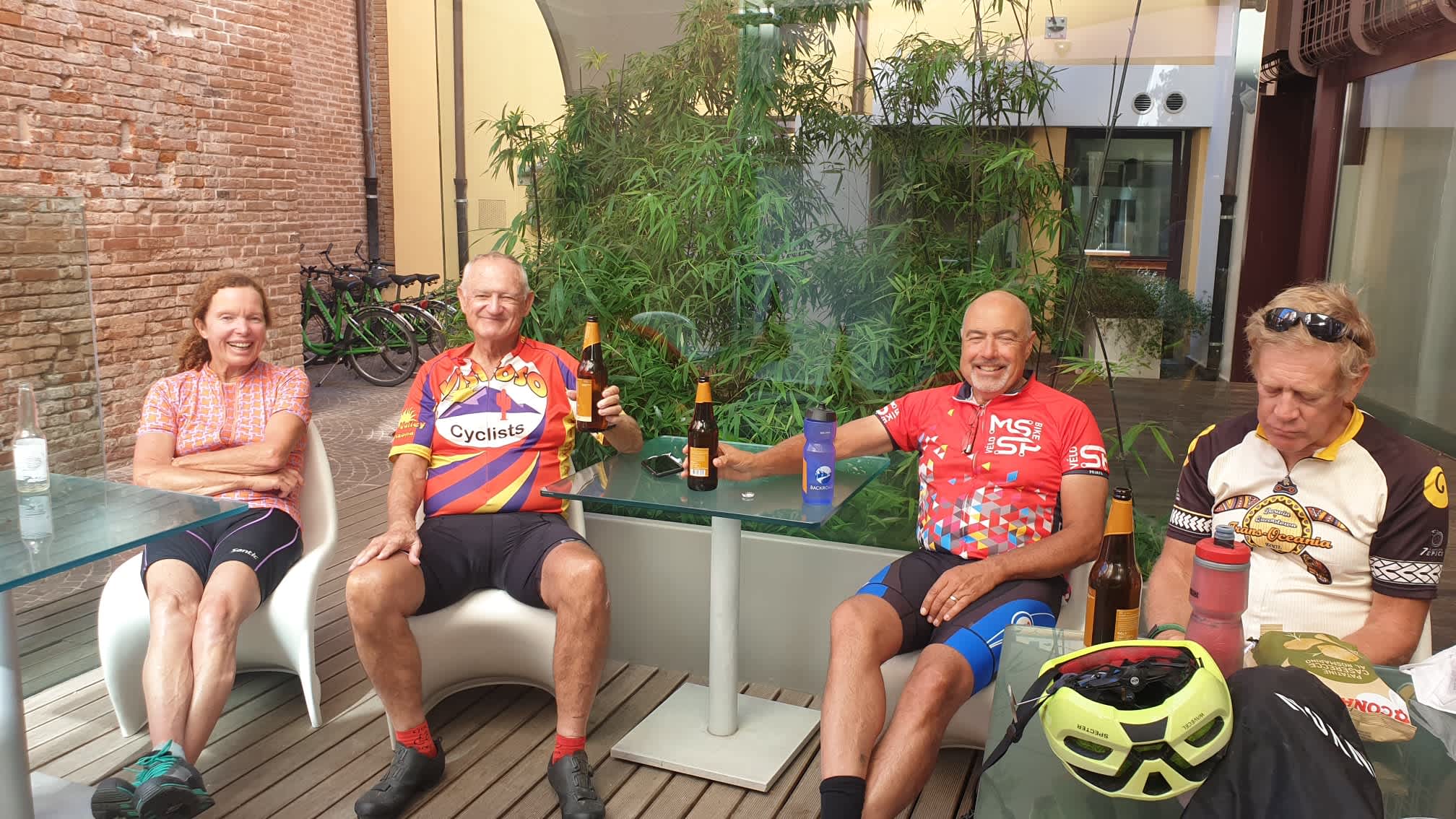
“A great route with a great group of people and a great team.” – Simon Boyd (UK)
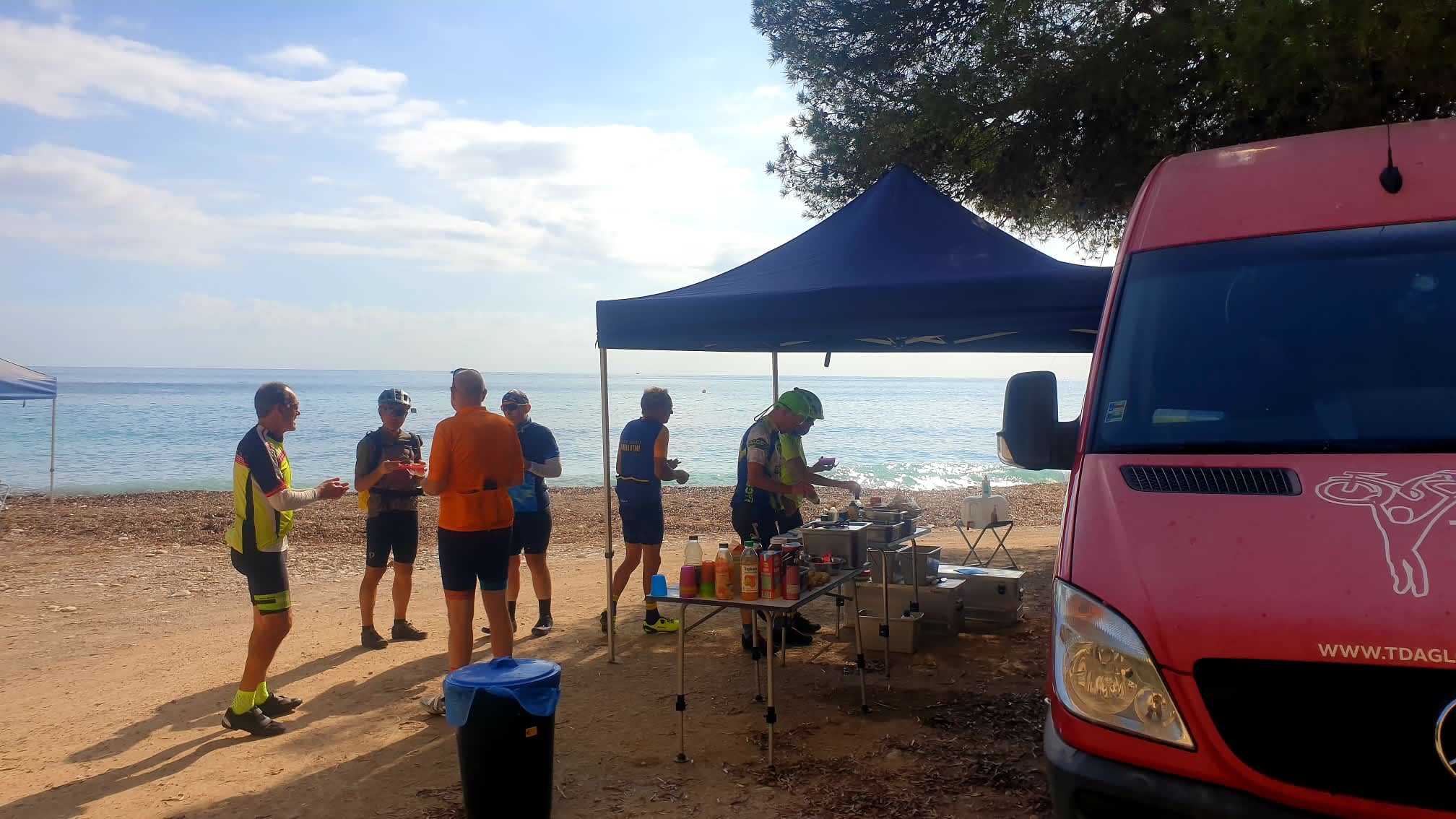
“The Trans Europe tour was everything I expected and more. I expected quaint towns, interesting cities and a safe riding route and the Trans Europe was all of that. Every member of the TdA staff treated each of us with kindness, consideration and attention to whatever it was that we needed. I have done other tours with other companies and nothing in my experience compares with the quality of the tour they provided.” – Robert Peltzer (Canada)
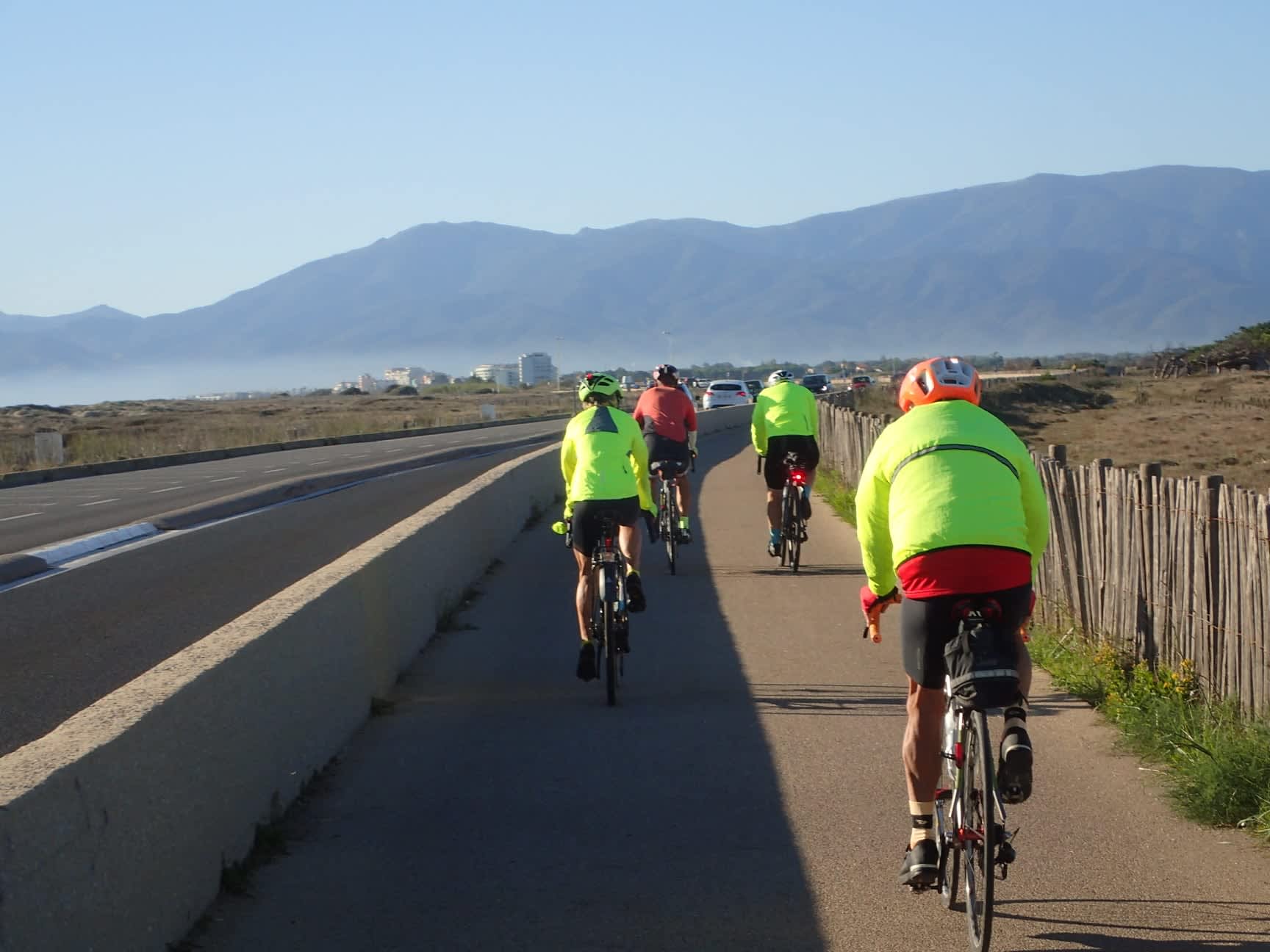
“It was a joyful experience – riding through beautiful Spanish cities, spinning along the Costa Brava, laughing in the driving rain through the mountains. I felt like a kid again – my daily life responsibilities seemed so far away for those 40 days.” – Jeanne Turner (USA)
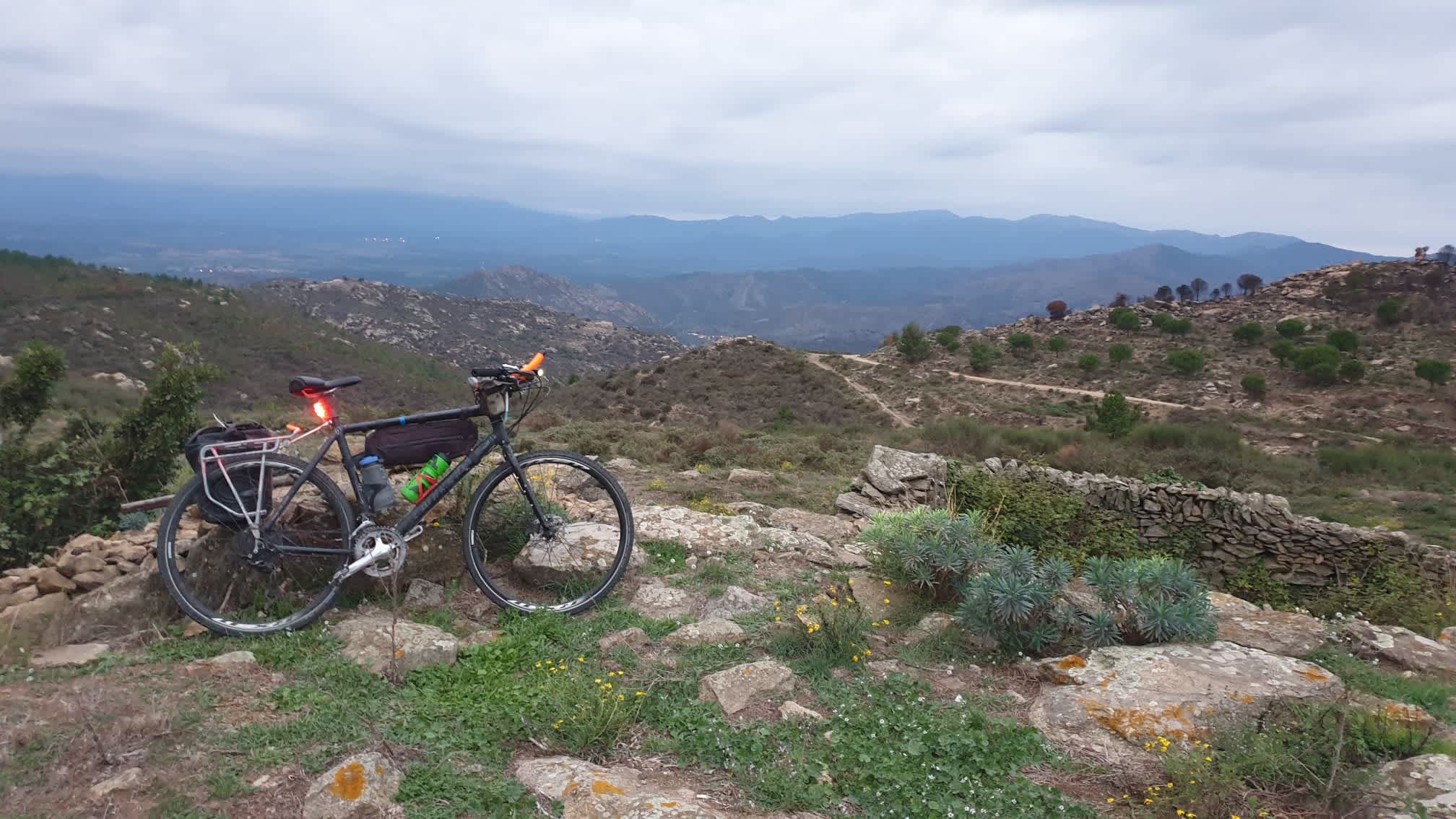
“It was so great to be on the bike again, and experiencing a TDA road trip: great scenery, great food, and the best support staff. There is nothing that beats getting on the bike every day and knowing everything is taken care of and all you have to do is enjoy the ride!” – Eve Holland (USA)
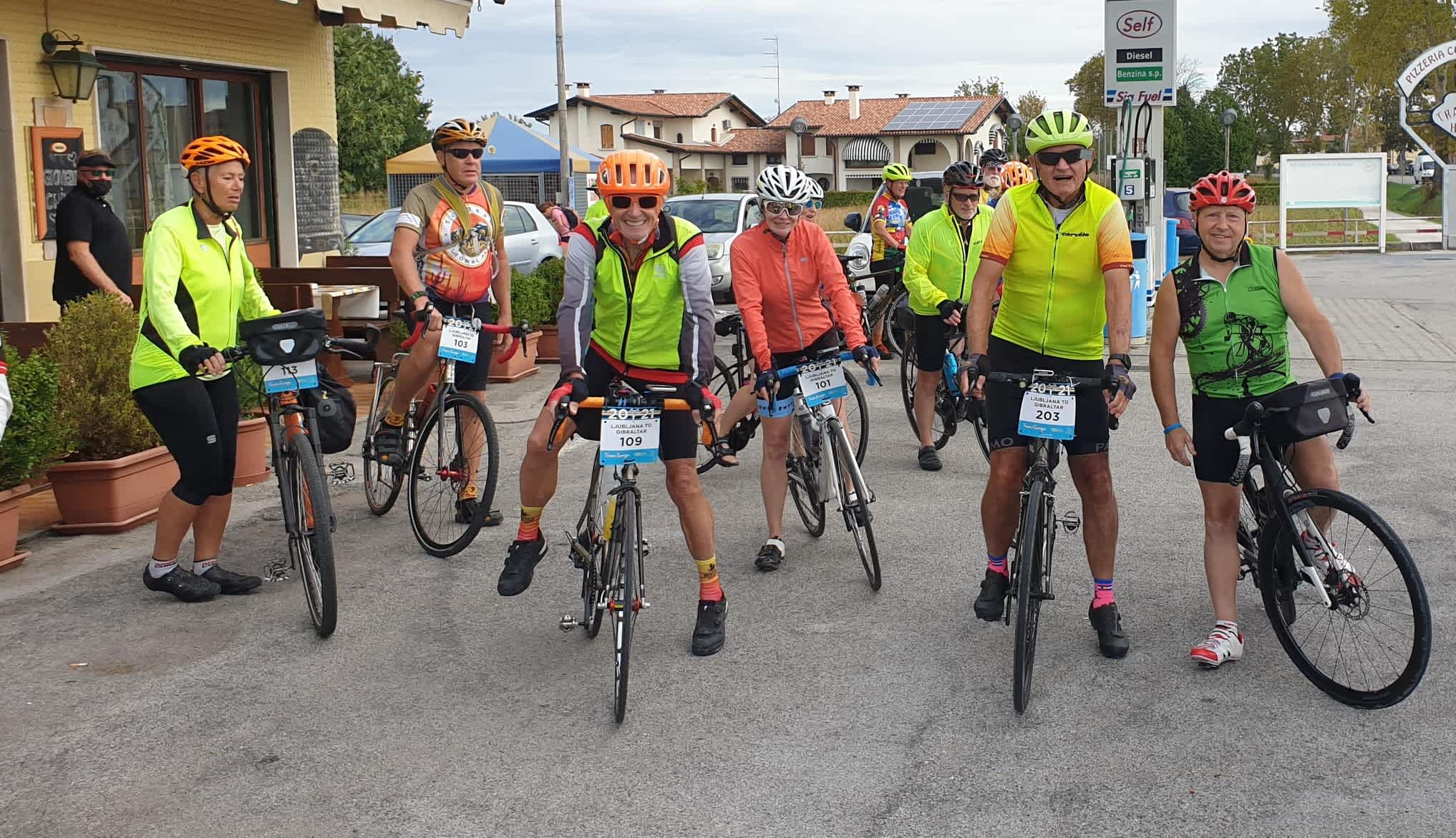
“Excellent experience. Support staff was great. Lunches delicious.” – Lee Taylor (USA)
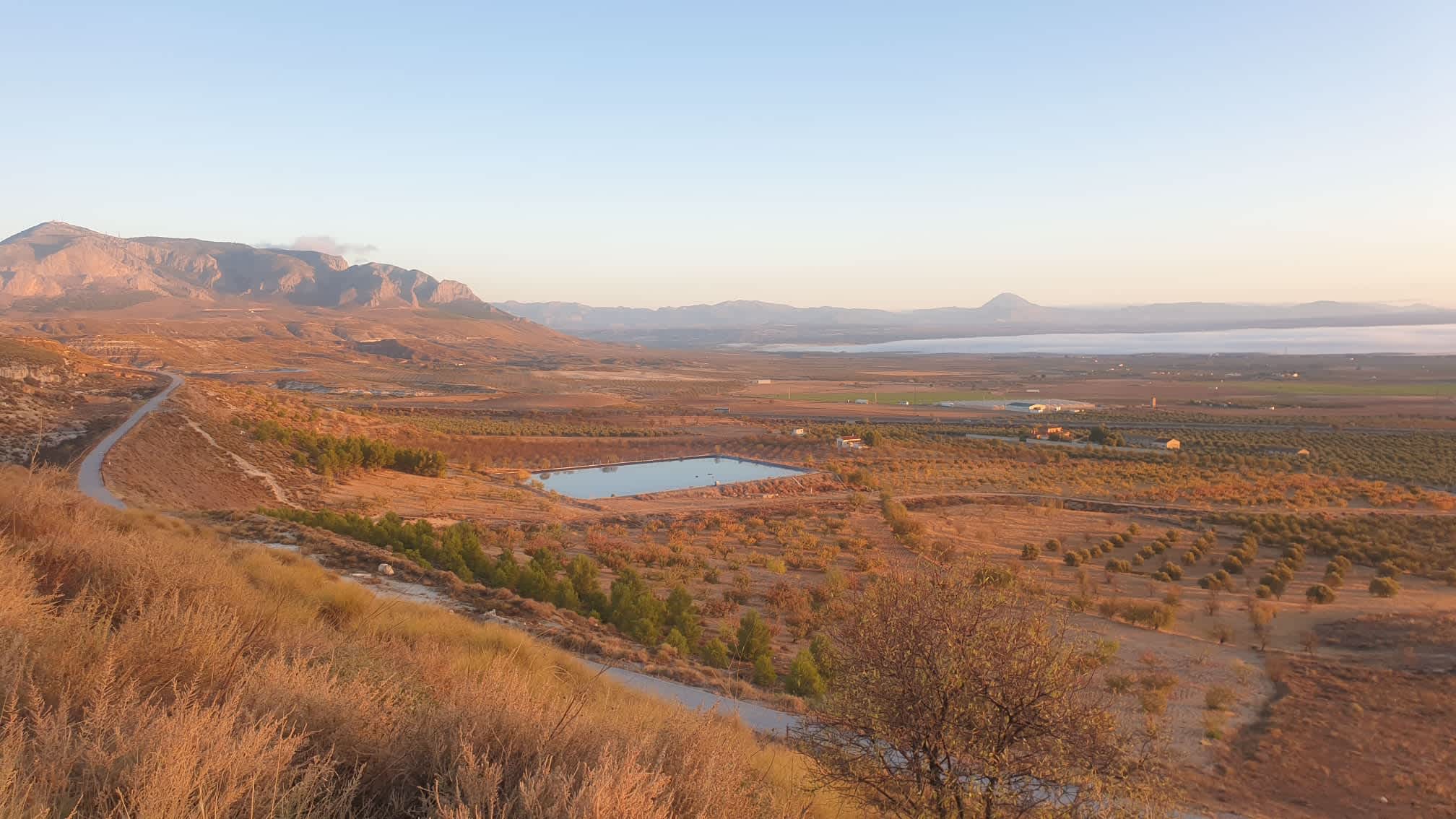
“Overall it has everything in it. Excellent routes for cycling with low vehicle traffic except in the cities. Lots of interesting and challenging sections, great vistas, riding through villages and small towns, lots of quiet roads, broken pavement, riding down narrow twisty and windy roads.” – Justin Chia (Canada)
RELATED
TOUR

Trans-Europa
Join us on this spectacular 2 1/2 month cycling adventure across Europe. The route passes through eleven countries, starting in Tallinn and finishing...
Tim Millikin worked on the 2021 Trans-Europa Cycling Tour and sends this final report.
It was 8am and the sun was rising over the top of the buildings opposite our hotel, warming us with a bright morning glow. It was the final day of our tour. Stage 31 out of 31 and the last 102 km out of 3035 km. Everyone beamed with pride and excitement as we wore our Trans-Europa branded jerseys out of the hotel and across to the bullring in Ronda for the final snapshot. With the photo taken, everyone was keen to head out onto the last stretch of road of the 2021 Trans-Europa tour. The final day was from Ronda to Gibraltar and we would mark our final ride with a final border crossing – onto the rock and into British territory. The road started like any other in Southern Spain, which was uphill! We slowly made our way up the 800m meter climb and over the first pass of the day.

The road weaved in between towering outcrops of grey and brown rock, rewarding us with more amazing views. It was the final bite in the tail from Spain, but our legs were now strong and our minds resilient to the challenge as we climbed with a gusto we had not seen before. We didn’t have to save any energy for tomorrow, so we gave it our all! From the top of the pass you could look out and see the tops of the Atlas Mountains in Morocco. To see Africa from our lofty height made me reflect back to that first day in Slovenia and to finally realize how far we had come. Half way across Europe! A smile beamed from ear to ear and I was reminded how far you can actually travel by bicycle and how lucky I was to be on this TDA Tour.

Suddenly, it was all downhill, literally. A 30 km descent began and we tore down the mountain roads towards Gibraltar. The colours quickly went from grey to green as we headed back to sea level. The temperature increased as did our heart rates after our fun downhill ride. The last stage was a 30km flat section which saw me ride with Eero and Yvonne. They were the last riders to finish the day and we all rode together as a little team, slowly making our way out of Spain and into Britain. We cycled across the runaway at the Gibraltar airport after having our passports checked. There is a traffic light system there letting the road know if there is a plane coming before you cross! Fortunately for us, the lights were green and we crossed into the busy and congested city.

We rode the final 3 km towards the Rock Hotel, which was uphill and was the final climb of the day and the trip! As we turned the last corner to the hotel, we were greeted with bells, whistles, cheers and claps from the other riders. Everyone was waiting for us to arrive, to greet us and pass out the congratulations. It was a great moment. This was a shared journey and it didn’t end until the last riders were in. Champagne popped and stories were told before everyone went back to their rooms to prepare for the final dinner.
The celebration dinner was at a beautiful Gibraltarian restaurant called Rendezvous Chargrill and we passed the evening with good wine and even better food. Awards were given out, speeches were made and we all rejoiced in the knowledge that we had made it. 3035 km over 31 days, 24 riders and 4 staff members, across five countries. The memories made here will last a lifetime – the tough days, the wet days, the days chilling on the beach! It was the first tour that pandemic restrictions had allowed and I can say it was a roaring success. We started with a degree of uncertainty but we finished safely and with the knowledge that tours and travel can once again run. For me, this was the biggest win. Memories of cancelling the 2020 Tour d’Afrique half way through the route faded into the background and were replaced with the new experiences gained on the Trans-Europa.
RELATED
TOUR

Trans-Europa
Join us on this spectacular 2 1/2 month cycling adventure across Europe. The route passes through eleven countries, starting in Tallinn and finishing...
Tim Millikin is working on the 2021 Trans-Europa Cycling Tour and sends this report from Granada.
After a wonderful rest day in Valencia, the riders on the Trans-Europa turned their bicycles to the west. We said our goodbyes to the sea, to the Valencian architecture and to the easy road. Goodbye to the hustle and bustle of the Costa Blanca and the Costa Dorado. We had been cycling along the Mediterranean coast for the past 10 days, from the Cote D’Azur in France and on into Northern Spain. While it had been fun to visit it was time to head inland and see what else Spain had to offer.
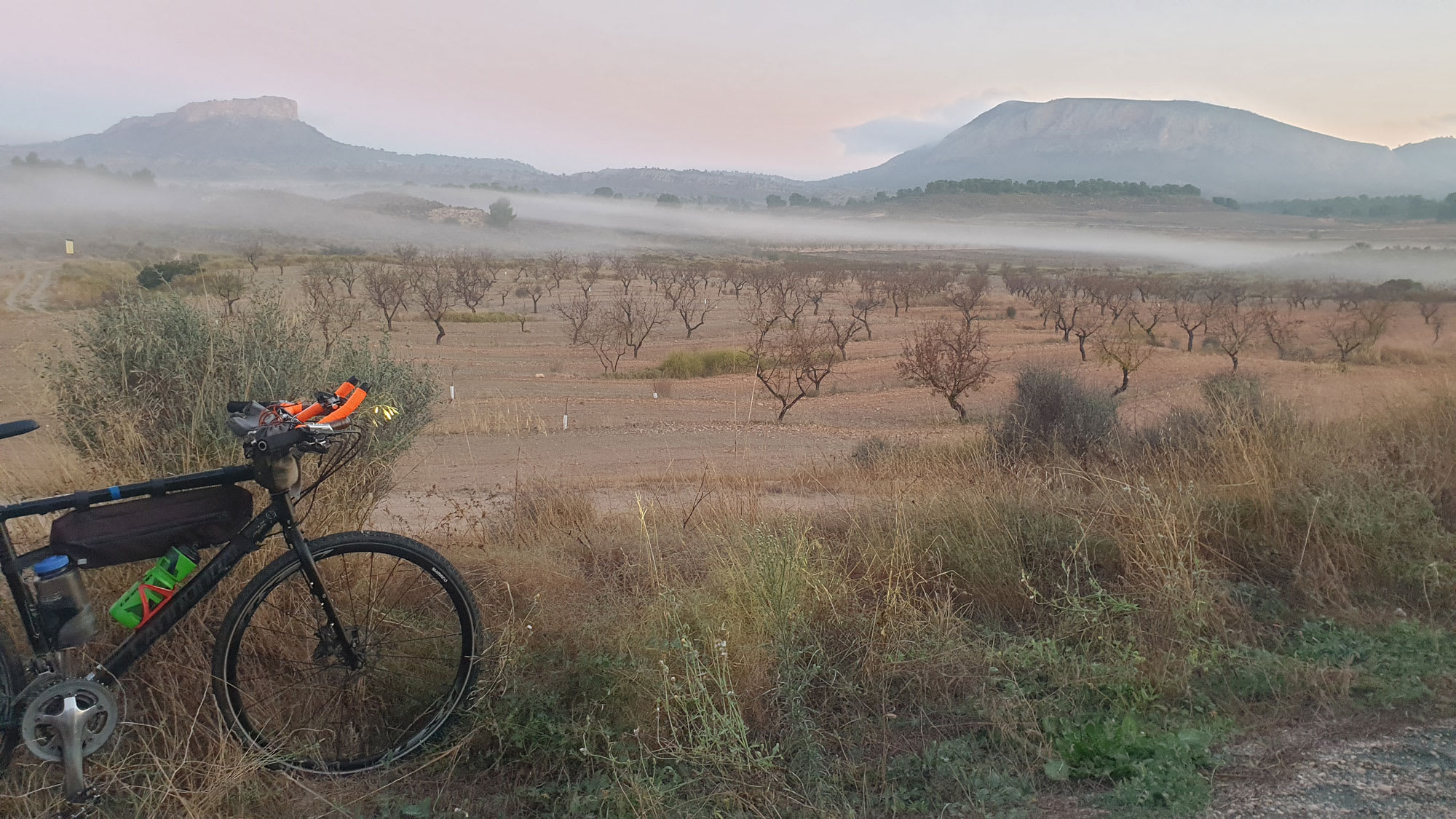
We left Valencia at sun up, with local traffic buzzing past us. Our destination for the day was Ontinyent and a stylish Moorish hotel in the heart of the city. We quickly left the city behind and made our first foray into rural Spain. Endless vines of grapes, both purple and translucent green in colour, dotted the highway as we pedalled towards the hotel. One hundred kilometres of gentle riding meant that we reached the hotel with smiles on our faces, happy to have been riding on the quieter roads.
As we ventured west, the coast gave way to olive orchards and vineyards. Blue and white hues gave way to browns and greens while the busy traffic vanished and made way for quiet secondary roads with pristine tarmac and the occasional gravel sections! Population centres were quickly replaced by small, sleepy, stone villages and the landscape opened up before our ever widening eyes.
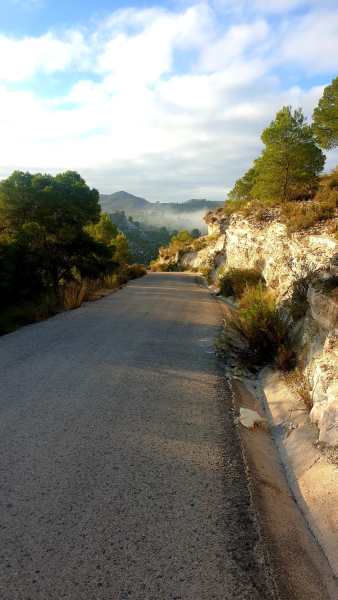
This was the start of a six day ride between Valencia and Granada, a stretch of wild Spain where we cycled in the shadow of two mountain ranges, the Sierra Castril and the Sierra Nevada. Riding along the vast mountain ranges , we were guided westwards, spinning between towering peaks. In three days we had reached Caravaca De La Cruz, a pilgrim town famous as the fifth Holy City of Catholic Christianity. Old yellow walls, pockmarked with a secret history, towered over us, creating narrow, shady walkways as we wound our way to the hotel. We stayed at the excellent Circulo Articulo hotel directly outside one of the old churches where the hospitality of the owners, Alex and Mercedes, echoed the beautiful style of this peaceful and charming town.
Over dinner, the talk was of climbs, descents, wide open landscapes and how the riders would best handle their energy over this long six day stretch. The reason for the slight concern was the last day into Granada which would be a 134 km stage with 1860 metres of elevation gain, possibly the toughest stage of the entire tour. Energy conservation was their aim, with each rider putting forward different strategies on what would suit them best. Leaving Caravaca De La Cruz, we had a climbing day with 1300 metres of elevation gain factored in over 80km. This short, but relatively slow stage, meant our riders could take some time off their bikes to enjoy the scenery. I was riding ahead that day and loudly shouted my admiration for the views ahead as the road wound around, giving me a new vision on every turn! It was excellent! All the talk of strategy and conservation was replaced with smiles, excitement and a realization of just how lucky we were being able to see the sights around us.
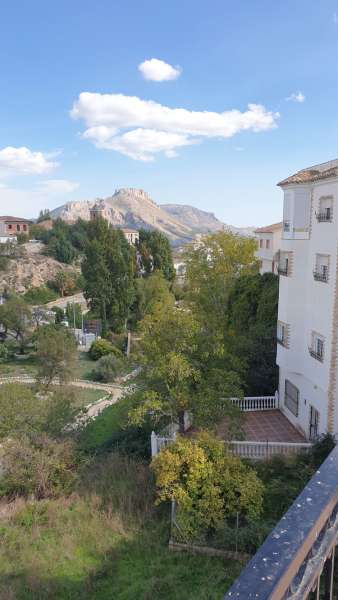
That day we reached Velez Blanco, a town nestled under the protection of a 16th century castle. Our hotel, Casa De Los Arcos, had arranged an eight course degustation dinner, perfect to re-energize and refuel everyone. It was magnificent to sit on the terrace as the sun went down, drinking wine and eating amazing food. It was a real treat for our riders with some saying it was the best meal of the tour. The whole evening was put on by just two people, a chef and a waiter and before everyone went to their rooms the two of them were treated to a standing ovation for all their hard work and excellent food.
The final day into Granada, we left just after sunrise in order to compensate for the long day of riding. Some rain the previous evening had dampened the mood and the riders were keen to get going after a brief breakfast. The road was tough. It began with a challenging 12 km climb followed by a mix of gravel and pot-holed farm roads. It was a stunning ride as we pedalled past vast open landscapes that looked similar to Mars or even Utah! After lunch, the road surface greatly improved as we snaked around the Sierra Nevada Range. We climbed up to 1290 metres and then took a deep breath, as the views from the top of the pass meant we could see for kilometres all around with villages perched on steep mountain slopes. Moments like this make for unforgettable memories and these six days of rural Spanish cycling will stay with me forever. Our final task to get to Granada was to cycle 35 km, all downhill. The road whipped us away and we rode like pros, leaning into the smooth bends of the fun, fast descent.
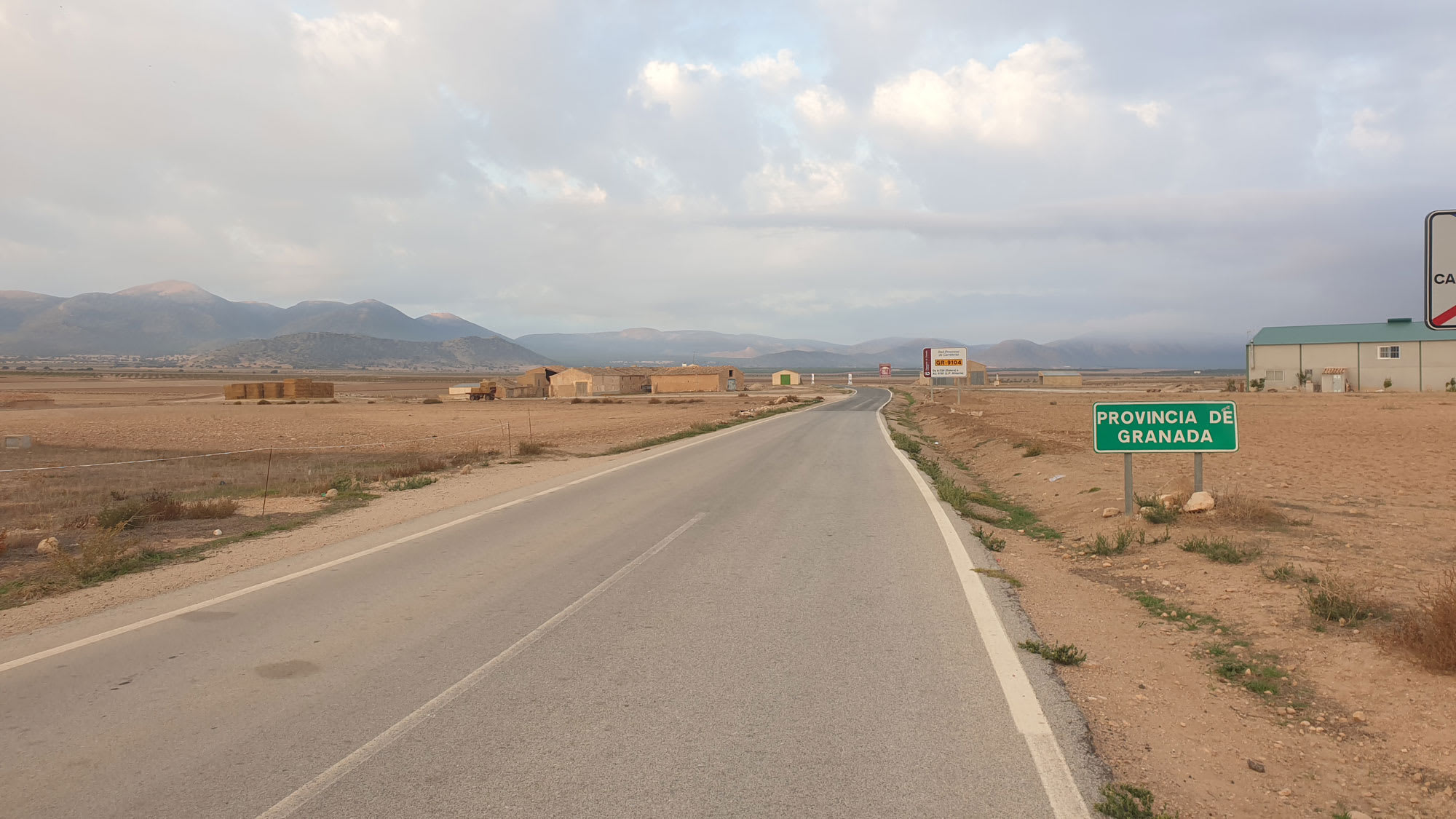
We had come so far, both in terms of distance and but also in our mindset! We had been challenged and had risen to it. We had taken the tougher route and had been rewarded with beautiful views, lasting memories and a companionship which will last forever. Southern Spain had been exactly what we wanted and more.
RELATED
TOUR

Trans-Europa
Join us on this spectacular 2 1/2 month cycling adventure across Europe. The route passes through eleven countries, starting in Tallinn and finishing...
When I was asked to help out on our Trans-Europa Cycling tour my initial feeling was, yes of course, I love Europe! Like many people, I had not been travelling outside my home country in almost two years. I knew there would be some extra steps but I was up for the challenge. Today, as a fully vaccinated Canadian, I am fortunate in being able to travel to many places and for that, I am very grateful.
The first thing I did was print my vaccine certificate which was an email with a PDF stating I had been vaccinated twice with an official Government of Ontario header on the form. I made sure to have a digital copy as well as a paper copy that I could keep with my passport. I did not want to have be using my phone constantly. Having the paper copy with my passport made things quick and easy.
It’s important to know that not every European country has the same requirements for entry. I flew into Slovenia where they only required the vaccine certificate (for two valid doses, at least 14 days prior to travel). When I arrived in Ljubljana after two flights and no sleep, the border control officer was not happy with my paper certificate. He asked me what it was, shook his head and starred at it for what felt like 10 minutes. It was made it clear to me that my Ontario certificate, which he had maybe never seen before, was not the best and most clear form of proving my vaccine status. After some frustration and heavy sighs, he let me through. When I arrived at the hotel and spoke to other riders, one from Canada and one from the USA, they both said there were no issues with their certificates. The American one was on a proper vaccine form about the size of a cue card and the Canadian rider had shrunk down the form, printed and laminated it. So naturally, it looked much more official than mine.
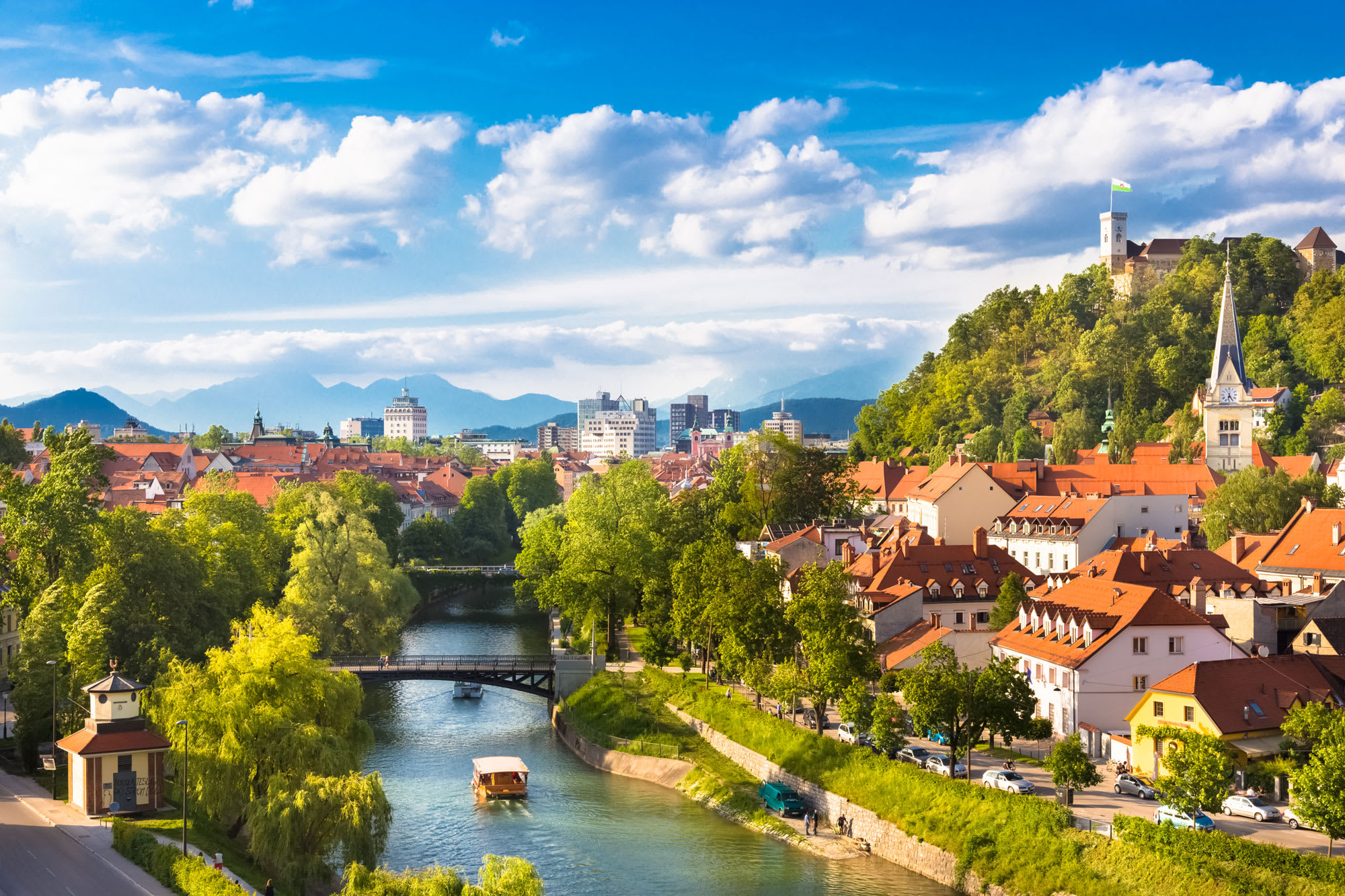
Ljubljana
Once I had arrived, all was green, slightly rainy, but beautiful. When I researched Slovenia I learned that it’s said to be the garden of Europe. I must agree. I was surrounded by mountains and it had many options for hiking, mountain biking or wandering around under the trees below a castle. I kept my vaccine certificate with me everywhere I went, which was good as you needed to show it upon entry to most stores and all restaurants.
After a few days in Ljubljana, our next stop on the tour would be Italy, on our way to Venice. We learned a few weeks earlier that we now had to all get COVID tests before entry. This was arranged for us all at the hotel, the required papers were printed and on we went. After a lovely afternoon of riding, we crossed the Italian border, and rode right through. No hassle, no stopping. I’m not sure I even saw a border guard. I was now in Italy and very excited, as it was my first time there. I could already feel it would be a special place.

Venice
After a few days on the road, we arrived in beautiful Lido, Venice. Lido being only about a 15 minute ferry from the mainland, offers a beautiful beach, restaurants and the best gelato I’ve ever had. On our first rest day, I took a ferry to Venice to see San Marco Square and wander around. It was the first time in a very long time that I was speechless.
There were some other tourists around but I can imagine it was nothing compared to the days before COVID. It felt more relaxed in Italy, as I was only asked to show my vaccine papers once or twice in the time I was there.
It was now time to get ready for travel back to Canada. The biggest lesson I had learned on this trip, was the importance of booking PCR tests early. In Toronto, Canada where I live, it’s a simple process and there are many places to go. In Lido, there was only one clinic and you needed to make an appointment a day or two ahead of time. To anyone travelling in the near future, if PCR (deep nose drill test that takes 24-48 hours for results) testing is required for your return, I would suggest that you make the appointment to have the test 48-72 hours prior to your flight. It will be one less thing to worry about. I spoke to a few people in the airport who, like me, got their results only a few hours before they had to fly.
Travelling during these times can still be easy. Just be sure to do your research on what you need to enter the places you re travelling to, and then check again days before you go. As with any trip, expect a few hiccups and last minute changes. It’s all part of the journey!
]]>
Tim Millikin is working on the 2021 Trans-Europa Cycling Tour and sends this report from Nice.
We crossed into Italy with jubilant smiles as the tour cycled over its first international border. The pre-crossing nerves subsided as we saw the border post was unmanned and we were able to put away our passports, Covid tests, locator forms and QR codes. We were cycling again, touring to new countries, witnessing the mix of language, food and culture as we exited Slovenia and crossed into Italy.

The talk of Italy was food, coffee and gelato. And it was not long until we found our first Italian hotel in the border town of Gorizia. After checking in, showering and drinking a quick Moretti, we all decamped and walked to the restaurant La Tarantella, where we were treated to a beautiful three course meal, the highlight being the homemade tiramisu. The chef used his traditional family recipe, which was passed to him from his grandma just three years before our arrival. The sponge was fresh, the middle boozy and the flavour and memory of the evening lasted us well into the night. Italy was proudly showing us why it has earned its reputation for delicious food. We all looked forward to cycling and eating our way across this new country.

We left Gorizia after a light Italian breakfast of croissant and macchiato and began our crossing of Northern Italy. The first two days saw us ride across the flat, agricultural heart of the country. We passed open farms and waved at the local farmers going about their daily business. It was a momentary glance at a life which would continue whether we passed by or not. We cycled alongside the Po River on a service road which felt more like a bike lane than a road due to the lack of traffic we encountered. We stayed in San Stino De Livenza, a town which had more church bells than people, before heading towards Venice.
There are many ways into Venice, but for our riders, we had decided to treat them to a water taxi tour around the historic city before heading towards our hotel on Venice Lido. We passed the Grand Canal, St Mark’s Square and Basilica and waved at locals and tourists alike as we spent 90 minutes on route to our hotel. There, we were reunited with our bikes and checked into the Venetian style, Hotel Antonio Augustus, before our riders were able embrace their first rest day of the tour. A day off to explore, sightsee, and dine in the Italian manner. We were also lucky that our hotel was a directly opposite a stunning little gelato outlet. A single window and range of rich ice creams and sorbet meant our riders were never far from the most perfect Italian treat. Venice Lido is a short boat ride from the mainland and is where the locals live. It is quieter and has the added bonus of public and private beaches for our riders to relax on after their day out in the hustle and bustle of Venice.

Leaving Venice required another couple of boat rides, two separate ferries that would take our riders to Chioggia. A short riding day from Chioggia meant that everyone was itching to leave the following morning, ready to head westwards across Italy toward the mountains. We passed the walled city of Ferrera, where we stayed in a beautiful four star Novatel hotel directly outside the Este castle. A fortified moat surrounded the castle, once owned by the powerful Este family in the 1400’s. We spun past the busy city of Parma and stopped to taste its famous ham (Prosciutto di Parma) before the route changed course. Instead of continuing west, we were to venture south, heading towards the mountain range of the Apennines. We said goodbye to the farmland and rivers of the province of Parma and looked up at climbs and down at the elevation gradients on our Garmins!
This would be the first tough climbs for our riders and there was some nervousness in the group. Some declared they would take the bus from lunch, others like Yvonne said “I am Dutch; I am not used to big climbs!” Each rider decided that they would begin the day and see how they felt but, like some of their moods, the weather decided to change too.
 The sunshine of the flat farmland had been replaced by thunder and lightning, bringing an erratic energy to the group in a way that only a looming storm can. Heavy rain moved in and everyone had to don waterproof and protective clothing for the first time on the trip. As the riders began to climb, the weather matched them with bolts of bright lightning crescendoing from the sky above.
The sunshine of the flat farmland had been replaced by thunder and lightning, bringing an erratic energy to the group in a way that only a looming storm can. Heavy rain moved in and everyone had to don waterproof and protective clothing for the first time on the trip. As the riders began to climb, the weather matched them with bolts of bright lightning crescendoing from the sky above.
Everybody was soaked. Each rider battled on towards the lunch van and the chance for some dry space under the canopy. Only one rider decided to take the van to the hotel with 20 others bravely going back out into the thunderstorm for more climbing. Navigation became hard with phones not working, paper notes and maps spoilt, and soggy flagging tape not being clear in the wet mist. The riders worked together to make it to the town of Bobbio, riding in teams where only one person had a working device. One rider, Peter from Seattle, even went 10km in the wrong direction, not having heard the shouts from those closest to him. Eventually he had to ask locals in the nearest village for the route back to Bobbio. It was a day for true adventures and everyone arrived at the hotel in Bobbio with stories to share and memories made. The battle over the route, over the weather, over their own willingness to continue, was not easy, but as British adventurer Alastair Humphreys puts it “It doesn’t have to be fun, to be fun!”
 To celebrate everyone’s arrival, our hotel for the night featured an award winning, Michelin approved restaurant. The wine corks popped and everyone was able to celebrate their day with delicious, traditional Italian food. The warmth of the local family run restaurant soon soothed our wet memories and each rider had a story to share having overcome the worst and embraced a day of true adventure.
To celebrate everyone’s arrival, our hotel for the night featured an award winning, Michelin approved restaurant. The wine corks popped and everyone was able to celebrate their day with delicious, traditional Italian food. The warmth of the local family run restaurant soon soothed our wet memories and each rider had a story to share having overcome the worst and embraced a day of true adventure.
Not every day is easy, but it truly was all downhill from here. The storm passed, the sun came out and our riders were able to descend towards Genoa and the Mediterranean Sea. Greeted by the warmth again and spectacular views of the water, our Italian journey was complete. We had cycled 790km over nine cycling days across the country, and would soon enter the third country of our journey towards Gibraltar, France. We enjoyed sunshine and sea views, cycled through tunnels and enjoyed our last good coffee and ice cream in Italy. The road kept winding west and would soon enter France and the Cote d’Azur.
Italy had been an example of the adventure and experience that makes cycling a TDA tour so special. The change of terrain, weather and altitude meant that each day was different. The staff were on hand at all times as support but the riders had to have the mind-set to ride positively and they did marvellously. Touring in Italy was more than just delicious food, it was friendship and new experiences shared and as we approached France ,we all hoped for more of the same.
RELATED
TOUR

Trans-Europa
Join us on this spectacular 2 1/2 month cycling adventure across Europe. The route passes through eleven countries, starting in Tallinn and finishing...
Tim Millikin is working on the 2021 Trans-Europa Cycling Tour and sends this report from Venice.
I was there in Africa, sitting in the shade of a school building in a dusty town in southern Tanzania, as a feeling of nervous uncertainty rushed through my body. Riders and crew all gathered together as Tallis, the tour leader, announced that due to an unknown virus that was spreading across the world, we were unable to enter Zambia and so the tour would return to Arusha and end. The feeling of immense disappointment was matched only by the understanding that something serious was going on. As governments around the world told their citizens to return home, we solemnly boxed up the rider’s bikes, packed away our tools, said our goodbyes and left our hearts in Africa as the world went on a two year hiatus.
During this break, schedules were constantly pushed backwards, dates were changed, governments issued changing and conflicting travel advice and TDA adapted and reworked their plans so as to safely follow the rules and ensure they would be in a position to re-launch again as soon it was able. Riders had to adapt to these changes as well and much credit must go to them for showing a large degree of flexibility and resilience as they continually modified their own plans.
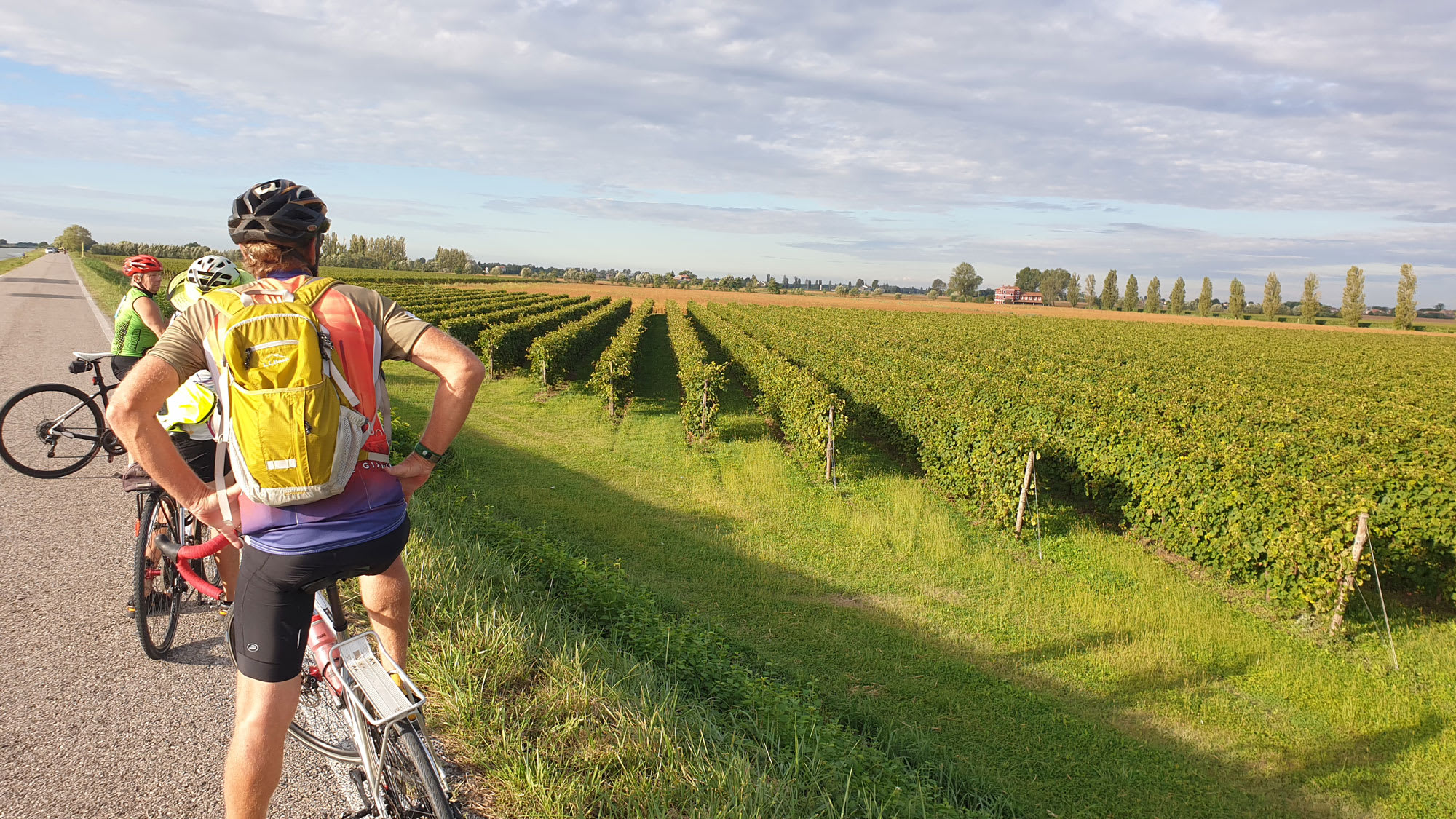
Passing vineyards in Italy
It has been a hard two years as riders and staff alike played a waiting game for the restrictions to end, for the world to open up, and to be able to ride our bikes across a continent again. In September, as the mist of Covid-19 started to disappear and we could see the TDA Trans-Europa on the horizon, everything was beginning to feel more positive.
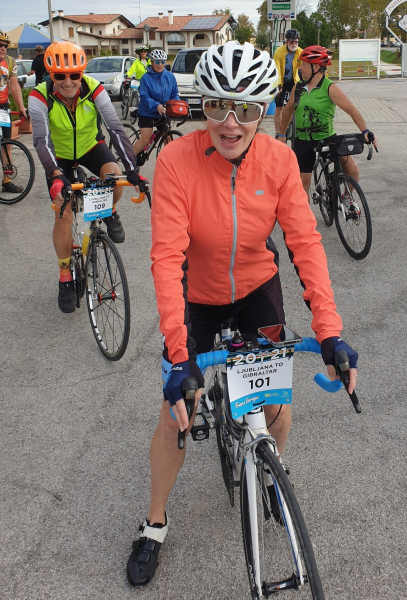
I asked the riders how they felt about being back on the road and Eve from Tucson said, “Beyond excited…we were literally pinching ourselves and saying is this true that were really here and its happening.” Simon from Ireland added, “Great to be back out, I’ve spent so much time in one place! To be able to go from place, to place, to place, feels great.”
We started out on a misty Ljubljana morning as 18 riders from around the world took their place for the obligatory start line photo. Then followed the sound of 18 pairs of clipless pedals popping in as the intrepid team turned and rode forward – 3035 kilometres to go until Gibraltar! The day started with a 50 km ride and a tough climb which saw some steep 15% gradients but everyone was smiling as they had lunch at the top of the climb. They were all happy to be back, happy to have reached the top and happy knowing it was all downhill from here!
Stacy Bailey told me “This is my first long tour, and it’s been really nice. The first day really exceeded my expectations with a steep mountain climb and a beautiful gorgeous descent that was really relaxing. The first day was lovely.”
The first ride ended as we crossed from Slovenia into Italy, from the Julian Alps into Gorizia and the home of good coffee and even better gelato! Everyone was smiling and the jubilant atmosphere matched the heights of the pass we had just crossed. It felt so great to be back on the road, to be riding in a new and exciting country, to pass borders without fear. TDA is back and perhaps even better than before as we now all know what a life with restrictions felt like, so now we would all make the most of each and every opportunity going forward.
]]>
Europe is opening up! The #1 worldwide destination for cycle touring is re-emerging and our Trans-Europa cycling tour is a great way to restart your cycle touring life, at an ideal time of year with our most experienced tour leader.
We recently announced that the tour will begin in Budapest in September. This felt like the tailwind that this tour needed and greatly increased the chances that the tour will be possible this year. We are all very excited for our return to Europe, the continent where cycle touring has been so popular for so long. Registration is open and our staff are happy to discuss the various options with you.
>>LEARN MORE: TRANS-EUROPA PRICING AND DETAILS

Travel Is Gradually Opening Up
“I love you guys and can’t wait to get back in the saddle again. Appreciate your optimism and hope trips can actually happen.”
COVID-19 is like a mosquito buzzing around our heads. It’s hard to ignore and it’s been hard to squash. But we are getting there. Canada’s Prime Minister is very hopeful for a two-dose / fully vaccinated September. The UK will be cautiously lifting some travel restrictions starting in May and the message seems to be that September is probably a realistic goal for leisure travel to mainland Europe. In the US, fully vaccinated Americans are looking more likely to be allowed (and welcomed) to travel to Europe by the summer and beyond. This is more reason for optimism and if you were considering Europe this year for a cycling tour, reach out to us.
Our Experienced Team Are Ready & Waiting
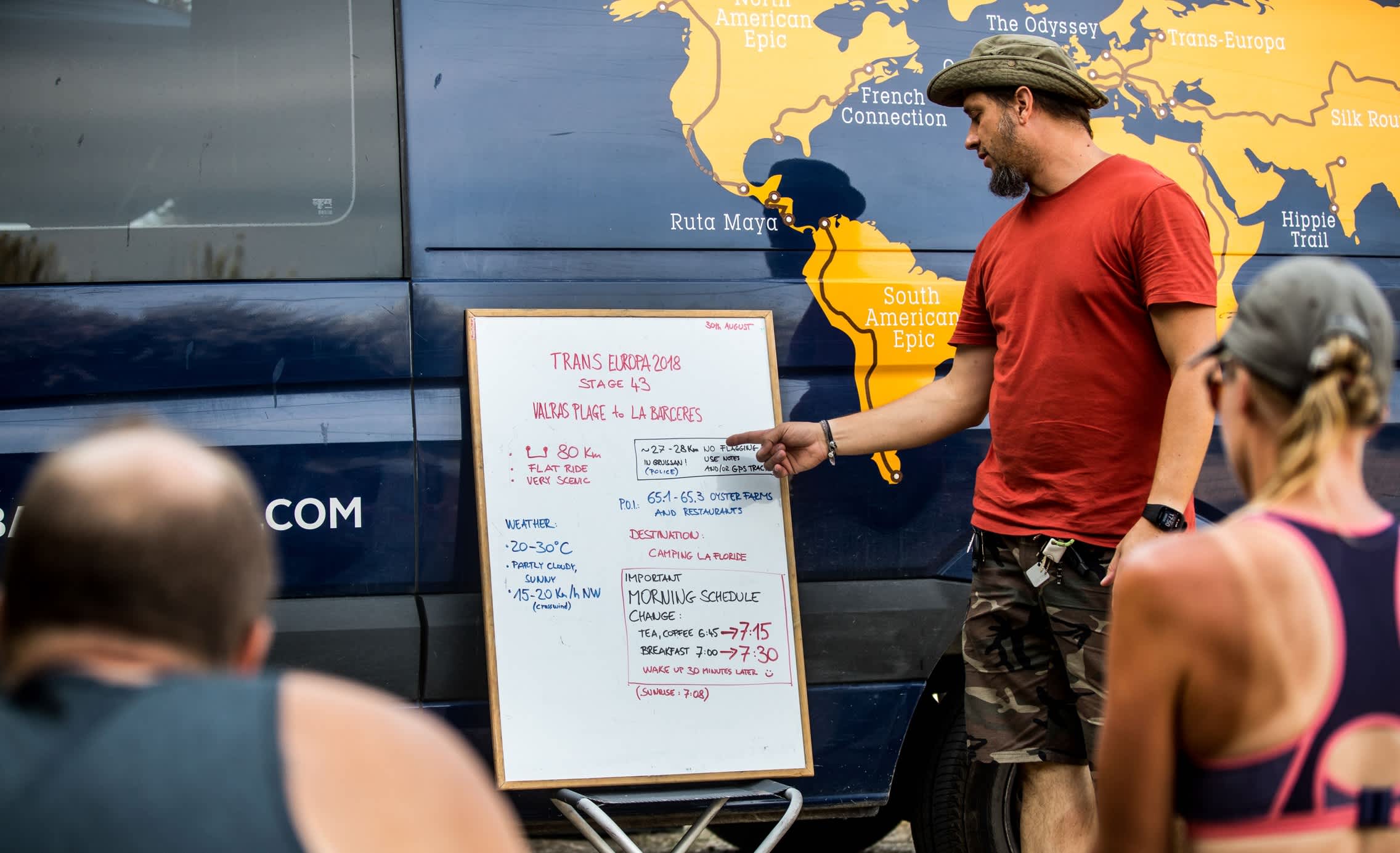
“Your staff (Gergo and Balazs) were fabulous.”
“Gergo was amazing”
“Very knowledgeable staff. Excellent trip routes. I can’t wait to travel with you again.”
Our longest serving tour leader, Gergo, is based in Budapest, where the tour will start. He has led hundreds of cyclists across Europe from Paris to Istanbul on the Orient Express, St. Petersburg to Lisbon on past Trans-Europa tours, and along the Pub Ride through the UK and northern Europe. He brings immense amounts of experience, local knowledge and stories of tours past. Gergo has even kindly offered to give a complimentary city tour of Budapest (by bike of course) two days prior to the start of Trans-Europa.
We Have New Safety Protocols
“I believe that TDA has done a marvellous job of navigating an incredibly challenging time. You have been responsive and sensitive to a fast changing, unsettled time. No doubt you will continue to move forward in spite of this difficult challenge. I truly hope that avid adventure cyclists return to taking on these unique trips offered by TDA.”
Over the past year and a half, as we waited for travel to restart, we have developed new policies and protocols to allow all our cyclists to feel secure that they aren’t being exposed to undue risk, while also ensuring that they can still enjoy all that we love about cycling – the freedom, the great outdoors, the people you meet along the way. Please take a look at our COVID-19 protocols page. We have made full COVID-19 vaccination a requirement for joining our tours and we are using our nearly two decades of experience in delivering high quality cycling tours in less than ideal circumstances to ensure this will be a fantastic and safe experience.
Experience Europe Before the Masses Return
Summers in Europe in popular cities like Venice were experiencing over-tourism before the pandemic and the travel industry as a whole has been giving some serious thought about how to fix some of these issues going forward.
As cycle tourists, we have always been fortunate that we aren’t shuttled between densely packed tourism highlights, but rather we get to see more of what is in between these points of interest, and who are the people that live in these places. In many ways we get a richer and deeper experience. But even for us, there are times where it’s hard to appreciate the sights when you find yourself clustered with other earnest travellers, all trying to have an authentic and meaningful experience.
By moving the tour out of the peak summer season and into September, we will not be seeing as much of the mass tourism that would take place in a normal year, but especially now, when some tourists are choosing not to travel to Europe at all. This makes it a unique opportunity to experience Europe without the busloads of tourists at each highlighted stop.
Ideal Weather In September

The weather will still be quite warm in September in the southern parts of France and Spain, but our chances of the oppressive heat waves lasting for days are greatly reduced. The nights get a little cooler and overall the weather will be more favourable for cycling and sight seeing in the afternoons and evenings.
We look forward to welcoming you to our tour as we restart our European cycling adventures in September.
RELATED
TOUR

Trans-Europa
Join us on this spectacular 2 1/2 month cycling adventure across Europe. The route passes through eleven countries, starting in Tallinn and finishing...
We recently made the decision to delay the start of our Trans-Europa tour until September 12th. Previously, it had been scheduled to begin in early July. We also moved the start line to Budapest, Hungary with our end destination remaining Gibraltar, where we will arrive on October 27th.
This change in schedule has greatly increased the prospects for the tour to run successfully, in terms of fully vaccinated North Americans being allowed to travel freely in Europe, as well as local populations having achieved a high rate of vaccination by the time of the tour. We feel this will all lead to an enjoyable, and in fact celebratory, return for ourselves and our participants to European cycle touring.
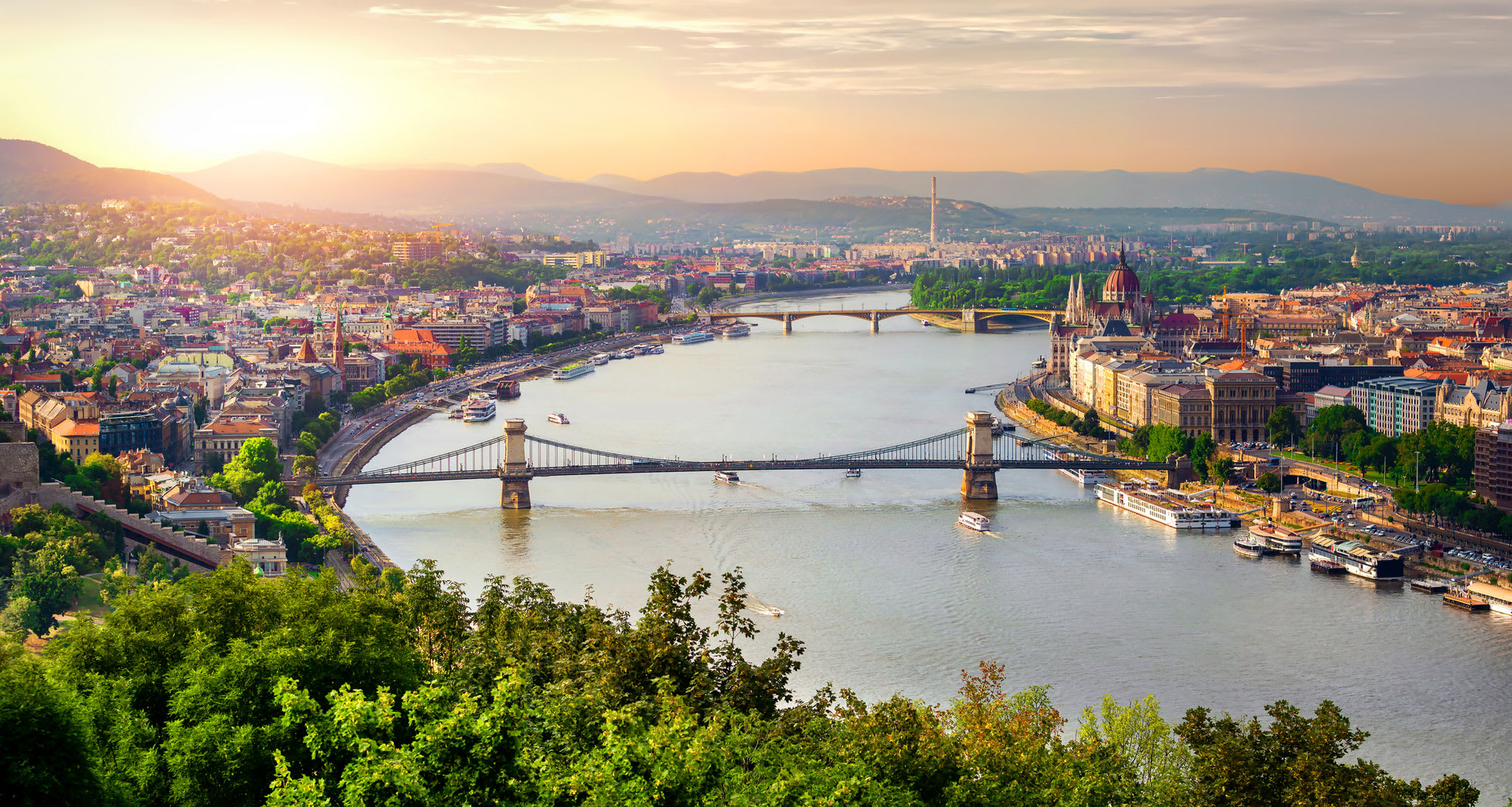
Budapest
Budapest is also the perfect place to start the tour in 2021. Our European Tour Leader and Route Researcher, Gergo Szanyi, who has been working with TDA since 2006, is Hungarian and based in Budapest. His knowledge of the city, it’s history and culture, and it’s bicycle routes is legendary. For those able to arrive a couple of days before the tour start, Gergo will happily take you on an exploration of the city by bike!
Our route from Budapest to Gibraltar remains unchanged from the original version of the Trans-Europa, and the route is packed with highlights. To give a taste of what you can look forward to, here are 6 exciting highlights, one from each of the 6 countries we’ll be cycling through.
Hungary – Cycling Lake Balaton
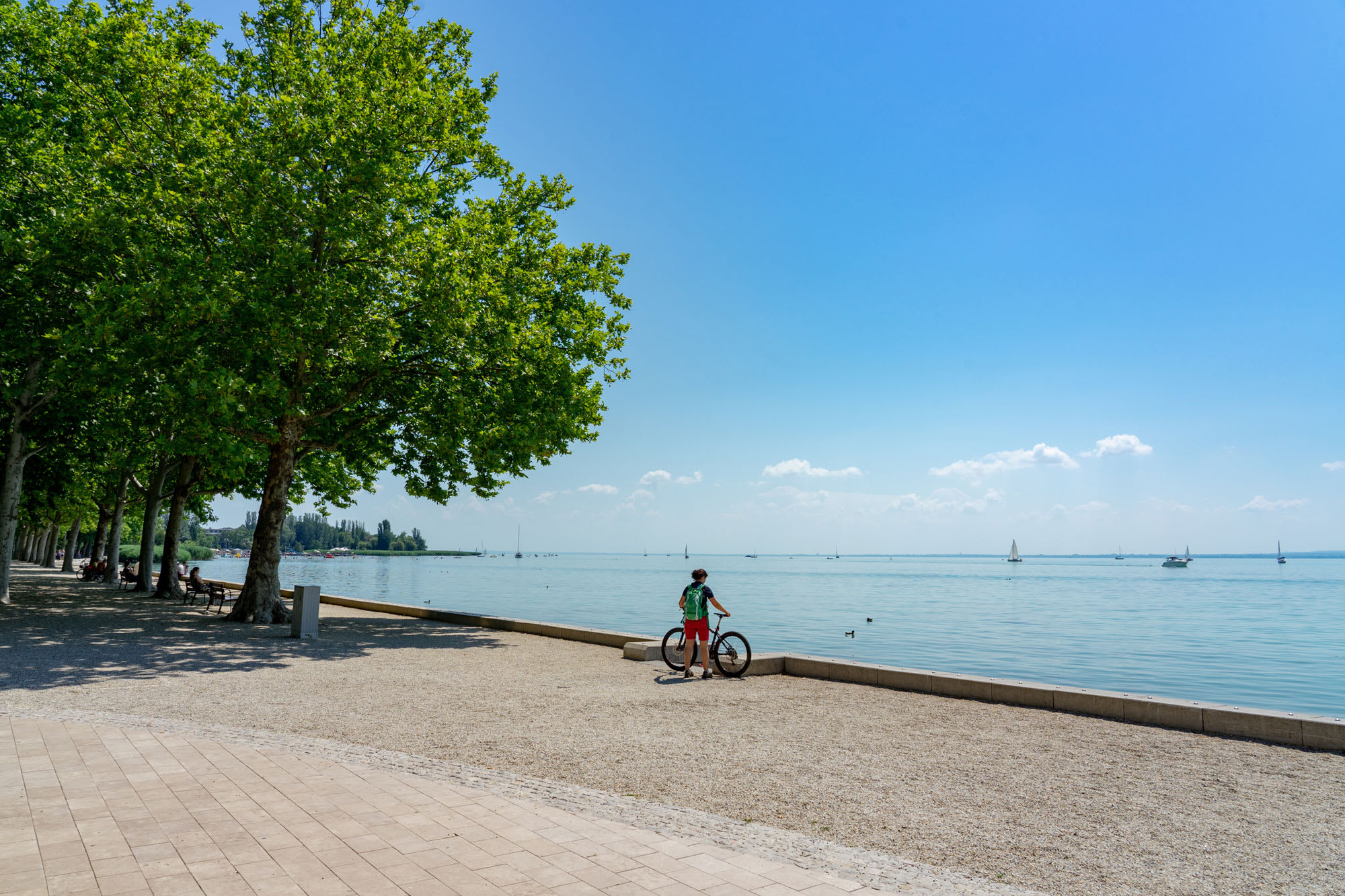
Lake Balaton
Slovenia’s – Ptuj
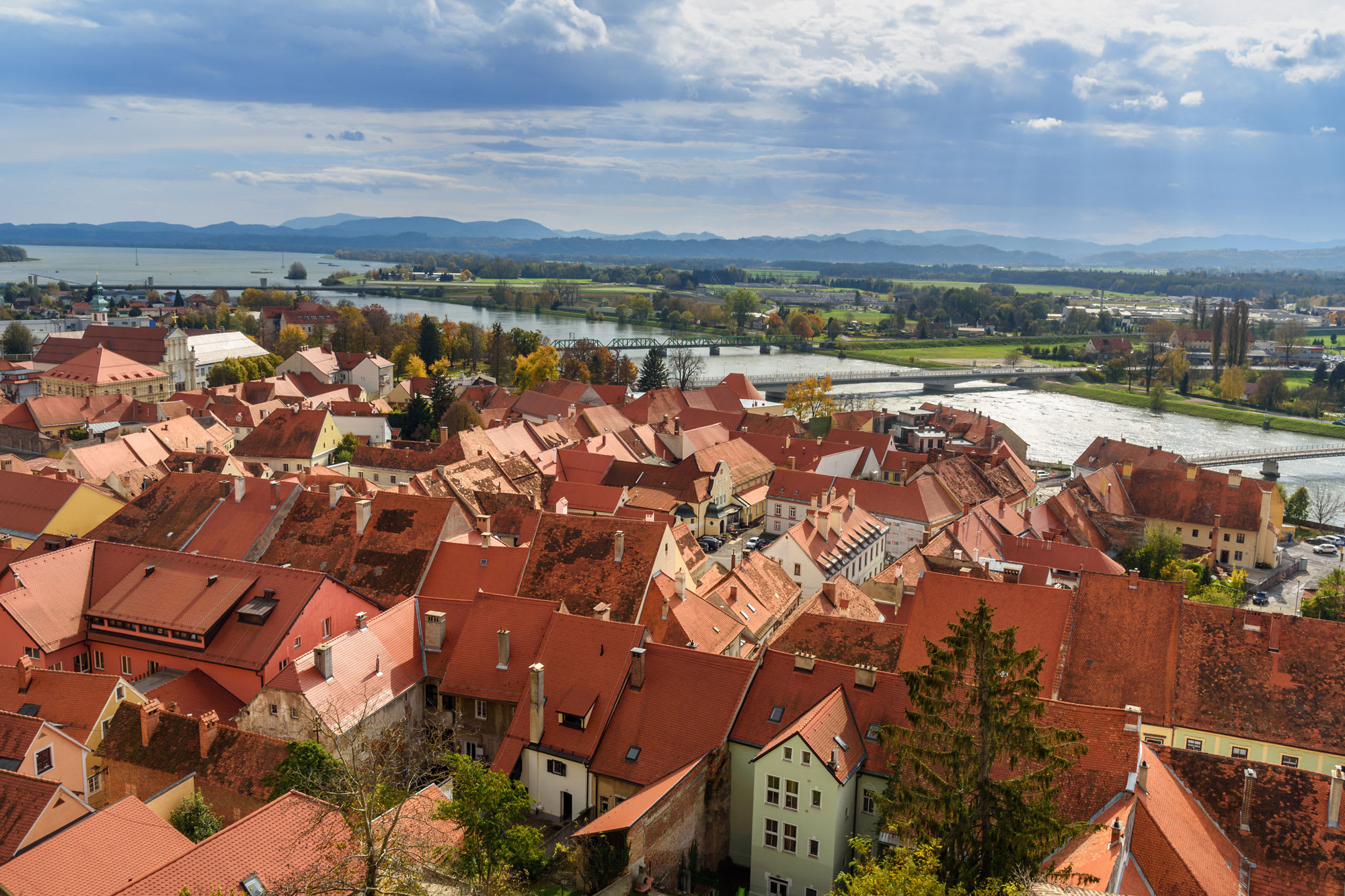
The country’s oldest city
Italy – Entering Venice By Boat!
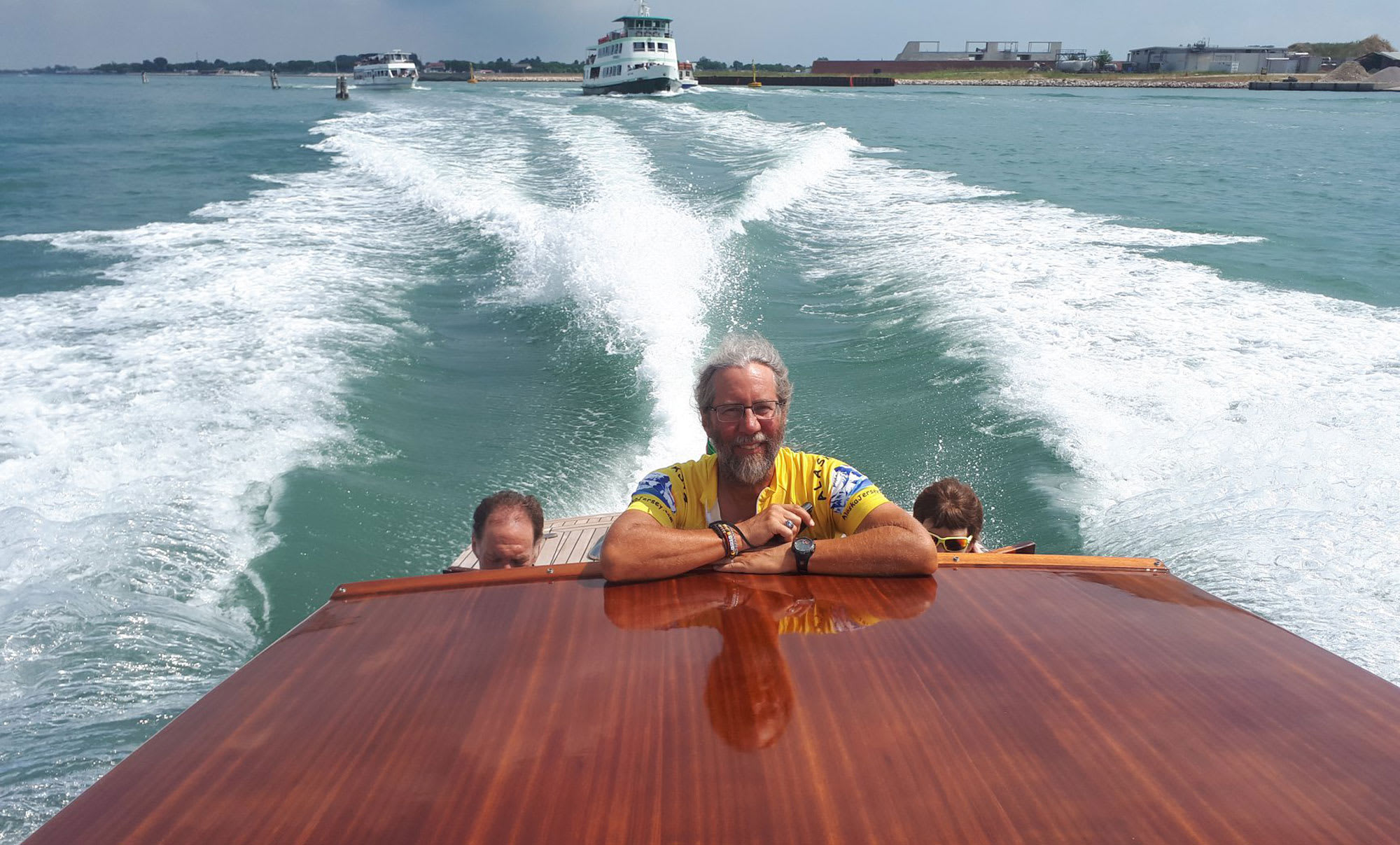
Entering Venice
France – The Incredible Scenery Of Provence
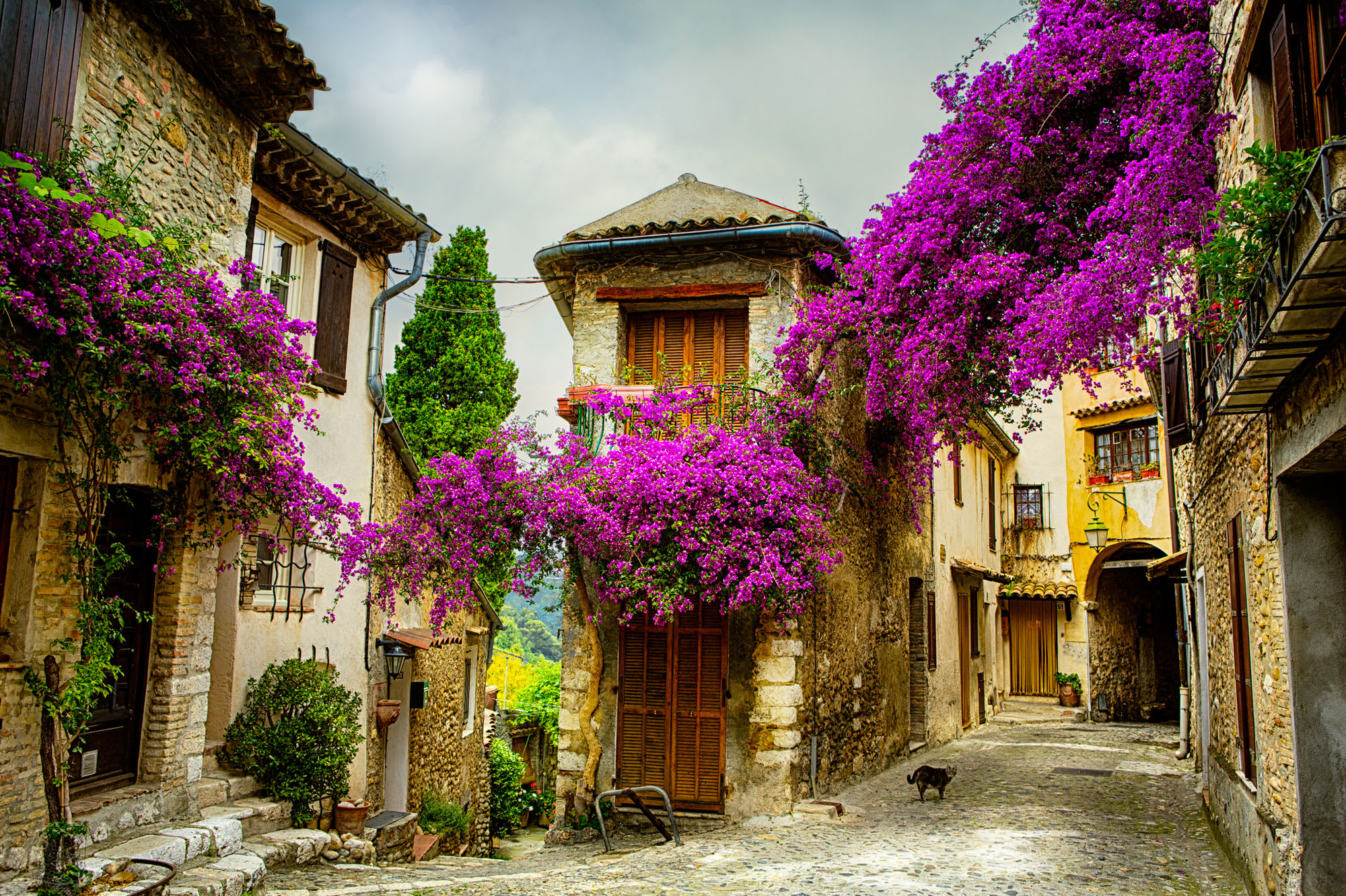
Old town in Provence
Spain – The Beautiful Beaches Of The Costa Brava
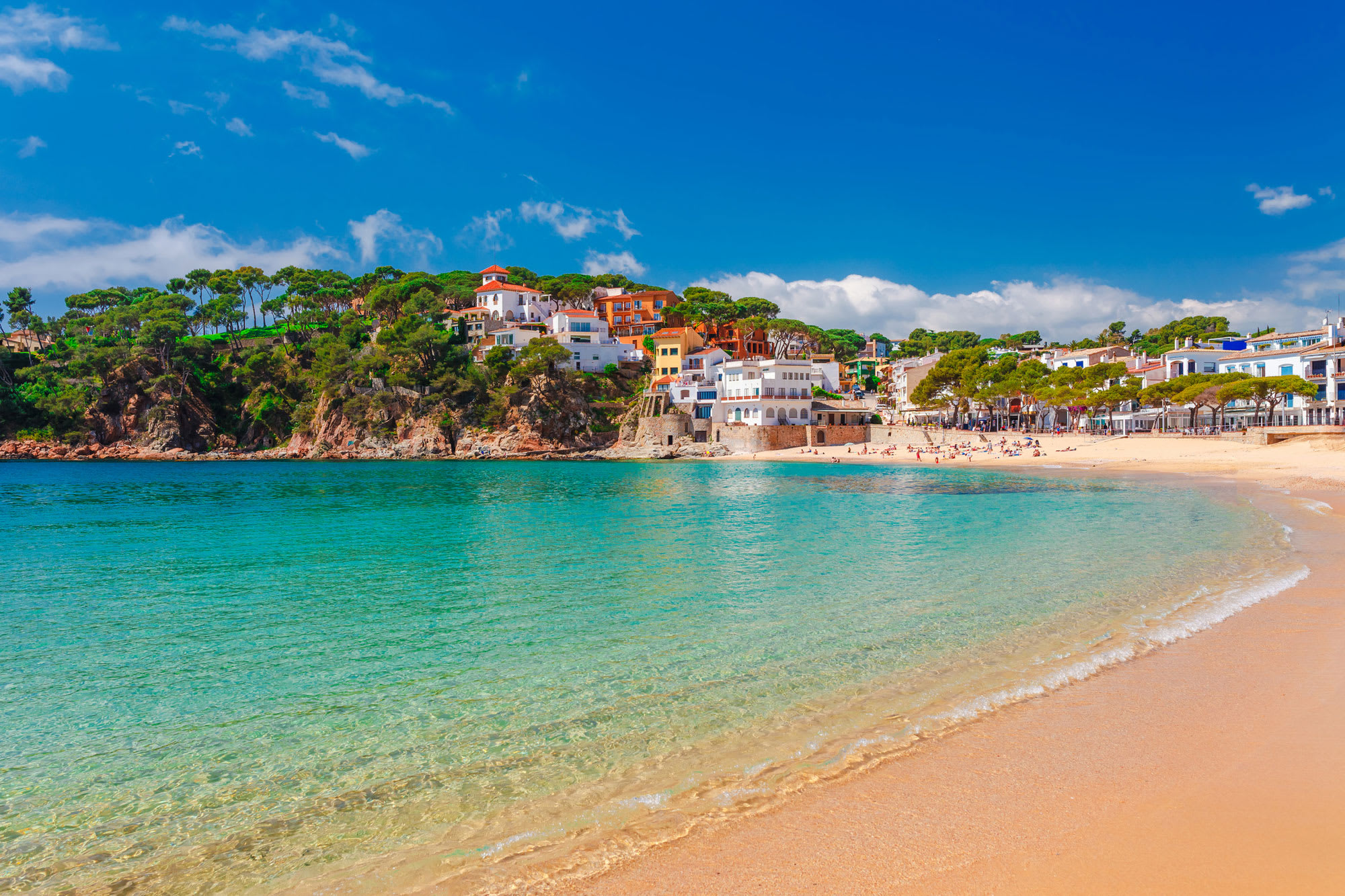
Costa Brava
The “Rock” Of Gibraltar
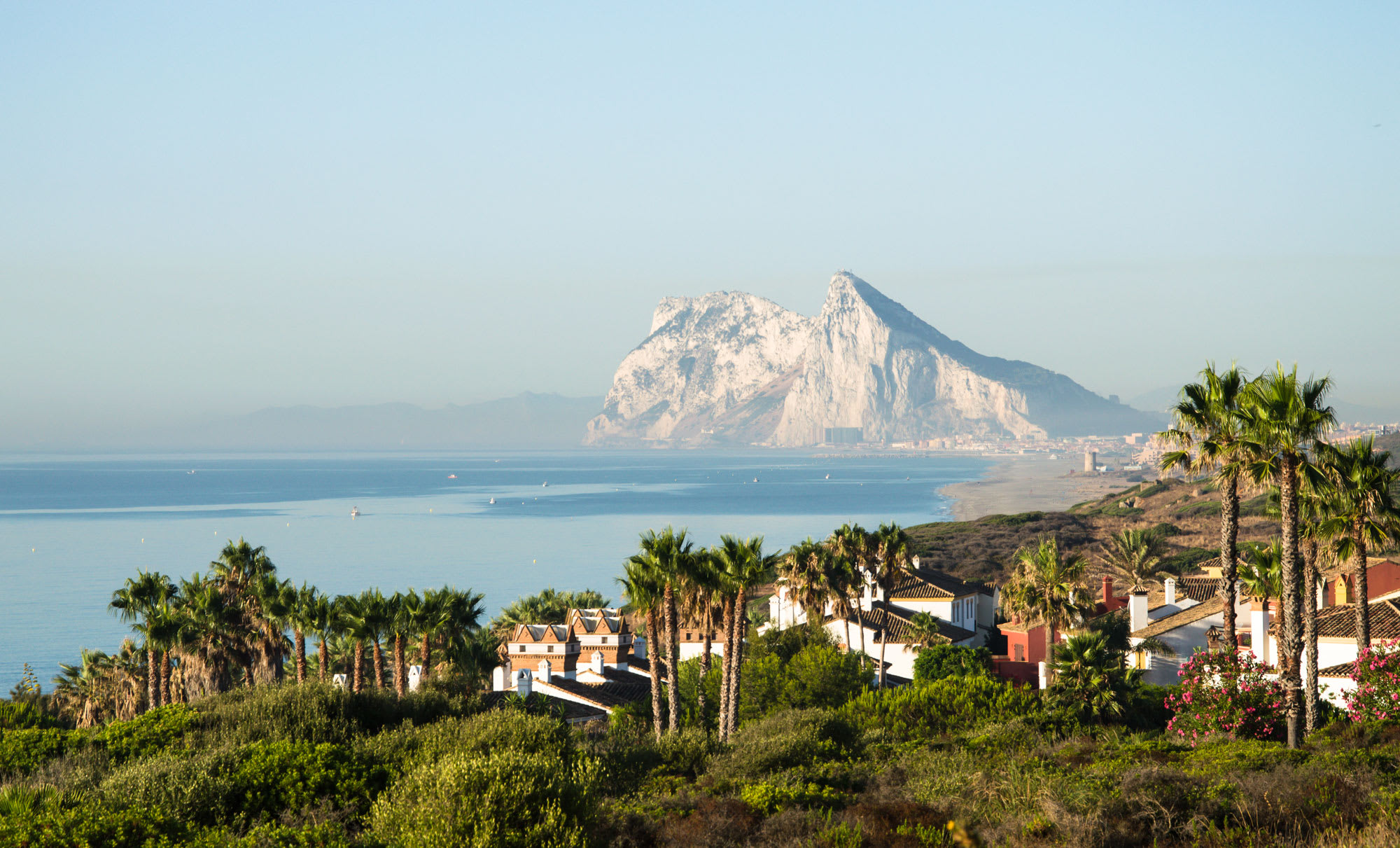
The ‘Rock’
RELATED
TOUR

Trans-Europa
Join us on this spectacular 2 1/2 month cycling adventure across Europe. The route passes through eleven countries, starting in Tallinn and finishing...
When we announced the 2020 Trans-Europa, it included a new route in Spain and a new finishing point at the rock of Gibraltar, making the Trans-Europa a truly cross-continental tour and the longest supported cycling trip in Europe. This just might be the year for you to jump on board.
If you can’t rustle up the three months to cycle it all, here are 5 reasons to consider joining the newest and final section – El Toro.
1. Barcelona
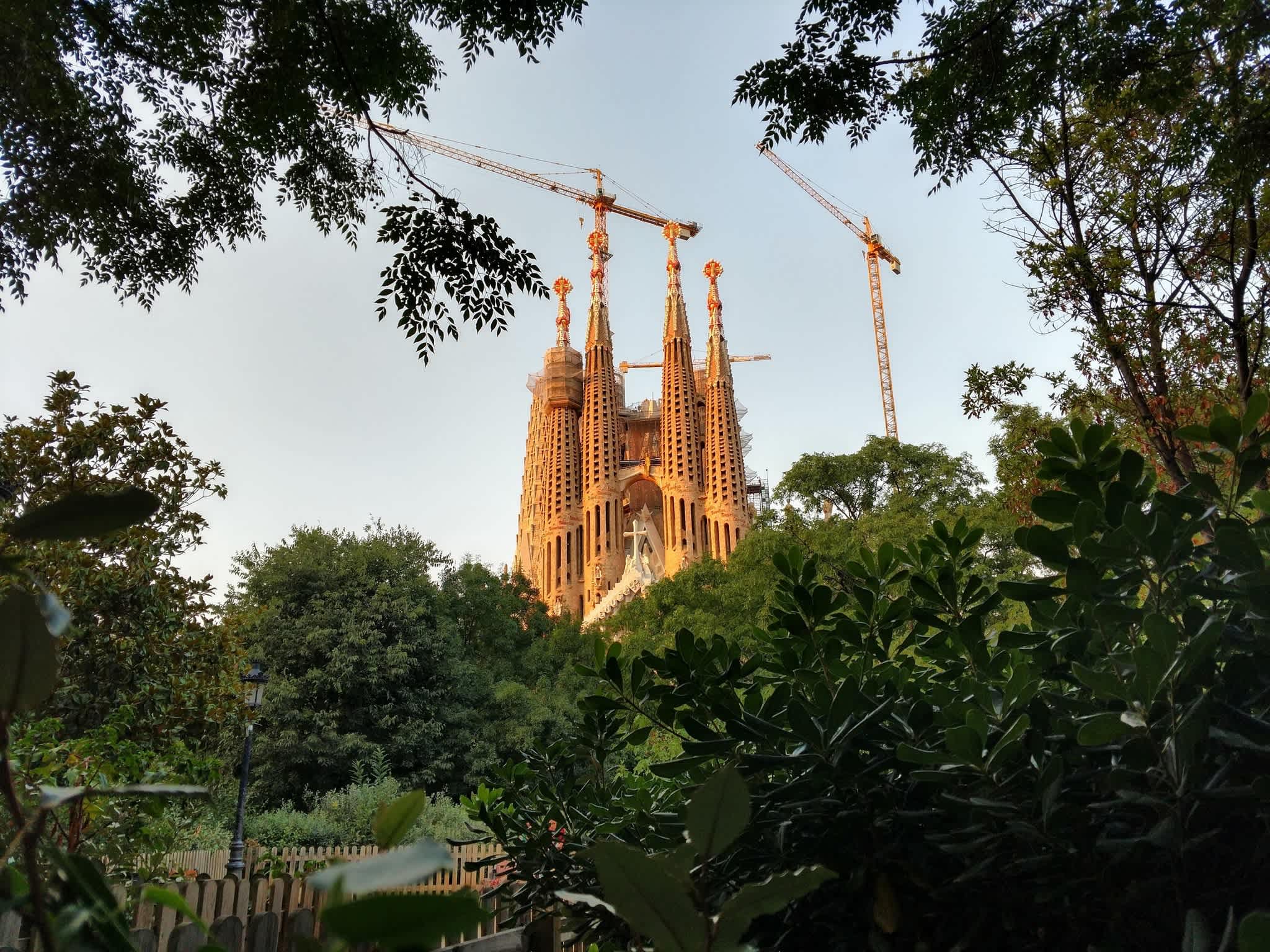
Barcelona makes a great starting point for this amazing new section – beaches, seafood, bars, culture and street life await you. The art of Antoni Gaudi dominates the city and its proud people are more likely to tell you they are Catalonian than Spanish.
“Barcelona is an enchanting seaside city with boundless culture, fabled architecture and a world-class drinking and dining scene.” – Lonely Planet
On my first visit, I was amazed with how walkable the city is and how much it has to offer – great beaches right in the city and amazing museums like the Museo Picasso.
>> Related: 36 Hours in Barcelona: A Cyclist’s Guide
2. Valencia, the Homeland of Paella
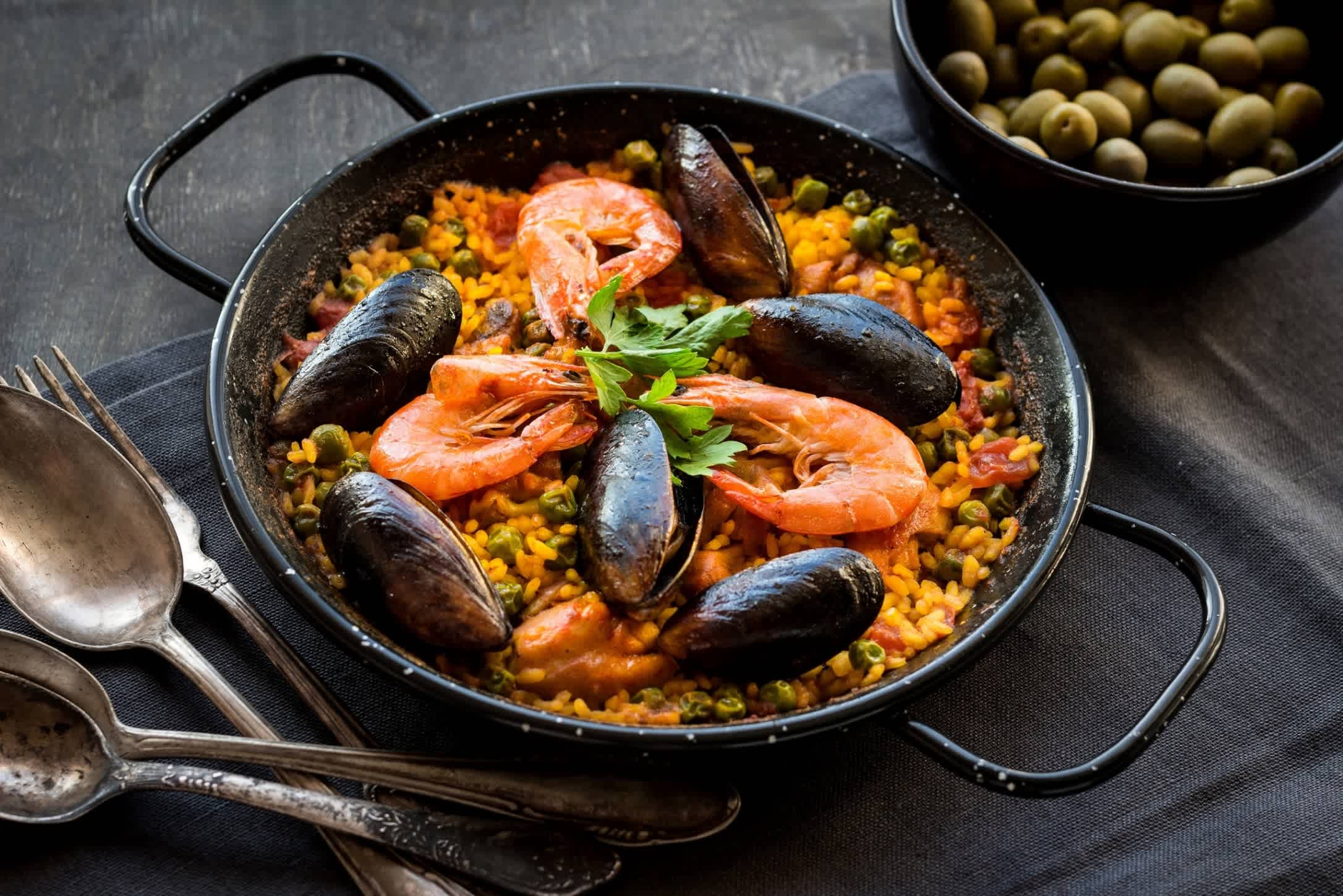
My time in Spain felt like an unending, but very enjoyable, search for the perfect paella, the yummy saffron and rice-based dish that you will find across Spain.
The region around Valencia is known for growing fruits and vegetables. Of course, oranges are grown here, but did you know Valencia is also “Paella’s homeland” according to Lonely Planet. I never had the chance to visit Valencia, but it’s a stop on the new and improved Trans-Europa.
3. Alhambra and Moorish History
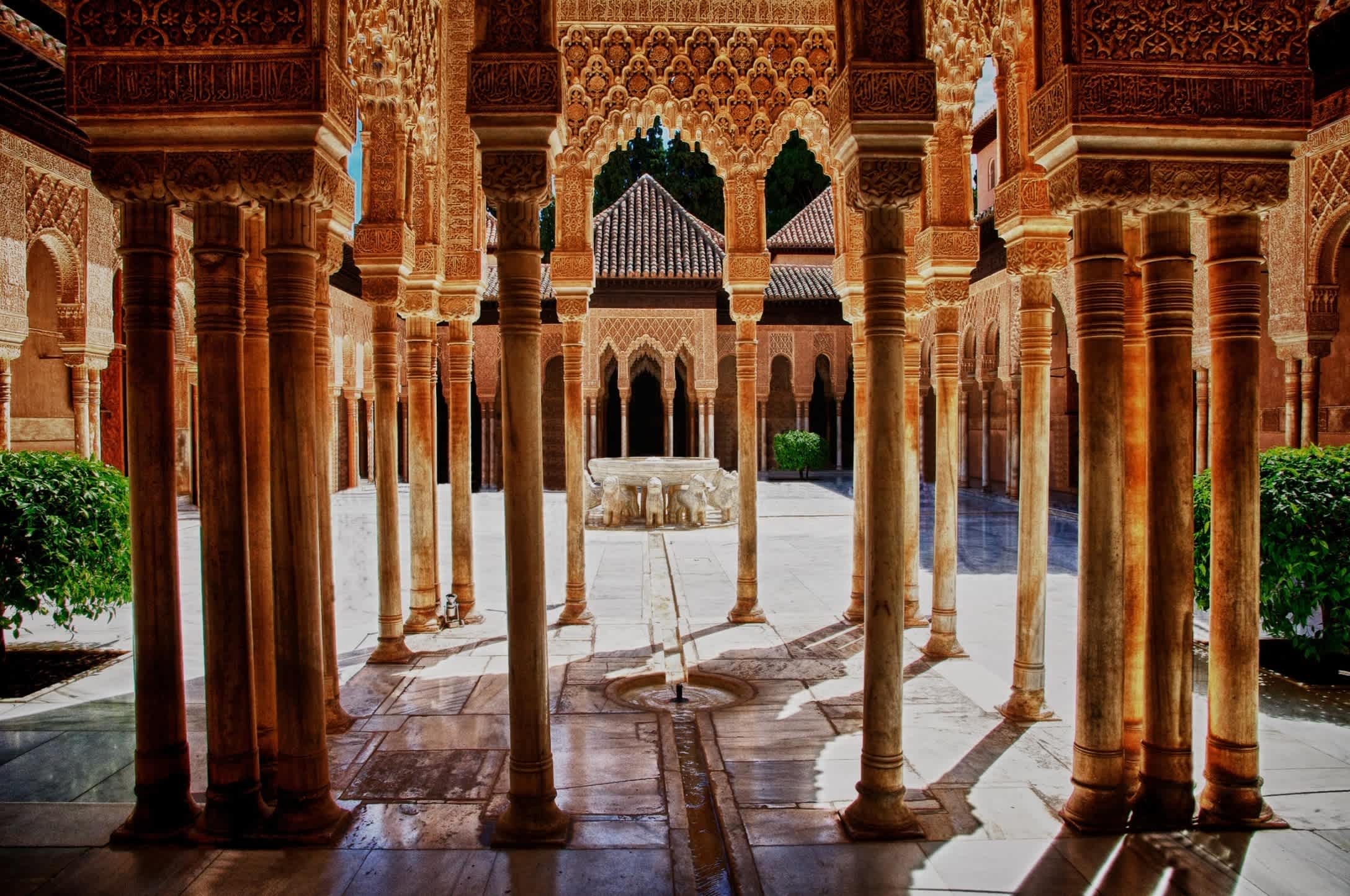
Most of the Iberian Peninsula, which makes up modern day Spain and Portugal, was ruled by the Moors from 711 until 1492 when the Moorish Kingdom of Granada surrendered to the Christian armies of Spain. The Alhambra became a Royal Palace and remains one of the most popular attractions in Spain.
4. Bull Fighting (and more) in and Around Ronda
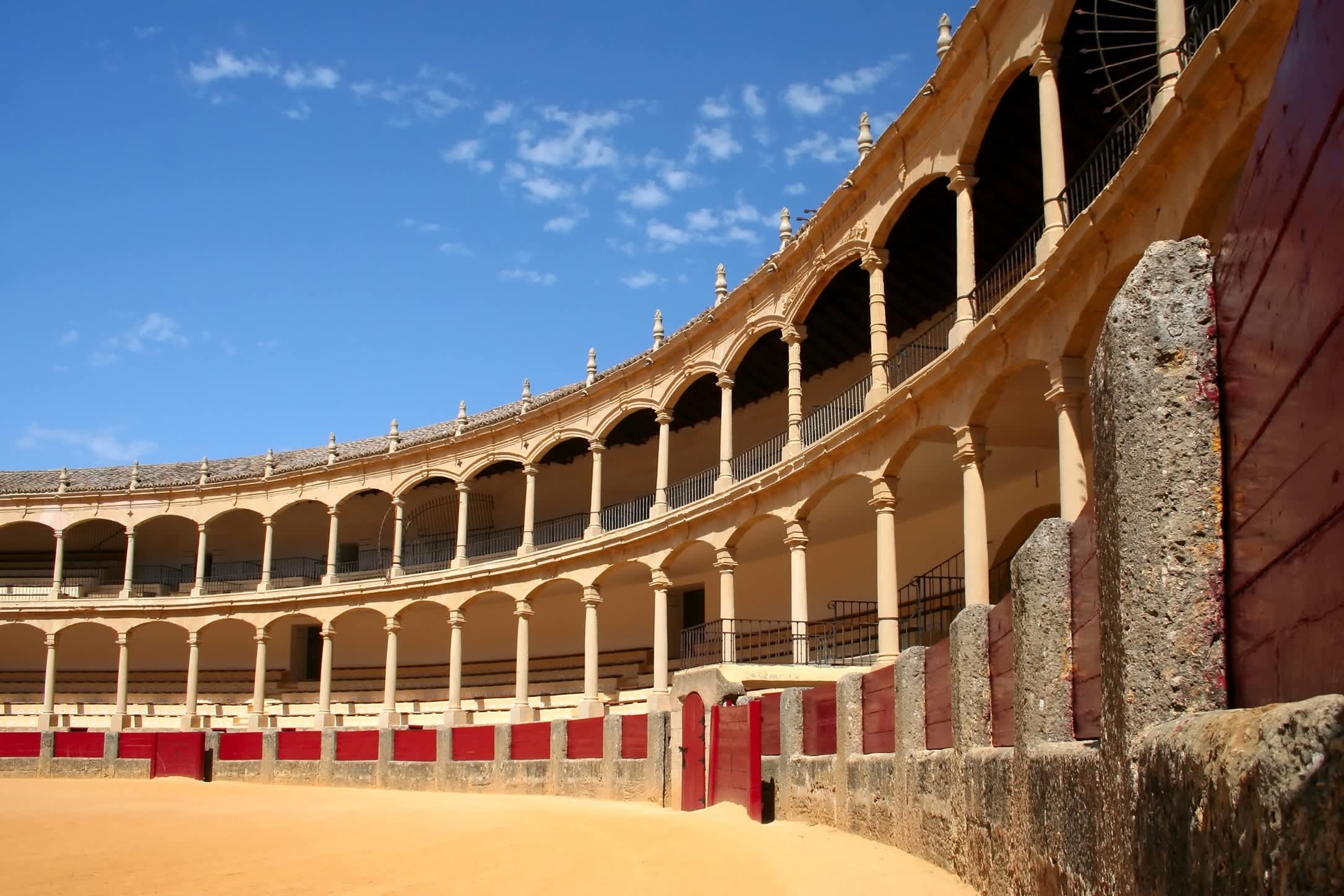
Some consider Ronda to be the birthplace of bull fighting. Home to the oldest bullring in Spain, the city was also a destination for some famous writers. Ernest Hemingway visited often and Orson Welles’ ashes are buried there. If bull fighting isn’t your thing, than you can spend some time in El Torcal de Antequera – a nature reserve known for its unusual landforms. According to Wikipedia, it is regarded as one of the most impressive karst landscapes in Europe.
5. Nothing Like Shoulder Season in Europe
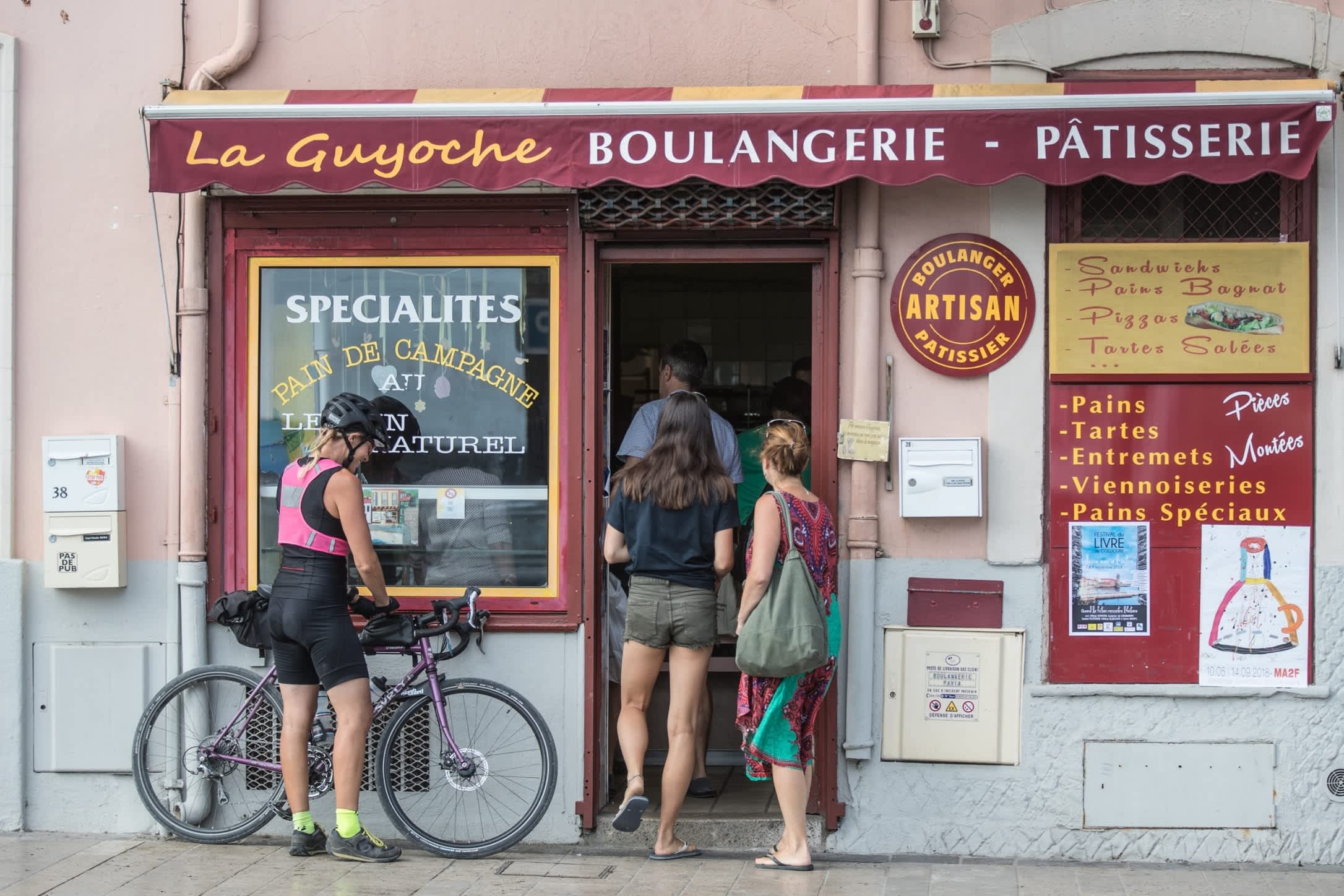
Cities like Tarragona, Valencia and Granada are all very, very busy during the summer months. On the Trans-Europa, you’ll feel travel-savvy visiting in late September, with its cooler temperatures and uncrowded beaches.
]]>
We are very pleased to announce that the dates and prices for the 2020 Trans-Europa are now online. We are happy to confirm 4 major changes to the route, changes that we feel confident will make an exciting experience just that much better.
1. A Return To St Petersburg

For the first 3 editions of the Trans-Europa, the ride started in St. Petersburg, Russia – the country’s old imperial capital, founded in 1703 by Peter the Great. For the 2018 Trans-Europa we decided to start the tour in Helsinki, Finland but in 2020 we are excited to return to St. Petersburg, the natural place to begin a cross-European cycling adventure. The participants should be sure to arrive few days early in order to enjoy some of the city’s spectacular sights – the unsurpassed Hermitage Museum, the baroque Catherine Palace, the incredible opera and ballet at the Mariinsky Theatre and the elaborate Church of the Saviour on the Spilled Blood.
2. A New Ending In Gibraltar

We are delighted to announce that the 2020 Trans-Europa will finish in Gibraltar. From the top of the Rock of Gibraltar, one can take in the Atlantic Ocean, the Mediterranean Sea, Europe and, across the straits, Africa. Its history spans over 2900 years and has been ruled by Phoenicians, Carthaginians, Romans, Visigoths, Moors, the Spanish and, finally, the British. Its strategic location has meant that historically, whoever controlled the territory, controlled the Mediterranean and, thus, much of Europe. In fact, you might be tempted at end of the Trans-Europa to hop on a ferry for Morocco and join the West Africa en Vélo which starts a week later
3. A Exciting New Route In Spain – El Toro

Changing the finish line for the Trans-Europa to Gibraltar gave us the opportunity to create an exciting new route through Spain. We called the section ‘El Toro’. From Barcelona the route travels south to Tarragona and its ancient Roman amphitheater before continuing on to Valencia, a city with a unique blend of modernist architecture and UNESCO historic areas. From Valencia, we will cycle slightly more inland, across the dry, rolling hills of southern Spain blessed with olive and orange trees, washing up in Granada, with its famous Moorish Alhambra Fortress. From there the riders will enter the final short stretch to Gibraltar, with its high limestone ridge known as the Rock of Gibraltar, where the cyclists can celebrate with some British fish and chips and a cold stout.
RELATED
TOUR

Trans-Europa
Join us on this spectacular 2 1/2 month cycling adventure across Europe. The route passes through eleven countries, starting in Tallinn and finishing...
4. All Hotel Accommodation

We understand that not everyone enjoys camping. As comedian Dave Barry once noted “It always rains on tents. Rainstorms will travel thousands of miles, against prevailing winds for the opportunity to rain on a tent.” That may be over-reaching a bit but even arriving to a dry tent after a long day of cycling can be a bit anti-climactic. Over the past few years we have slowly switched our European tours over to an all-hotel format, the latest being our classic Orient Express. The lone holdout has been the Trans-Europa…but no longer! In 2020, each of the 79 nights will feature a clean, well-situated hotel and a comfortable bed. No more tents and sleeping bags and opportunistic rainstorms. That is certainly something to celebrate.
]]>The 2018 TDA Trans Europa reached the finish line in Lisbon, Portugal last Friday, signifying the end of 5 full tour riders’ epic 2.5-month journey across Europe that began in early July. What’s really incredible about this year’s tour is that every single full tour rider achieved EFI. There are some difficult riding days on this tour and yet I can honestly say there wasn’t a single time that any of our riders even came close to contemplating getting in the van for a lift to camp.

Mark, from Juneau Alaska, did the full Tour d’Afrique a couple of years ago and decided to come back and do another one of the (in his own words, “slightly more luxurious”) 7 Epics. He’s a strong cyclist for someone who doesn’t ride much at home, enjoys a healthy mix of riding alone and riding with the group, and has an obsession with getting submerged in water. Whenever he arrived at camp or the hotel, Mark’s first mission was to head straight to the beach or find a local swimming pool. And after approximately 120km of riding each day, I’d say he’s earned it!

This was also Seatlite Rick’s second TDA tour, after riding from Victoria Falls to Cape Town on last year’s Tour d’Afrique. In fact, right before cycling out of Helsinki with the Trans Europa at the start of July, Rick did his own little self-supported cycling tour near Tromso in northern Norway with a dozen fellow cyclists who all met each other on the 2017 Tour d’Afrique.
As if he hasn’t had enough of the saddle yet, Rick’s now flown from Lisbon to San Sebastien, where he will cycle through France to Paris, and then take a train down to Italy to do another cycling tour from Rome to Como. We wish Rick the best of luck on his continued European cycling adventure!

Canadian and first-time TDA rider Scott’s achievement of EFI was especially remarkable because he was unfortunate enough to have some ongoing bicycle issues right around the middle of the tour. Luckily it never prevented him from riding the full day, nor did it prevent him from staying positive and enjoying himself throughout the tour. Upon reaching Lisbon, Scott celebrated by getting a couple of tattoos on his calves for his parents, done by a renowned Portuguese tattoo artist.

This tour was also a TDA first for Kiwi rider Jo, a.k.a. “The Aged Athlete”, who spontaneously signed up to the Trans Europa at the last minute and has really made the most of each and every day she has spent cycling from Finland to Portugal. Not only did she keep TDA staff on our toes (you couldn’t afford to dawdle too much while flagging or setting up lunch; because Jo was never far behind!) but her blog was always wildly entertaining and perfectly captured each day’s events for everyone following the tour back home.

And last but not least, Jeff did the TDA Pub Ride and TDA Trans Europa back-to-back, spending his entire summer riding his bicycle around the UK, Scandinavia, Eastern Europe, the Mediterranean and finally the Iberian Peninsula. Jeff was never in much of a hurry to get to camp, preferring to spend his day on the road, interacting with locals, stopping for Coke stops and searching for ice!
Jeff’s no stranger to bike touring, however normally he has to carry everything on his bicycle and plan his own route, so I think being able to explore Europe by bike with those things taken care of was refreshing. He also opted for his hammock over pitching his tent most nights, and thankfully we were extremely lucky with the weather on this tour so as long as he could find two sturdy trees, Jeff was good to go!
These people are very strong riders but beyond that, they have proved a point – cycling +100km a day isn’t as absurd and impossible as you might think. TDA has a vast range of alumni clients of all ages, sizes, backgrounds, fitness levels and head spaces. Just about the only thing every single TDA rider over the years has in common is that they were willing to push themselves to achieve what we often hear on these tours is “too far”, “too hard” and “too extreme”.
So to anyone whose only objection to signing up for a TDA tour is their lack of confidence in their own abilities, remember that half the riders on the 2018 Trans Europa were complete strangers to this sort of thing, and yet every one of them rode Every F*#^ing Inch!
Once again, congratulations to everyone who joined us on this year’s Trans Europa and keep riding!
]]>The sight of the sweep rider always produces mixed emotions amongst TDA riders. For some, it’s a huge relief. When you’re stuck on the side of the road on a hot day, feeling sick or standing beside a broken bicycle 50 km from civilization in any direction, spotting the sweep cycling towards you from the horizon means salvation. It means a fixed bicycle, or a first aid kit for that painful blister, or even a quick phone call to send the van back to pick you up.
On the other hand, if you’re the slightly more competitive type and enjoy being among the first few cyclists to reach the finish line each day, having the sweep roll up beside you while you’re snapping pictures on a scenic bridge or enjoying a coffee at a roadside “Coke stop” can be enough to make you spit your drink out in shock as you jump up from your table and scramble back onto your bike… I can’t be last! I can’t be!
We sweeps have learned not to take it too personally when riders panic at the sight of us – no one likes to be last. What’s great about the group of cyclists currently riding from Helsinki to Lisbon with the Trans Europa tour is that while they all have different paces, different riding styles, and different ideas on how they would like to spend their day between A and B, they all have something in common: they’re not in a rush.

Being sweep on this tour, you never know which riders you’re gonna come across. And with the current heat wave Europe is experiencing, frequent Coke stops are a must. Of course, Italian siestas can often throw a wrench in those plans if it’s after lunch, but it’s nice to see Trans Europa riders enjoying themselves and treating this tour for what it is – an expedition, a challenge, a test of one’s willpower, but a vacation as well!
A huge part of the TDA experience is interacting with locals, and there has been no shortage of this on the 2018 Trans Europa. One of the riders, Jeff, was having a “half-verbal, half-game of charades” conversation with an Italian shopkeeper the other day, and when the message eventually got delivered that we are cycling from Finland to Portugal, the shopkeeper slapped his palms to his cheeks and yelled, “Mamma Mia!” Jeff arrived at camp later and said, “Wow, I didn’t think they actually said that here…”
Even in the Baltics, back at the beginning of the tour, passing through countries that are often unfairly perceived as being slightly inhospitable or unfriendly, we received nothing but warm reception from the locals. And while the majority of our rest days have been in popular cities that see a huge number of tourists passing through every year, the places we cycle through in between certainly don’t.

With ever-increasing competitiveness between budget airlines resulting in ludicrously cheap flights throughout Europe, flying from London to Budapest to Riga to Paris to Madrid to Berlin has never been more affordable or more convenient. And here lies the problem – Europe’s true gems aren’t the capital cities. They are the in-betweens that you’ve never heard of; they are the Augustows, the Sandomierzes, the Bardejovs, the Hollokos, and the Bobbios… all the places you tend to disregard when you look at the itinerary before the tour as simply, “on the way to Warsaw” or “somewhere between Budapest and Venice”.
Even after 5 TDA tours I’m guilty of making this mistake – I came into this tour with the attitude that I knew Europe, I’ve spent a lot of time here, I’ve seen it all before. How humbling it’s been to pass through some of the most beautiful towns, countryside and cultures I’ve ever experienced, in a continent I thought I knew well.

As for the Trans Europa riders, some of whom had never set foot in Europe before this tour, it’s nice to see that they are all making the most of their time here and enjoying the experience as we pass the halfway point of this epic journey from Helsinki to Lisbon.
]]>TDA has a knack for making every tour different from one edition to the next. Whether it’s the Tour d’Afrique, Bamboo Road or South American Epic, the route tends to change slightly from year to year, just to keep things interesting.
This year, for example, the Trans-Europa started in Helsinki, not St Petersburg. This posed a bit of a logistical problem: our first stop after Helsinki is Tallinn… so how do you make day one of a cycling tour interesting when the very first thing you’re doing is getting on a 2-hour ferry across the Baltic Sea? And also, surely Tallinn – a vibrant city with one of the most authentic old towns in all of Europe, somehow juggling a bustling modern city centre with a medieval vibe peppered through its ancient streets – merits a full afternoon and evening of the tour, so the riders can experience it properly?

TDA came up with a solution that not only ensures riders get the full Finnish and Estonian experience, but also ensures that the 2018 Trans-Europa riders get a chance to warm up and ease into the tour with a relaxed first stage, which is excellent when you’ve got 60 more before you arrive in Lisbon.
After a substantial all-you-can-eat buffet breakfast, the fresh-faced riders gathered out the front of the hotel for a 3-hour cycling tour of Helsinki, run by a lovely Austrian girl named Daniela who knows just about everything there is to know about Finland.

Daniela led us around town, showed us all the sights, and talked us through the interesting history of Europe’s north-easternmost country. We swung by Helsinki Senate Square (seemed like an appropriate spot for the start line photo), cycled around a few of the capital’s stunning lakes and through its lush central parks, and made our way to the seaside markets via some fascinating historical monuments and state-of-the-art building designs (some of Helsinki’s more modern buildings have some very unique architecture).
Finland’s excellent cycling infrastructure made riding around town a breeze, the sun was shining, and the fact that it was Sunday morning meant the streets were relatively quiet. We bid Daniela farewell around noon and sat by the busy port eating local delicacies like reindeer meat and salmon mousse while watching giant ferries come and go from Sweden, Denmark, Germany and beyond.

The riders had the afternoon to themselves and then everyone met for dinner, taking a relaxing stroll to a traditional Finnish restaurant directly opposite Helsinki Senate Square, our first stop of the morning’s cycling tour. After a brief history lesson of the restaurant’s origins as one of Helsinki’s oldest buildings, we enjoyed a three-course meal of a strange cold green mint soup thing (it was much more delicious than I’ve made it sound here…), salmon steaks with roast vegetables (the Finnish sure love their fish!) and a combination of mixed berries and ice cream for dessert. With everyone having a chance to get to know each other a little better before the 100 km+ days start, it’s been a very nice way to begin a TDA tour. Now it’s onto the Baltic States and Eastern Europe!

This is the fifteenth, and final, entry in our ongoing series of blogs highlighting the cities along the route of our Trans-Europa cycling tour. Each year we have brought our cyclists to these cities and have learned a few new useful tips for those who might be considering heading there. So whether you are thinking to join our tour or plan on cycling there yourself, we hope this information will be helpful.
Lisbon
“Between the historical landmarks, majestic surroundings, and a food culture that stands out of the crowd, it’s possible to spend a month in Lisbon and discover something new every day.” – Culture Trip
Infrastructure
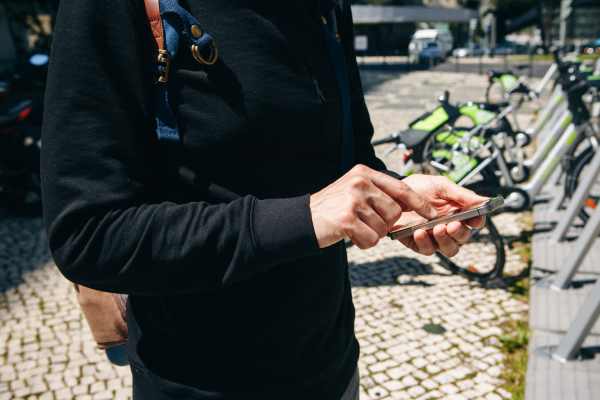
The city boasts about 100 km of bike lanes. Currently, not all are connected but the city is working to create a better cycling environment. Along Lisbon’s waterfront there are around 20 km of bike lanes on flat terrain, from the City Centre east towards Parque das Nações and west to the area of Belém.
In case your bike needs TLC or a day off, Lisbon has a bike share system – Gira. The network consists of 100 stations and 1200 bicycles. You can download the app to your phone or use a credit/debit card to use the system. The first 45 minutes are free, with each additional 45 minutes costing €2. You can see the system map here.
Lisbon has number of bicycle rental outlets. Give Lisbon Bike Rentals a try. They have a wide variety of models available.
The city is conveniently located on the EuroVelo network – EuroVelo #1 – Atlantic Coast Route.
Support
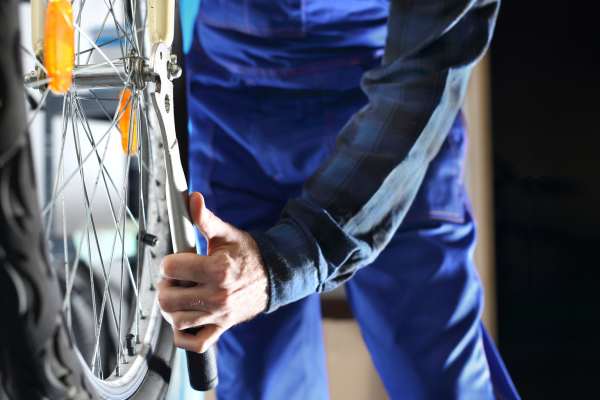
Is your bicycle sounding a little off? Lisbon has a number of quality bike repair shops. Lisbon Bike Shop is worth looking up. They have a workshop with two mechanics for the repair and maintenance of bicycles.
>>Learn more about our Trans-Europa bicycle tour that includes Lisbon
Sightseeing
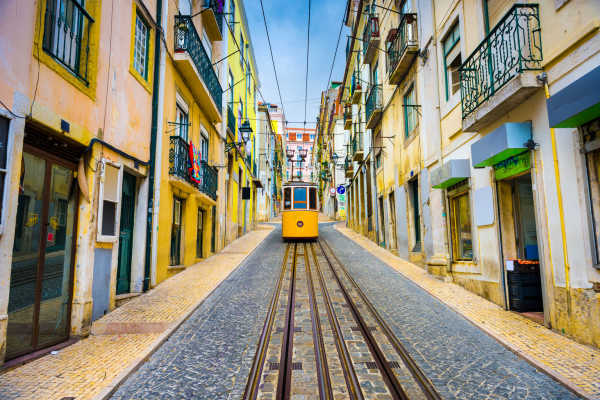
The best way to see any city is by bicycle and this is especially true of Lisbon. You can order a handy guide to the best cycling routes in the city or sign up for a group tour. Many companies offer the traditional city tours (most on e-bikes) but for something different, try a vintage bike tour of Lisbon. Explore Lisbon’s famous and less-famous neighbourhoods on a vintage bike. Roll past the friendly faces, little shops and enjoy some of the great views Lisbon has to offer. Hop on and off when you wish and reach places that are hard to reach in other ways. Weave your way through Lisbon’s local and global character and enjoy some of its typical snacks and drinks along the way. It is a lively journey to explore the different faces of Lisbon. Best of all, there won’t be any tough climbing since the tour starts at a rather high spot in the city! It will actually be more downhill and flat.
Rest

Cyclists looking for bike friendly accommodations should head to the Neya Hotel. They have a secure bike storage floor, provide bikes and tools if necessary and encourage their staff to cycle to work.
Campers can stay at Lisboa Camping & Bungalows. About 8 km for the centre of town, they have a large wooded area for camping, mini-golf, tennis court, restaurant, pool and bicycle rental.
Eat, drink, relax
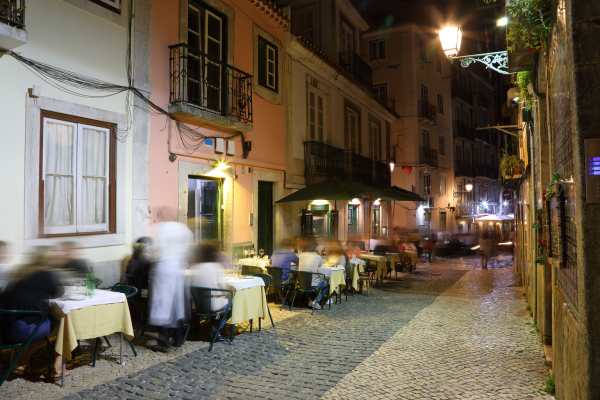
After spinning up and down Lisbon’s hills and probably working up quite a thirst, riders should head to the Pensão Amor for a drink. What used to be a guesthouse that rented rooms by the hour to prostitutes and sailors is nowadays available to artists or people with projects who need a space to display the project in progress. There is a café/bar that can be used as a space for concerts, lectures and other events. There is also a bookshop with a love/eroticism theme and, of course, a hairdresser. Wonderfully atmospheric, the bar serves a great selection of beers, wine, spirits and cocktails and guests are further entertained by regular live music performances in an adjoining salon, burlesque shows and clean and tasteful pole dancing exhibitions.
For a bite to eat, spin through Lisbon’s narrow laneways until you come to Porto Alfama, a cozy place to grab lunch with some wonderful outdoor seating. It is a wine bar and a specialized shop where you can taste a wide range of Portuguese wines and have a light meal; tapas, salads, appetizers or traditional Portuguese canned food items, like sardines and other fishes. For something a little more upmarket head to Bairro do Avillez. This beautiful open space includes a grocery store with irresistible delicacies, an amazing Tavern for those who like to eat well, a Páteo where seafood and fish are kings, Beco, a place wrapped in mystery where you cross high-cuisine with a theatrical show and a Peruvian Cantina, where you can find the authentic flavours of Peru, as well as the Pisco Bar Lisboa, serving the best Peruvian cocktails.
The Trans-Europa in Lisbon
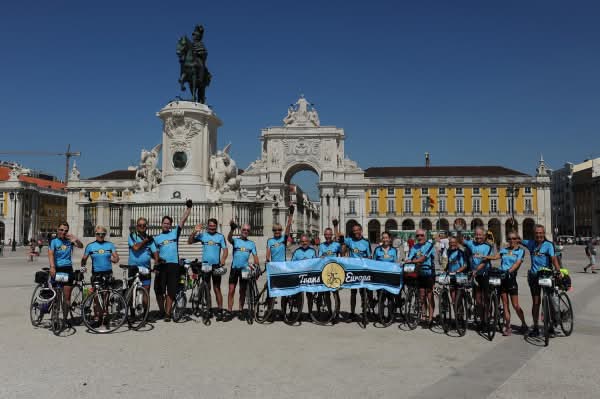
The riders of the Trans-Europa cycle into Lisbon in a short convoy and stay at the welcoming Hotel Lisboa.
For more information on Lisbon, please see How to Spend 48 hours in Lisbon
Experience Lisbon on the 2018 Trans-Europa Cycling Expedition.
Read all our previous posts in the series – Helsinki, Riga, Vilnius, Warsaw, Košice, Budapest, Ljubljana, Venice, Genoa, Cannes, Montpellier & Barcelona, Madrid & Caceres.
]]>This is the fourteenth in our ongoing series of blogs highlighting the cities along the route of our Trans-Europa cycling tour. Each year we have brought our cyclists to these cities and have learned a few new useful tips for those who might be considering heading there. So whether you are thinking to join our tour or plan on cycling there yourself, we hope this information will be helpful.
Cáceres
“Narrow cobbled streets twist and climb among ancient stone walls lined with palaces, mansions, arches and churches, while the skyline is decorated with turrets, spires, gargoyles and enormous storks’ nests.” – Lonely Planet
Infrastructure
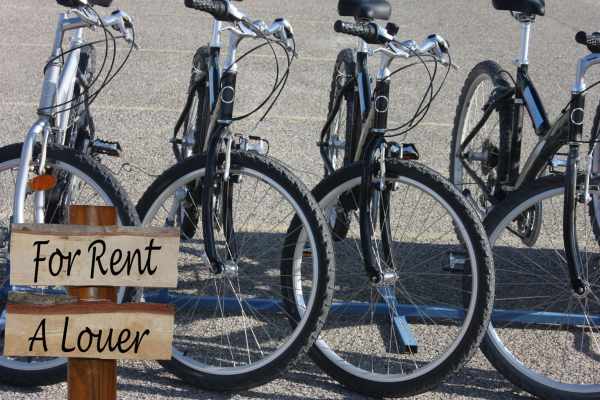
Cáceres has a limited number of bicycle rental outlets. Try La Bicicleta for city, mountain and road bikes. Deposit required. Closed Sundays.
The city is conveniently located on the EuroVelo network – EuroVelo #1 – Atlantic Coast Route.
Support

Is your bicycle sounding a little off? Cáceres has a few bicycle repair shops. Try Bicicletas Pelin. Open 10:00 – 20:00 Monday to Friday, 10:00 – 14:00 Saturday. Closed Sunday.
>>Learn more about our Trans-Europa bicycle tour that includes a rest day in Cáceres
Sightseeing
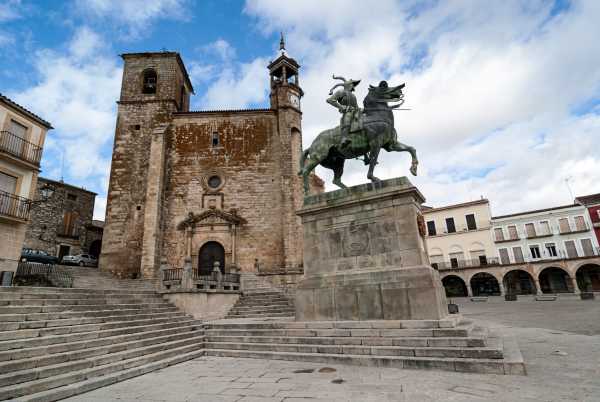
The best way to see any city is by bicycle and this is especially true of Cáceres. While there are no organized cycling tours in town, you can easily spin through the old town. Start at the Plaza de Santa Maria, surrounded by medieval palaces, elaborate Renaissance facades a dramatic Gothic cathedral. Pedal through the narrow laneways, under the 18th-century Arco de la Estrella and into the Plaza Mayor. Within a few blocks you can also see many more historic plazas, palaces, towers, museums and churches.
Rest

Many of Cáceres’s hotels welcome cyclists and will be able to offer storage rooms and bike racks – check before you book.
Campers can tent at Camping Cáceres. Just a 20 minute bike ride from the old city, it offers a private bathroom for each campsite. The campsite also features a large pool, a restaurant with a large outdoor terrace, laundry facilities, free wifi, library and a spa.
Eat, drink, relax
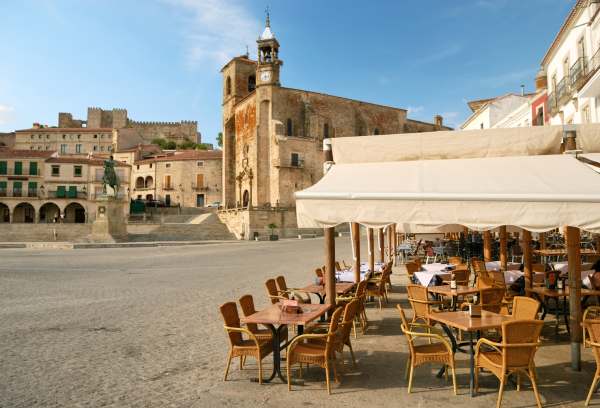
After a day (or 2) of exploring this city’s incredible history, it is time to eat. Cáceres is a place of genuine flavours and simple preparation, reflecting the city’s proximity to rural Spain. Local dishes include migas, a rustic fry of breadcrumbs, garlic, bacon, chorizo and peppers, and lamb caldereta, a shepherd’s dish flavoured with rich and smoky pimentón de La Vera – paprika, the star spice of Extremadura. Try El Figon de Eustaquio. Run by the same family for 75 years, you can order venado de montería (wild venison) or perdiz estofada (partridge stew) and compliment the food with some extraordinary local wines.
To end the evening pedal over to the El Corral de las Cigüeñas. Difficult to find (there are no signs – ask a local), this spot is in the centre of the old town, surrounded by ivy-covered stone walls and covered by swaying palm trees. It features an incredible wine list, decent and inexpensive drinks and live music.
The Trans-Europa in Cáceres
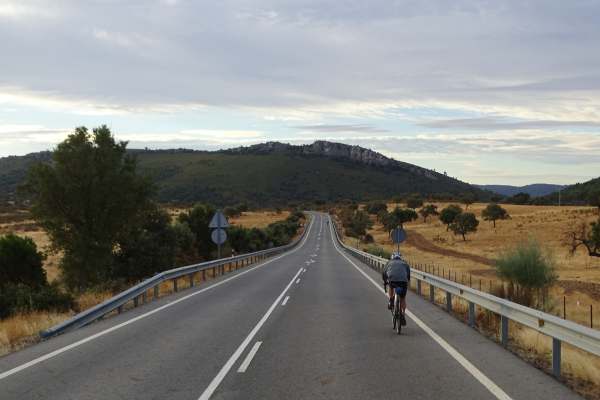
The riders of the Trans-Europa cycle into Cáceres through some hilly terrain to the east, pulling up to the charming Hotel Casa Don Fernando, situated right on the Plaza Mayor. The next day they continue west on the way to the finish line in Lisbon. Be sure to check out our ‘Cyclist’s Guide for Lisbon’ coming soon.
For more information on Cáceres, please see How to spend 48 hours in Cáceres, Spain.
Experience Cáceres on the 2018 Trans-Europa Cycling Expedition.
Read all our previous posts in the series – Helsinki, Riga, Vilnius, Warsaw, Košice, Budapest, Ljubljana, Venice, Genoa, Cannes, Montpellier & Barcelona and Madrid.
]]>This is the thirteenth in our ongoing series of blogs highlighting the cities along the route of our Trans-Europa cycling tour. Each year we have brought our cyclists to these cities and have learned a few new useful tips for those who might be considering heading there. So whether you are thinking to join our tour or plan on cycling there yourself, we hope this information will be helpful.
Madrid
“No city on earth is more alive than Madrid, a beguiling place whose sheer energy carries a simple message: this city really knows how to live.” – Lonely Planet
Infrastructure

The city boasts over 200 km of bike lanes and plans to add another 400 by 2024. They are classified into five types: bike lanes, shared-use paths, car-shared lanes, bike sidewalk-path and greenways. The Anillo Verde Ciclista (Cyclist Green Ring) is a bikeway that surrounds the city of Madrid. It is 64 kilometres long and the average time to go around it is 4 1/2 hours. There are rest areas with exercise stations, benches and information plaques.
In case your bike needs TLC or a day off, Madrid has a bike share system – BiciMAD. The network consists of 123 stations and 1560 bicycles. Cost is €2 for the first hour, €4 for the second.
Madrid has number of bicycle rental outlets. The best of the lot is Rent & Roll Madrid. They offer city, mountain and classic bikes for rent from €5-20/day, have a wide range of accessories and offer a 24/7 delivery and collection service.
Support

Is your bicycle sounding a little off? Madrid has a number of quality bike repair shops. Try MadBike. Open daily 10:00 – 14:00 & 16:30 – 20:30. Closed on Sunday.
>>Learn more about our Trans-Europa bicycle tour that includes a rest day in Madrid
Sightseeing
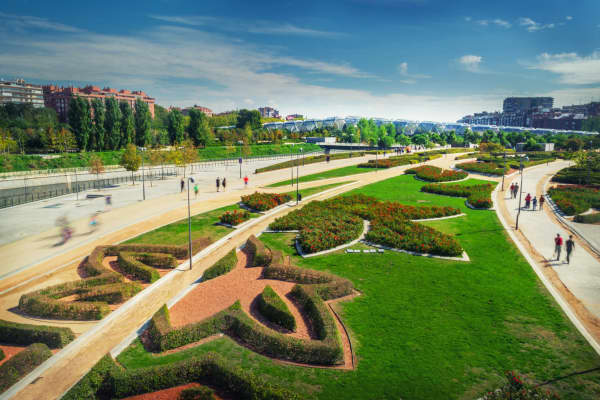
The best way to see any city is by bicycle and this is especially true of Madrid. Look up Madrid Bike Tours. Their 3 hour Essential Madrid Tour, covering 10 kilometres, features the city’s monuments, parks, gardens, including the Royal Palace, the Plaza Mayor, the Puerta del Sol and the Cathedral of Almudena. Of course, you can always just hop on your own bike and check out some of Madrid’s numerous cycling routes. Spain’s vías verdes programme has converted thousands of miles of disused train tracks into stunning cycle routes. There are four green ways in the Community of Madrid (the wider Madrid region), including the Gasolina Greenway, a short and easy ride to the north of Madrid that goes past the beautiful El Capricho park (well worth a stop). Another possible route is to take line nine of the Madrid Metro to Arganda del Rey and ride the Tajuña Greenway along the river of the same name. You will pass through pretty meadows and forests and past village churches.
Rest

Many of Madrid’s’s hotels welcome cyclists and will be able to offer storage rooms and bike racks – check before you book.
Campers can stay at Bungalows Camping Alpha, located just 12 km from Madrid’s city centre. It has a great view of the surrounding countryside, pool, wifi, washer/dryers, restaurant, bar, coffee shop and supermarket. If it is raining, cabins are also available to rent.
Eat, drink, relax

After a day of spinning past Madrid’s incredible sights, riders can head to the upcoming areas of Lavapiés and La Latina, located in the southern end of Madrid Centro. These cool, bohemian neighbourhoods are filled with art, music, and nightlife and home to Madrid’s best multiethnic dining, from Indian to Ethiopian. The Sunday market in La Latina is packed with antiques (and people) and a wander through the narrow streets can result in surprising discoveries like community gardens and trendy cafes. Stop in to try the tapas at Juana la Loca – maybe the smoked eel & hazelnut gratin millefeuilles with Iberic bacon? Or simply have a seat at the dozens of stalls in the Mercado de la Cebada and fill up on fresh seafood.
For a nightcap, cyclists should head to the Plaza Mayor and grab a seat at one of the outdoor patios overlooking the square. People-watching accompanied by wine, vermouth, Sangria, Jerez (sherry) or a balloon glass of gin & tonic is highly recommended. Those in search of a great view should seek out Azotea del Circulo. The rooftop bar atop a beautiful 1920’s building offers arguably the best viewpoint of Madrid, overlooking the Castellana and Plaza de Cibeles. Finally, for beer aficionados, there is Naturbier. Sit outside on the busy terrace and soak up the atmosphere of Plaza Santa Ana or find a spot in the bricked vaults underneath the square, which once belonged to an ancient church. Some of the tables even have beer taps from which you can pull your own pints.
The Trans-Europa in Madrid

The riders of the Trans-Europa convoy into Madrid arriving at the friendly and relaxed Hotel Reyes Catolicos. After enjoying the city’s charms, the riders convoy together out of the city until they reach the small town of Quijorno where they continue west on the way to their next rest day in Caceres. Be sure to check out our ‘Cyclist’s Guide for Caceres’ coming soon.
For more information on Madrid, please see 36 Hours in Madrid, Spain – New York Times.
Experience Madrid on the 2018 Trans-Europa Cycling Expedition.
Read all our previous posts in the series – Helsinki, Riga, Vilnius, Warsaw, Košice, Budapest, Ljubljana, Venice, Genoa, Cannes, Montpellier & Barcelona.
]]>This is the twelfth in our ongoing series of blogs highlighting the cities along the route of our Trans-Europa cycling tour. Each year we have brought our cyclists to these cities and have learned a few new useful tips for those who might be considering heading there. So whether you are thinking to join our tour or plan on cycling there yourself, we hope this information will be helpful.
Barcelona
“Barcelona is an enchanting seaside city with boundless culture, fabled architecture and a world-class drinking and dining scene.” – Lonely Planet
Infrastructure
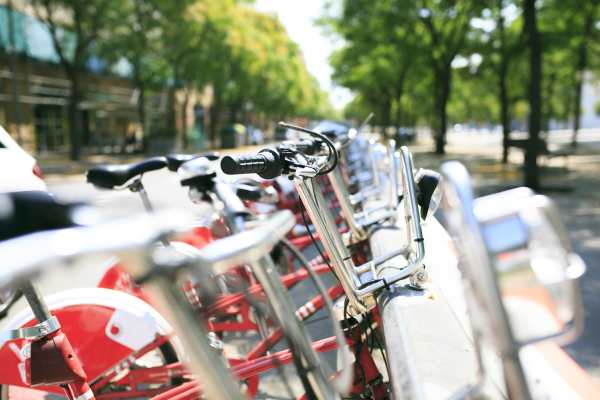
The city boasts over 200 km of bike lanes. You can download the map here. In 2017 Barcelona was rated #11 in the Copenhagenize list of the world’s most bicycle friendly cities.
In case your bike needs TLC or a day off, Barcelona has a bike share system – Bicing. The network consists of more than 420 stations and over 6000 bicycles. The stations are situated through most of the flat areas of the city with a distance of around 300 to 400 metres between each one. Many are situated next to public transport stops to allow for intermodal use. See the map here.
Barcelona has number of bicycle rental outlets. Bike Rental Barcelona‘s main station is located in the old city centre, just 100 meters off ‘Las Ramblas’ and the old port. This makes it a very convenient location to start and end your bike ride.
The city is conveniently located on the EuroVelo network – EuroVelo #8 – Mediterranean Route.
Support

Is your bicycle sounding a little off? Barcelona has a number of quality bike repair shops. Try Green Bikes. Their full-service bicycle repair shop is open for business from Monday to Friday from 10:00h – 20:00h & Saturdays from 12:00h – 20:00h. Sundays they are closed.
>>Learn more about our Trans-Europa bicycle tour that includes a rest day in Barcelona
Sightseeing
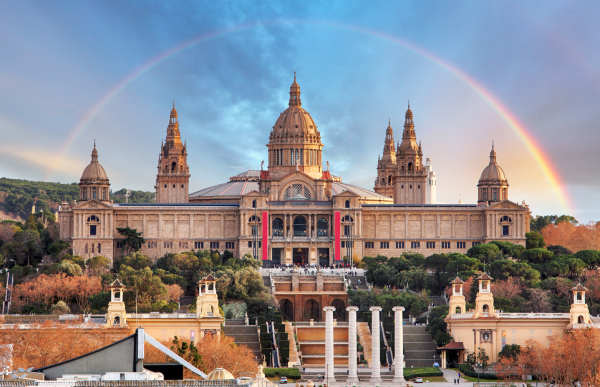
The best way to see any city is by bicycle and this is especially true of Barcelona. Bike Tours Barcelona offers a number of options from the basic City Tour to the Modernist Tour which takes riders to Antoni Gaudi’s most well known buildings – Sagrada Familia, La Pedrera, Casa Batlló, Casa Amatller, Palau de la Música. You can also join Barcelona by Bike for their Tapas ride or, if you are feeling lucky, their Surprise Tour.
Rest

Cyclists looking for bike friendly accommodations should pedal over to Bed & Bike Barcelona. Centrally located, they offer secure bike storage and bike rentals. Another option is The Bicycle Apartments. They are situated in a typical neighbourhood of Barcelona, close to Plaça Espanya, Magic Fountains, the Museum of Catalan Art, the Olympic stadium, the Joan Miró Foundation, the Fair Ground Montjuïc, the Cultural Center Caixa Forum, Sants Train Station and the Arena Shopping Centre. If you book online, they will give you a free 3 hour bike rental.
Campers can stay at the oldest campground in Spain – Camping Masnou – opened in 1956. It is located just 11 km northeast of Barcelona’s city centre with excellent public transit connections. There is a bar, a pool, the beach and a supermarket onsite.
Eat, drink, relax
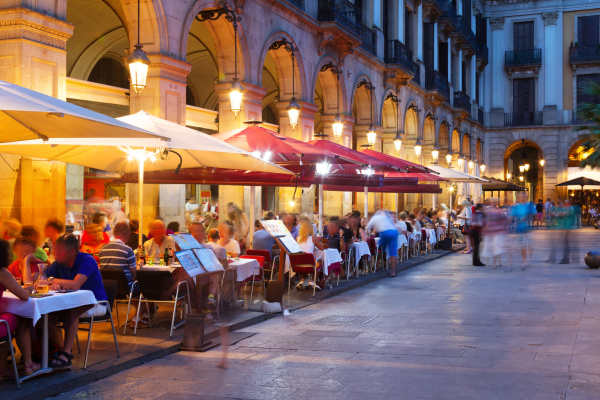
After a day of soaking up Barcelona’s charm on your bike, it might be a good idea to seek out a cold drink. If you know the password (Yes, I said password), you can try Speakeasy. Housed in Dry Martini’s warehouse with its own entrance on Corsica Street, it pays homage to the clandestine premises of the Prohibition period. Check out the drinks menu. Or try Las Cuevas del Sorte. Located down some mysterious stairs, hence the ‘cave’ in the name, this rustic bar invites guests into its cave of candles and stone walls.
Jump back on your bike and finish your day on one of Barcelona’s best patios. Santa Maria Barcelona is located a stone’s throw from Barceloneta Beach and features killer pizzas, fresh salads and delicious cocktails. Looking for incredible seafood to go with your view? Try La Barca del Salamanca. It features tradition recipes – Paellas, Fideuás and Arroceros Marineros. Their 11 paellas and rice dishes are famous for the quality of the ingredients. Highly recommended is the Mixed Paella with Black Rice and crayfish, monkfish, clams and prawns.
The Trans-Europa in Barcelona
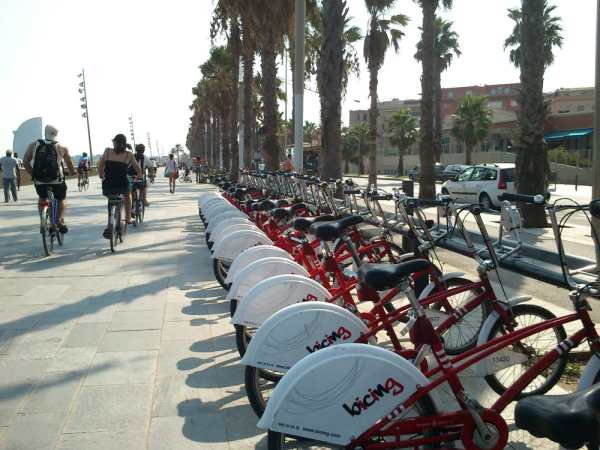
The riders of the Trans-Europa cycle into Barcelona in a convoy along some pretty busy roads until they encounter the city’s bike paths near the beach. They stay at the ibis Barcelona Plaza Glories 22 Hotel before heading out after a couple rest days. Leaving Barcelona is not easy. After an 18 km convoy the riders encounter some challenging navigation – lots of flagging tape and over 60 roundabouts – but have no fear, you will be well taken care of by our staff who are experienced in navigating these large cities by bike. At least it is relatively flat. The next day they turn west and head into the hills as they continue on the way to their next rest day in Madrid. Be sure to check out our ‘Cyclist’s Guide for Madrid’ coming soon.
For more information on Barcelona, please see 36 Hours in Barcelona, Spain – New York Times
Experience Barcelona on the 2018 Trans-Europa Cycling Expedition.
Read all our previous posts in the series – Helsinki, Riga, Vilnius, Warsaw, Košice, Budapest, Ljubljana, Venice, Genoa, Cannes & Montpellier.
]]>This is the eleventh in our ongoing series of blogs highlighting the cities along the route of our Trans-Europa cycling tour. Each year we have brought our cyclists to these cities and have learned a few new useful tips for those who might be considering heading there. So whether you are thinking to join our tour or plan on cycling there yourself, we hope this information will be helpful.
Montpellier
“Graceful and easy-going, Montpellier is a stylish metropolis with elegant buildings, grand hôtels particuliers (private mansions), stately boulevards and shady backstreets, with gorgeous white-sand beaches on its doorstep.” – Lonely Planet
Infrastructure
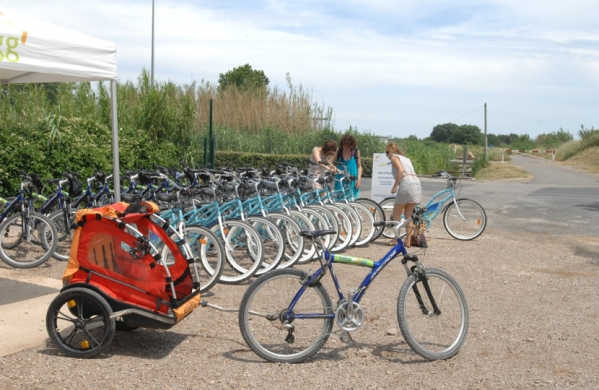
Montpellier boasts 158 km of bike paths, with another 100 km on the way, and the city provides a detailed map of them for cyclists to use.
In case your bike needs TLC or a day off, Montpellier has a bike share system – Velomagg. It features 56 automatic bike stations with over 2,000 bicycles available in the Montpellier and Agglomération area. Service is open 24/7. Montpellier has number of bicycle rental outlets. Try W – City & Bike for some great rates.
Support

Is your bicycle sounding a little off? Montpellier has a number of quality bike repair shops. Try Winbike for a wide variety of repair services.
>>Learn more about our Trans-Europa bicycle tour that includes a rest day in Montpellier
Sightseeing
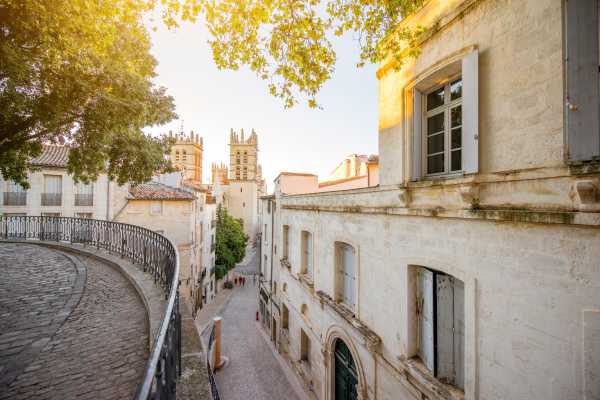
The best way to see any city is by bicycle and this is especially true of Montpellier. Urban Bike offers some unique ways to explore the city. See Montpellier by night, through its street art or combine your bike ride with a pedal boat, a paddle board or a tow tube. You can also just spin around on your own. The Mediterranean beaches are 10 km in one direction and a selection of vineyards is 5 km in the other.
Rest

Cyclists looking for bike friendly accommodations should head to the charming Hotel du Palais. There are just over two dozen en suite bedrooms, a secure bike store and free wifi.
Campers can head to Camping Plein Air des Chênes. Just a few minutes from the city centre, it features a snack bar, laundromat, beach shuttle, wifi and a number of swimming pools. If they prefer the beach, they can try Camping Montpellier Plage, just 50 m from the Mediterranean Sea.
Eat, drink, relax
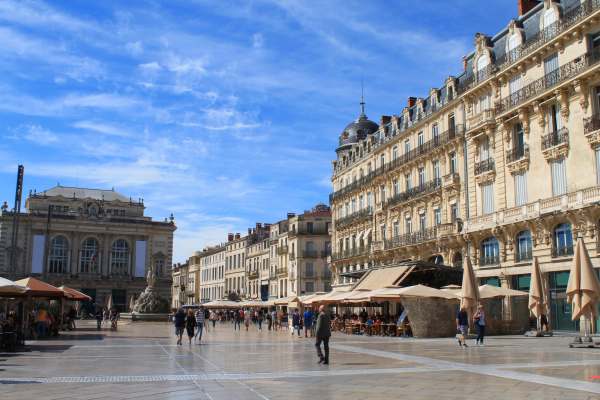
After a day of cycling to the beaches, to the vineyards or perhaps to the magical Jardin des Plantes, France’s oldest botanical garden (founded in 1593), it is time to enjoy a bite to eat. Fans of Gordon Ramsey will enjoy tasting the food at Tamarillos, prepared under the watchful eye of Chef Philippe Chapon who taught the young Mr Ramsey a thing or two about pastry cooking during his time at Guy Savoy in Paris. Be sure to enjoy a dessert as Chef Chapon is a “double champion de France de dessert’.
For a nightcap, riders can head to Rebuffy, located just on the edges of the old medieval town. It features a wonderful terrace, cheap wine and a welcoming atmosphere. If they want beer, look no further than Couleurs de Bieres. Its selection of over 800 bottles is one of the best in France. Finally, if the riders want to indulge their inner pirate, they should climb aboard the Barberousse, a pirate themed drinking hole but keep in mind, as one patron pointed out, “If you like sitting in a bar that feels like a closed attraction of Pirates of the Caribbean, and pay 5 Euro in the Happy Hour for a cocktail with 0,25 – then this is your shop. Everyone else goes to one of the countless good bars in Montpellier.”
The Trans-Europa in Montpellier
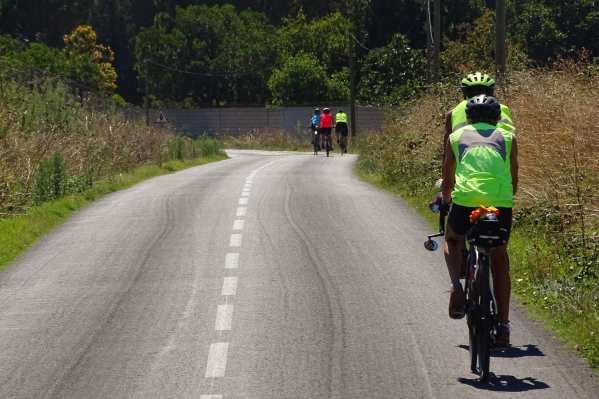
The riders of the Trans-Europa cycle into Montpellier after a longish 120 km day. They stay at the friendly Kyriad Hotel Montpellier which has secure bike storage. The riders head out after a rest day for a short 5 km convoy before heading to the coast where they pass through some scenic wetlands. They should keep their eyes open for possible flamingo sightings as they continue on the way to their next rest day in Barcelona. Be sure to check out our ‘Cyclist’s Guide for Barcelona’ coming soon.
For more information on Montpellier, please see 36 Hours in Montpellier, France – New York Times
Experience Montpellier on the 2018 Trans-Europa Cycling Expedition.
Read all our previous posts in the series – Helsinki, Riga, Vilnius, Warsaw, Košice, Budapest, Ljubljana, Venice, Genoa & Cannes.
]]>This is the tenth in our ongoing series of blogs highlighting the cities along the route of our Trans-Europa cycling tour. Each year we have brought our cyclists to these cities and have learned a few new useful tips for those who might be considering heading there. So whether you are thinking to join our tour or plan on cycling there yourself, we hope this information will be helpful.
Cannes
“With its marinas full of white megayachts and waterfront streets abuzz with Ferraris and Mercedeses, the glittery French Riviera resort at first gives off the rarefied vibe of a town where huffing around on foot must surely offend local mores and offer glaring proof of D-List status.” – Seth Sherwood, NYT, April 18, 2013
Infrastructure
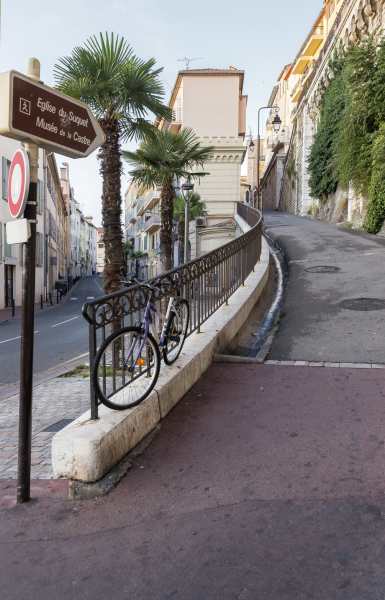
Cannes currently does not have a bike share programme (the nearest one is 30 km away in Nice) but does have some limited bike lanes and paths The nicest one runs along the waterfront/beach. Parcours de La Croisette is the best section, running for 4.5 km, and features Palm Beach, the Casino de la Pointe Croisette, and the Cannes Port, to the Tourist Office. The area is famous for the Palais des Festivals et des Congrès, site of the Cannes Film Festival, and the area has many expensive shops, restaurants, and hotels. The second part of the path goes along the Boulevard du Midi, for nearly 7 km, terminating at the Pullman Royal Casino near the airport and Plage.
In case your bike needs TLC or a day off, Cannes has a number of bicycle rental outlets. Try Vélo Cannes or rent a beach cruiser from YouRent Cannes. If you are feeling flush, the latter also offers yacht rentals.
Support

Is your bicycle sounding a little off? Cannes has a number of quality bike repair shops. Try the highly rated RS Cycles Cannes.
>>Learn more about our Trans-Europa bicycle tour that includes a rest day in Cannes
Sightseeing
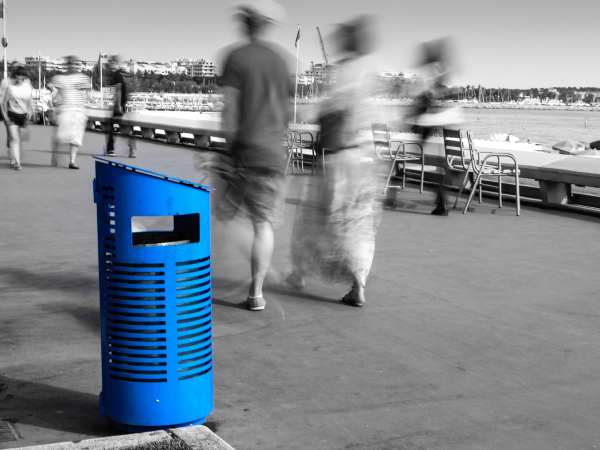
Cannes does not have any bike tour companies so riders will just have to explore the city on their own. Another option is to hop on one of the many daily trains to Nice. There they can spend 3 hours on the Nice City Cycle Tour – “From the stunning beaches and eye-catching parks to the grand streets and majestic plazas; from the super-cool bars and bistros to the winding medieval alleyways; from hidden Baroque churches to awe-inspiring Belle Époque palaces.”
Rest

Many of Cannes’s hotels welcome cyclists and will be able to offer storage rooms and bike racks – check before you book.
Campers can head to Parc Bellevue located about 6 km northwest of the city centre. It features camping, mobile homes and a swimming pool.
Eat, drink, relax
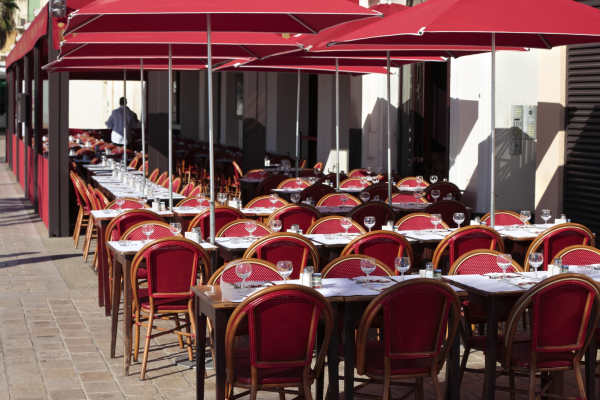
After cycling along La Croisette, riders may want to take a break, stopping in for some of the country’s best seafood at Astoux et Brun. For over 60 years 3 generations of the same family have offered up an incredible selection of oysters, scallops, mussels and fresh fish. Prefer something casual? Grab some supplies at the daily food market in Place Gambetta and picnic in the Square Lord Brougham, next to the Vieux Port.
Cyclists can round off their day with a Pastis Provençal, which incorporates ingredients from more than 60 plants in the surrounding Provence region, at La Cercle Bar. This is the city’s oldest bar and enjoys beautiful sea views from their garden. Riders looking for something a little different and quirky can head to Charly’s Bar – revel in the soft purple lighting and palm tree decor and choose a beverage from their drink list – ‘extremely enriched with the best cocktails, wines & champagnes‘.
The Trans-Europa in Cannes
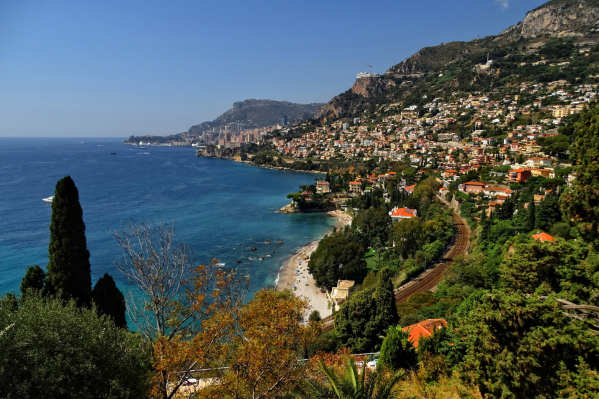
The riders of the Trans-Europa cycle into Cannes from the east on some very crowded roads (“crazy amount of people, cars, parked cars, dogs, and anything else you can imagine“) before pulling up to the centrally located Ibis Centre Cannes. The riders head out after a rest day, enjoying some spectacular views for the first 20 km on the way to their next rest day in Montpellier. Be sure to check out our ‘Cyclist’s Guide for Montpellier’ coming soon.
For more information on Cannes, please see 36 Hours in Cannes, France – New York Times
Experience Cannes on the 2018 Trans-Europa Cycling Expedition.
Read all our previous posts in the series – Helsinki, Riga, Vilnius, Warsaw, Košice, Budapest, Ljubljana, Venice & Genoa.
]]>This is the ninth in our ongoing series of blogs highlighting the cities along the route of our Trans-Europa cycling tour. Each year we have brought our cyclists to these cities and have learned a few new useful tips for those who might be considering heading there. So whether you are thinking to join our tour or plan on cycling there yourself, we hope this information will be helpful.
Note: While most of the cities we have covered so far have made an effort to encourage cycling in their city, Genoa seems to be a little behind the times in this respect!
Genoa
“Italy’s largest sea port is indefatigably contradictory, full at once of grandeur, squalor, sparkling light and deep shade.” – Lonely Planet
Infrastructure
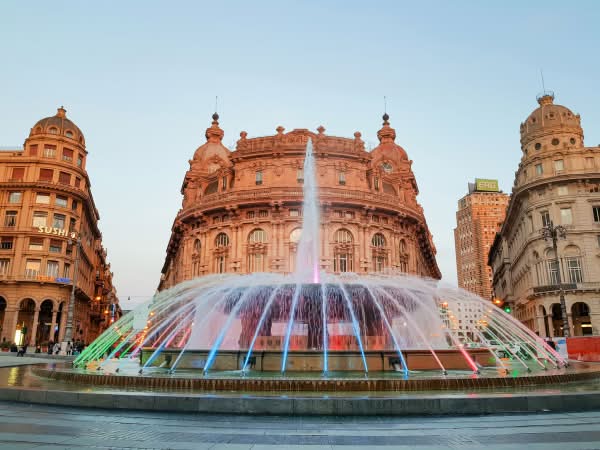
Genoa does not yet have a bike-sharing option.
In case your bike needs TLC or a day off, Genoa has a very limited number of bike rentals options. You could try Monte Gazzo.
Support

Is your bicycle sounding a little off? There are a few bike repair shops. Try the services of Cocchi Cicli.
>>Learn more about our Trans-Europa bicycle tour that includes a rest day in Genoa
Sightseeing
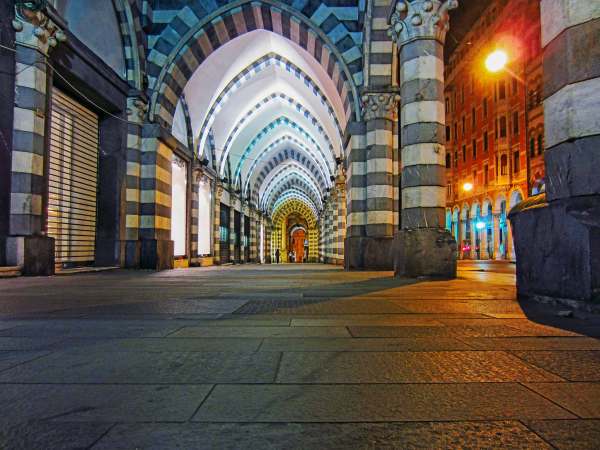
The best way to explore Genoa is by bicycle. Unfortunately, there are not any organized cycling tours (unless you count e-bikes). Cyclists can try MapmyRide or BikeMap to view some local possibilities.
Rest

Genoa’s does not have any specific ‘bicycle friendly’ hotels but Starhotels President Genoa is used to accommodating the cyclists of the Trans-Europa.
Campers can head to Camping Villa Doria, the closest campsite to the centre of Genoa (13 km).
Eat, drink, relax
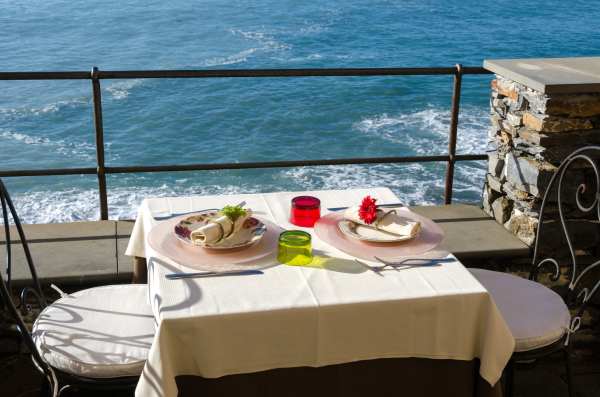
After spending the day tackling Genoa’s hills and exploring the city’s amazing Palazzi dei Rolli, cyclists may want to grab a bite at the Trattoria dell’Acciughetta, known for its typical local Ligurian fish and seafood dishes, particularly centred on blue-tailed fish, known in Italy as ‘the bread of the sea’. They also serve up distinct dishes like trofie pasta all’Acciughetta, anchovie soup and the famous Italian frittata with mixed fish.
As the sun begins to slip below the horizon, a visit to the Estoril Beach Club is highly recommended. A combination of a restaurant, pizzeria, beach club and night club, it has a terrace with a wonderful view of the Ligurian Coast.
The Trans-Europa in Genoa
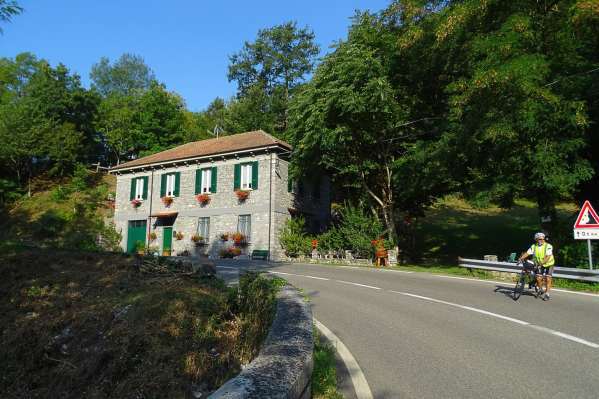
The riders of the Trans-Europa cycle into Genoa along a fairly busy road before arriving at the friendly Starhotels President Genoa. Leaving the city, the riders follow a gorgeous coastal road, described by the Tour Leader in 2016 as an ‘eye catching’ day, heading west towards their next rest day in Cannes. Be sure to check out our ‘Cyclist’s Guide for Cannes’ coming soon.
For more information on Genoa, please see 36 Hours in Genoa, Italy – New York Times
Experience Genoa on the 2018 Trans-Europa Cycling Expedition.
Read all our previous posts in the series – Helsinki, Riga, Vilnius, Warsaw, Košice, Budapest, Ljubljana & Venice.
]]>